This website uses cookies to ensure you get the best experience on our website. Learn more


Information on how to stay safe and healthy abroad. About us.
- Destinations
- Asia (Central)
- Asia (East)
- Australasia & Pacific
- Central America
- Europe & Russia
- Middle East
- North America
- South America & Antarctica
United Republic of Tanzania (Africa)
Advice for all destinations.
Read the information on the COVID-19: Health Considerations for Travel page for advice on travelling during the COVID-19 pandemic.
Vaccinations and malaria risk
Review both the Vaccination and Malaria sections on this page to find out if you may need vaccines and/or a malaria risk assessment before you travel to this country.
If you think you require vaccines and/or malaria risk assessment, you should make an appointment with a travel health professional:
- How to make an appointment with a travel health professional
A travel health risk assessment is also advisable for some people, even when vaccines or malaria tablets are not required.
- Do I need a travel health risk assessment?
Risk prevention advice
Many of the health risks experienced by travellers cannot be prevented by vaccines and other measures need to be taken.
Always make sure you understand the wider risks at your destination and take precautions, including:
- food and water safety
- accident prevention
- avoiding insect bites
- preventing and treating animal bites
- respiratory hygiene
- hand hygiene
Our advice section gives detailed information on minimising specific health risks abroad:
- Travel Health Advice A-Z
Other health considerations
Make sure you have travel insurance before travel to cover healthcare abroad.
Find out if there are any restrictions you need to consider if you are travelling with medicines .
Know how to access healthcare at your destination: see the GOV.UK English speaking doctors and medical facilities: worldwide list
If you feel unwell on your return home from travelling abroad, always seek advice from a healthcare professional and let them know your travel history.
Vaccinations
- Confirm primary courses and boosters are up to date as recommended for life in Britain - including for example, seasonal flu vaccine (if indicated), MMR , vaccines required for occupational risk of exposure, lifestyle risks and underlying medical conditions.
- Courses or boosters usually advised: Hepatitis A; Poliomyelitis; Tetanus.
- Other vaccines to consider: Diphtheria; Hepatitis B; Meningococcal Meningitis; Rabies; Typhoid.
- Selectively advised vaccines - only for those individuals at highest risk: Cholera; Yellow Fever.
Yellow fever vaccination certificate required for travellers aged 1 year or over arriving from countries with risk of yellow fever transmission and for travellers having transited for more than 12 hours through an airport of a country with risk of yellow fever transmission.
Notes on the diseases mentioned above
Risk is higher during floods and after natural disasters, in areas with very poor sanitation and lack of clean drinking water.
- Diphtheria : spread person to person through respiratory droplets. Risk is higher if mixing with locals in poor, overcrowded living conditions.
Risk is higher where personal hygiene and sanitation is poor.
Risk is higher for long stays, frequent travel and for children (exposed through cuts and scratches), those who may require medical treatment during travel.
- Meningococcal Meningitis : spread by droplet infection through close person to person contact. Meningococcal disease is found worldwide but epidemics may occur within this country, particularly during the dry season. Risk is higher for those mixing with locals for extended periods.
- Tetanus : spread through contamination of cuts, burns and wounds with tetanus spores. Spores are found in soil worldwide. A total of 5 doses of tetanus vaccine are recommended for life in the UK. Boosters are usually recommended in a country or situation where the correct treatment of an injury may not be readily available.
- Typhoid : spread mainly through consumption of contaminated food and drink. Risk is higher where access to adequate sanitation and safe water is limited.
- Yellow Fever : spread by the bite of an infected, day-biting mosquito. The disease is mainly found in rural areas of affected countries but outbreaks in urban areas do occur. Vaccination is usually recommended for all those who travel into risk areas. (View yellow fever risk areas here), and areas where there is an outbreak ongoing (check the 'news' section for outbreaks). In addition, certain countries may want to see proof of vaccination on an official yellow fever vaccination certificate - check above under Immunisations .
Malaria is a serious and sometimes fatal disease transmitted by mosquitoes.You cannot be vaccinated against malaria.
Malaria precautions
- Malaria risk is high throughout the year in all areas below 1800m.
- Malaria precautions are essential Avoid mosquito bites by covering up with clothing such as long sleeves and long trousers especially after sunset, using insect repellents on exposed skin and, when necessary, sleeping under a mosquito net.
- Check with your doctor or nurse about suitable antimalarial tablets.
- See malaria map – additional information can be found by clicking on the Regional Information icon below the map.
- High risk areas: atovaquone/proguanil OR doxycycline OR mefloquine is usually advised.
- If you have been travelling in a malarious area and develop a fever seek medical attention promptly. Remember malaria can develop even up to one year after exposure.
- If travelling to an area remote from medical facilities, carrying standby emergency treatment for malaria may be considered.
Other Health Risks
Altitude and travel, dengue fever, schistosomiasis.
There is a risk of exposure to coronavirus (COVID-19) in this country.
Please be aware that the risk of COVID-19 in this country may change at short notice and also consider your risk of exposure in any transit countries and from travelling itself.
- The 'News' section on this page will advise if significant case increases or outbreaks have occurred in this country.
Prior to travel, you should:
- Check the latest government guidance on the FCDO Foreign travel advice and country specific pages for travel to this country and the rules for entering the UK on return.
- Ensure you are up to date with UK recommendations on COVID-19 vaccination.
- You can check this in the FAQ's.
- If you are at increased risk of severe COVID-19 you should carefully consider your travel plans and consider seeking medical advice prior to making any decisions.
For further information, see Coronavirus disease (COVID-19) and COVID-19: Health Considerations for Travel pages.
Polio Vaccination Exit Recommendations
If you are visiting this country for longer than 4 weeks, you may be advised to have a booster dose of a polio-containing vaccine if you have not had one in the past 12 months. You should carry proof of having had this vaccination. Please speak to a travel health professional to discuss.
Zika Virus Infection
This country has been categorised as having a risk of Zika (ZIKV) virus transmission.
ZIKV is mainly spread through mosquito bites. The mosquito responsible most commonly bites during daylight hours and is common in towns and cities.
The illness is usually mild but infection during pregnancy may lead to babies being born with birth defects. There is no vaccine currently available against ZIKV.
Advice for All Travellers
You should practice strict mosquito bite avoidance at all times. Do not travel without adequate travel insurance . Seek pre-travel health advice from a travel health professional 6 to 8 weeks in advance of travel.
Additional recommendations for pregnant travellers or those planning pregnancy
If you are planning pregnancy in the very near future you should consider whether you should avoid travel to this country.
- contact your GP, obstetrician or midwife for further advice, even if you have not been unwell or had any symptoms of ZIKV infection
- use barrier methods of contraception during and after travel and for the duration of your pregnancy, even in you have not been unwell or had any symptoms of ZIKV infection
- If you develop symptoms of ZIKV infection, it is recommended that you avoid becoming pregnant for a further 2 months following your recovery
- 2 months afterwards if you are female
- 3 months afterwards if you are male or if both partners travelled
These measures reduce the chance of sexual transmission of ZIKV and/or the risk of ZIKV infection in pregnancy.
For further information, see Zika virus infection page.
- 27 May 2024 - Cholera in Africa: Update 1
- 23 May 2024 - Advice on Dengue Fever if Travelling Abroad
- 67 additional items in the news archive for this country
back to top
- Search Please fill out this field.
- Manage Your Subscription
- Give a Gift Subscription
- Newsletters
- Sweepstakes
- Island Vacations
How to Enjoy the Charms of Zanzibar, According to a Travel + Leisure A-List Advisor
With delicious food markets, stunning beaches, and a UNESCO World Heritage Site, Zanzibar is an island destination with universal appeal.
Darren Humphreys is a native South African and the founder of Travel Sommelier, a travel company that designs custom itineraries for a sophisticated clientele. Darren gives insider advice on food, beaches, and sites to see in his articles for Travel + Leisure .
Zanzibar, an island off the coast of Tanzania in East Africa, is a unique crossroad of cultures. Disparate influences, like Swahili, Arabian, European and Asian all combine to deliver a heady mix of sights, sounds, and fragrances. The island is renowned as the birthplace of Farrokh Bulsara (aka Freddie Mercury) and has long been the culinary epicenter of the Indian Ocean and the Spice Islands .
As a travel specialist in East African safari and culinary trips, Zanzibar has long been one of my favorite destinations, and I recently returned from my latest visit with a renewed sense of appreciation. Here are my suggestions for how to experience the island's history, cuisine, arts and culture, and stunning scenery.
Start in Historic Stone Town
A visit to Zanzibar commences in Stone Town, a UNESCO World Heritage Site . The city delivers a startling sense of place—it is a town to truly get lost in, a town of rooftops and alleyways. Commencing the day in the city's old quarter delivers historical context. From the ancient slave market to the Sultan's Palace, the House of Wonders, and The Old Dispensary, there is much history to absorb.
The city is just six degrees from the equator and has an enviably warm year round climate. Fresh Madafu—coconut water poured directly from just picked coconuts— keeps the heat at bay. The markets include a staggering array of offerings, like spices, fish, meat, produce, juices and coffee.
Make your home base the Emerson Spice Hotel , a restored merchant's house.
Embark on a Culinary Tour
Culinary experiences are a highlight, starting with a progressive lunch. First up is Lukmaan restaurant. Enjoy fresh frilled prawns and octopus over Kachumbari salad, while sitting beneath the vast courtyard boabab tree—a quintessential Zanzibar experience.
Not to be missed is the ginger-lime-sugarcane juice vendor as you exit the restaurant. This ice cold beverage sustains you through alleyways lined with antique doors and ancient facades, until you come upon one of the finest food cart vendors I have ever encountered.
On offer is Urojo, a turmeric-based soup with chickpea falafel, sweet potato balls, cassava chips, egg, crispy onions, sweet and sour spices, and more. The result is a mouthwatering dish I like to call "Zanzibar in a Bowl."
South African wines are a perfect complement to these eclectic dishes. There is a diverse offering on the island, and there is no better way to sample them than to board a traditional dhow bound for a sand bar offering a panoramic view of Stone Town, especially if a visiting winemaker happens to be curating the tasting.
As evening draws near, rooftop vantage points in Stone Town are unrivaled: gaze at the Indian Ocean and hover above a sea of corrugated iron rooftops and captivating architecture. The Emerson Huzumi rooftop provides an opportunity to remove shoes, settle on a floor cushion and enjoy Swahili cuisine and local music.
An after-dinner aperitif is best enjoyed in the Secret Garden at Emerson Spice, so atmospheric I half expected Humphrey Bogart to emerge from the shadows.
Consider an Agricultural Day-Trip
The pace slows markedly upon leaving Stone Town. One rite of passage is to visit a community-owned spice farm. A walking tour is immersive and educational as you taste all manner of roots, shoots, and vegetation, plus familiar spices like cinnamon, ginger, nutmeg, turmeric, and cloves.
I also visited a bivalve and fin-fish hatchery, to learn about how overfishing has impacted local marine ecosystems and the hatchery's plan to reinvigorate the waters.
Explore the Beaches and Art Scene
Some of the most magical facets of the island are showcased on its beaches, whether it is the Robinson Crusoe-esque Mnemba private island or the ultra refined Xanadu retreat , where Zanzibar cuisine is taken to a new level altogether.
Days can be spent learning to kite surf, planning whale shark diving excursions to adjacent Mafia Island or enjoying the shimmering turquoise sea where the water temperature seldom dips below 80 degrees.
When not at the beach, explore the robust traditional and contemporary art scene. Zanzibar is ground zero for bohemian chic: vibrant textiles, ornately carved doors and frames, and tanzanite jewelry in all forms.
The CAGZ Arts Gallery is a must-visit. This is an artist-in-residence program that arranges exhibitions and visits to workshops and studios, rather than an expansive standalone gallery. I love this concept because you get to meet artists, and see finished pieces alongside works in progress.
Remember: However You Like to Travel, Zanzibar Has It All
The great appeal of Zanzibar is that it can be enjoyed in so many ways: as an addendum to an East African safari in Tanzania or Kenya; as a standalone destination to enjoy unique gastronomy and barefoot beach luxury; or as a remote work-cation destination for digital nomads (broadband is fast and cell service is ubiquitous).
Zanzibar will leave an indelible mark on you, not only from the intricate henna tattoo you are likely to get, but because it has a rhythm and sway all of its own, and tastes and flavors so unique you will pine to return.
Travel + Leisure A-List member Darren Humphreys , of Travel Sommelier , designs combination East African safari and culinary trips to Kenya, Tanzania, Rwanda and Zanzibar.
Related Articles
It remains impossible not to be enchanted as you approach from the air, looking down on sparkling turquoise waters, darkened only by patch reefs, and punctuated by the billowing triangular white sails of passing dhows. Chris and Susie McIntyre , authors of Zanzibar: The Bradt Guide
Zanzibar is one of our hot destinations for the year ahead – check out the full list of the best places to travel in 2024 here .
Zanzibar is a magical, evocative African name, like Timbuktu, Casablanca or Kilimanjaro. For many travellers, the name alone is reason enough to come. Yet although expectations run high, awareness of the reality on Zanzibar and its neighbouring islands is often rather hazy.
For many, the islands offer a quintessential Indian Ocean experience: palm-lined stretches of powder-white coral sand line the coast for miles, while below the waves, reef fish flit among colourful coral gardens, overshadowed only by the occasional pelagic looming out of the blue. From the nesting turtles on Juani to the whale sharks seen annually off Mafia, there is always something unexpected awaiting the diver and snorkeller. On land, too, these islands can enthral. Kirk’s red colobus monkeys can be seen in the forest, Arabian architecture provides an exotic urban backdrop, and village life remains steeped in tradition.
Our message is clear: don’t discount the less well-known areas of Zanzibar, Pemba Island or the Mafia Archipelago. And for some of the best experiences, get off the beaten track, ideally with knowledgeable residents. Your choices will make a difference not only to your stay, but also to the communities that you encounter.
Food and drink in Zanzibar
Restaurants.
In Zanzibar Town, and increasingly most other main resort areas, there are several good restaurants catering specifically for visitors, specialising in local dishes, seafood or curries; mains usually cost between US$7 and US$15, but there are also smarter restaurants, where prices are a little higher, and restaurants where less-elaborate meals and snacks cost around US$5–7.
In Zanzibar Town and other urban conglomerations there are also some small eating-houses that cater mainly to local people, where you can eat for around US$2–3. They usually only have one or two types of food available, such as stew and rice, but they also serve chapattis, samosas and other snacks.
Cafés and bars
In Zanzibar Town, many places serve drinks as well as food, although at busy times you may be required to buy a meal rather than have a drink on its own. You can buy international and Tanzanian brands of fizzy drink, plus local and imported beers. Prices vary greatly according to where you drink: a bottle of Coke from a shop or small backstreet café costs US$1, but may cost four times this in a smarter café or restaurant. A bottle of local beer (including Safari, Tusker or Kilimanjaro) costs US$1.50 in a local bar, and at least double this in smarter places.
At larger hotels and restaurants in Zanzibar Town or on the coast you can also buy imported beers, wines (mostly from South Africa) and spirits.
Self-catering
If you plan to provide for yourself in Zanzibar Town, there are several shops selling locally produced bread and cakes, plus a reasonable choice of food in tins and packets imported from Kenya and beyond. Zanzibar Town has a market that’s good for fruit and vegetables, plus fresh meat and fish if you have a means of cooking it. Other towns have small markets where you can buy meat, fish, fruit and vegetables, and shops with a limited but adequate supply of tinned food.
Health and safety in Zanzibar
People new to exotic travel often worry about tropical diseases, but it is accidents that are most likely to carry you off. Road accidents are very common in many parts of Zanzibar so be aware and do what you can to reduce risks: try to travel during daylight hours, always wear a seatbelt and refuse to be driven by anyone who has been drinking. Listen to local advice about any areas where crime is an issue.
When travelling around Zanzibar or East Africa, the different climatic and social conditions mean visitors are exposed to diseases not normally encountered at home. Although you will likely have received all the vaccinations recommended, this does not mean you will be free of all illness during your travels: certain precautions still have to be taken. You should read a good book on travel medicine and be aware of the causes, symptoms and treatments of the more serious diseases. But don’t let this put you off – with a little care and attention most of these illnesses can be avoided.
Diseases and vaccinations
Make sure all your immunisations are up to date. Officially, proof of vaccination against yellow fever is only needed for entry into Zanzibar if you are coming from another yellow fever endemic area, but the Zanzibari authorities have been known to request proof of vaccination for visitors coming from Tanzania – which effectively incorporates most visitors.
It’s also reckless to travel in the tropics without being up to date on tetanus, polio and diphtheria (now given as an all-in-one vaccine, Revaxis) and hepatitis A. Immunisation against typhoid, hepatitis B and rabies may also be recommended.
The biggest health threat is malaria. This potentially fatal mosquito-borne disease has largely been eradicated from Zanzibar and Pemba in recent years, thanks to the widespread use of insecticide-treated nets and indoor spraying, and the prevalence stood at an all-time low of less than 1%. Despite this, the amount of human traffic between the mainland and the islands means that it has not been eliminated entirely, and visitors should take all precautions against it.
Though advised for everyone, a pre-exposure rabies vaccination, involving three doses taken over a minimum of 21 days, is particularly important if you intend to have contact with animals, or are likely to be 24 hours away from medical help.
As in most countries, crime on these islands is gradually on the increase. Similarly, problems tend to occur with greater frequency in the cities and tourist heartlands than in the rural areas. Perhaps inevitably, the juxtaposition of relatively wealthy tourists and a high density of relatively poor local people causes envy and leads to the occasional crime.
Zanzibar Town is notorious for opportunist pickpockets, and occasionally tourists do have bags and cameras snatched while walking around the narrow streets of Stone Town. There have also been robberies on some of the beaches around Zanzibar Town; it is better not to go there alone, especially at night. The authors have yet to hear of any crime problems on Mafia Island – but this is a small, rural island with a low population density.
You can reduce the chances of having anything stolen by not displaying your wealth. Don’t bring valuable jewellery to these islands; leave it at home. Keep your valuables secure, out of sight and preferably back in the safe at your hotel. Keep most of your money there too, and do not peel off notes from a huge wad for every small purchase. Wandering around the town with an expensive camera casually slung over your shoulder or a state-of-the-art iPhone is insensitive and simply asking for trouble. A simple, dull-looking bag is much safer than something smart or fashionable.
Islamic terrorist groups are present in East Africa, and to a varying degree, pose a threat across the entire region. In Zanzibar specifically, there were two explosions in Zanzibar Town in 2013. There was also a bomb attack near a mosque in Stone Town in June 2014, which killed one person and injured several others. No such incident has occurred since.
With the rise of global terrorism, some travellers have looked nervously towards East Africa, but the truth is that the large Islamic communities on the islands are generally very peaceful, though they probably have their extremist elements, very much like the extremists who live in communities in the UK, Europe and the USA. So whilst Zanzibar has many factors that may cause initial concern, at the time of writing the British Foreign and Commonwealth Office do not cite the risk from terrorism as higher than in Western Europe or the USA.
When to visit Zanzibar
The best time to visit the islands of Zanzibar is during the dry seasons – December to February and June to October – but generally speaking, from December to February any wind comes from the northeast, so beaches on the southern and western parts of the islands are more sheltered. Conversely, from June to October it tends to come from the southwest, so northern and eastern coasts are best. Ultimately, however, these islands are at the mercy of the ocean and their weather patterns can be unpredictable at any time of year. Even during the ‘dry’ seasons, afternoon showers are not unknown, although they tend to be short and pleasantly cooling.
It is also possible to visit during the rainy season, when there are fewer visitors and you’re more likely to get good bargains from lodges and hotels (the ones that remain open) and trips. The rain can be heavy, but is not usually constant; the sunsets can be particularly magnificent; and pineapples are in season! Travel can be trickier, with roads damaged and buses delayed, but you’ll get there eventually.
The climate of Zanzibar is dominated by the movements of the Indian Ocean monsoons, and characterised by wet and dry seasons. The northeast monsoon winds (known locally as the kaskazi ) blow from November/December to February/ March, and the southwest monsoon winds (the kusi ) blow from June to September/ October. The main rains (the masika ) fall from mid-March to the end of May, and there is a short rainy season (the vuli ) in November.
Throughout the year, humidity is generally quite high (less so in the rainy season), although this can be relieved by winds and sea breezes. Temperatures do not vary greatly throughout the year, with daytime averages around 26°C (80°F) on Zanzibar Island from June to October, and around 28°C from December to February, although in this latter period the humidity is often higher, so temperatures feel hotter. Pemba tends to be cooler and gets slightly more rain than Zanzibar Island.
Festivals and public holidays
At holiday times, such as Christmas and Easter, the islands are popular with expats from Dar es Salaam and Nairobi as well as overseas visitors. Expect full flights and higher hotel rates. Conversely, during the Islamic fasting period of Ramadan, many restaurants and shops are closed during the day, and life runs at a generally slower pace. Sports fans may like to tie in their visit with the Zanzibar International Marathon, held every year in early November.
The islands share most public holidays with the rest of Tanzania. Offices and businesses are usually closed on these days, although some tour companies remain open. Public holidays with fixed dates include:
- 1 January – New Year
- 12 January – Mapinduzi ‘Revolution’ Day
- 7 April – Sheikh Abeid Amani Karume Day
- 26 April – Union Day: Zanzibar and Tanganyika
- 1 May – Workers’ Day
- 7 July – Saba Saba (Seven Seven)
- 8 August – Peasants’ and Farmers’ Day
- 14 October – Nyerere Day
- 9 December – Independence Day
- 25 December – Christmas Day
- 26 December – Boxing Day
The Muslim feasts of Idd il Fitri – the end of Ramadan – and Idd il Maulidi (also called Maulidi ya Mfunguo Sita) – Muhammad’s birthday – are celebrated by many people and are effectively public holidays. Dates of these holidays depend on the lunar calendar, and fall 11 or 12 days earlier every year. Approximate dates for Ramadan for the next few years are as follows: 3 April to 1 May 2022; 23 March to 21 April 2023; 10 March to 8 April 2024.
What to see and do in Zanzibar
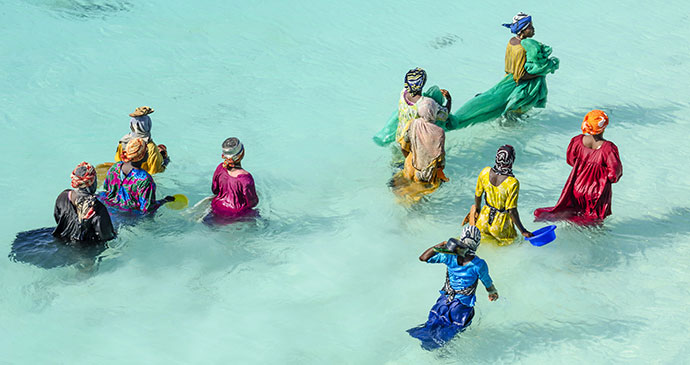
Jambiani Cultural Tour
The sprawling, linear coastal village of Jambiani consists of four amalgamated communities beginning a few kilometres south of Paje, spreading for about 6km down the coast towards Ras Shungi.
The village’s name comes from the Arabic word jambiya : a dagger with a markedly curved blade. Local legend holds that early settlers found such a knife here; proof that others had been in the area before them. It emits an active community spirit; Jambiani is probably the best place on the island to gain genuine insights into Zanzibari village life and enjoy rewarding community interaction.
If you want a change from the beach and water, the excellent Eco+Culture village tour, guided by resident Ramadhan Issa offers probably the island’s best insight into genuine rural life. The tours last anything from a few hours to the best part of a day (depending on your enthusiasm and heat tolerance), and take in many aspects of everyday life. Spend time helping the women make coconut paste, reciting the alphabet in unison at the efficient kindergarten and meeting the mganga (traditional healer). Ramadhan’s presence, reputation within the community and ability to translate allow for genuine interaction with the Jambiani residents and a thoroughly engaging time.
A percentage of your fee goes directly towards community development initiatives, such as the kindergarten and shop for an affiliated women’s handicraft co-operative near Jambiani School. Tours can also be arranged at their office (also close to Jambiani School) or through Villa Bahati Zanzibar. Do be aware, though, that of late a few villagers have apparently been operating inferior copycat walks.

Jozani-Chwaka National Park
For most overseas visitors to Zanzibar, the island’s main draw is its fabulous beaches, supplemented by the diving and snorkelling opportunities that abound on the offshore reefs, and the compelling unique atmosphere of Stone Town. The interior, by contrast, tends to be overlooked, so much so that many visitors see nothing of it other than a few glimpses through a car window as they transfer from the airport to their chosen beach resort.
For natural history enthusiasts, the main attraction of the underrated interior is Jozani Forest, which now forms part of Jozani-Chwaka Bay National Park and harbours the island’s largest concentration of endemic Kirk’s red colobus monkey, along with rich birdlife and various other alluring forest creatures.
Zanzibar’s only national park, Jozani-Chwaka Bay protects a variety of wooded habitats, the most important of these being the largest-surviving stand of the mature indigenous forest that once naturally covered much of the island, and the extensive mangroves that line the southern end of Chwaka Bay. The park extends for more than 100km ² , across the narrow low-lying isthmus that links the island’s northwestern and southeastern components. The area is prone to flooding in the rainy season, giving rise to its unique ‘swamp-forest’ environment, and the large moisture-loving trees, stands of palm and fern, and high water table and humid air give the forest a cool, ‘tropical’ feel.
Historically, local people have cut trees and harvested other forest products for many centuries, but commercial use started in the 1930s when the forest was bought by an Arab landowner and a sawmill was built here. In the late 1940s, the forest came under the control of the colonial government and some replanting took place. Jozani was set aside as a forest reserve in 1952 and, as similar habitats elsewhere were cleared to make way for agriculture, much of the island’s wildlife congregated here. The forest was declared a nature reserve in the 1960s, but despite this the trees and animals were inadequately protected. Local people cut wood for building and fuel, and some animals were hunted for food or because they could damage crops in nearby fields.
Nevertheless, Jozani Forest retains much of its original natural character, and exploitation of its natural resources has more or less ceased since 2004, when it was merged with Chwaka Bay to the north and proclaimed as Zanzibar’s first (and so far only) national park. Developed from a partnership between the Zanzibar government’s Commission for Natural Resources and the charity CARE International, with funding from various sources including the government of Austria, the Ford Foundation and the Global Environment Facility, Jozani-Chwaka Bay National Park now has clear targets to protect natural resources and improve conditions for local people and wildlife in the area. It is also a popular destination for day trippers from Stone Town and the east-coast resorts, and revenue raised by tourism plays an important role in its conservation.
Jozani has a fairly good bird population, with over 40 species recorded, although many of the forest birds are shy and therefore hard to spot. Species occurring here include Kenya crested guineafowl ( Guttera pucherani ), emerald- spotted wood dove ( Turtur chalcospilos ), little greenbul ( Andropadus chalcospilos ), sombre greenbul ( Andropadus importunus ), cardinal woodpecker ( Dendropicos fuscescens ), red-capped robin-chat ( Cossypha natalensis ), dark-backed weaver ( Ploceus bicolour ), golden weaver ( Ploceus xanthops ), olive sunbird ( Nectarinia olivacea ) and crowned hornbill ( Lophoceros alboterminatus ).
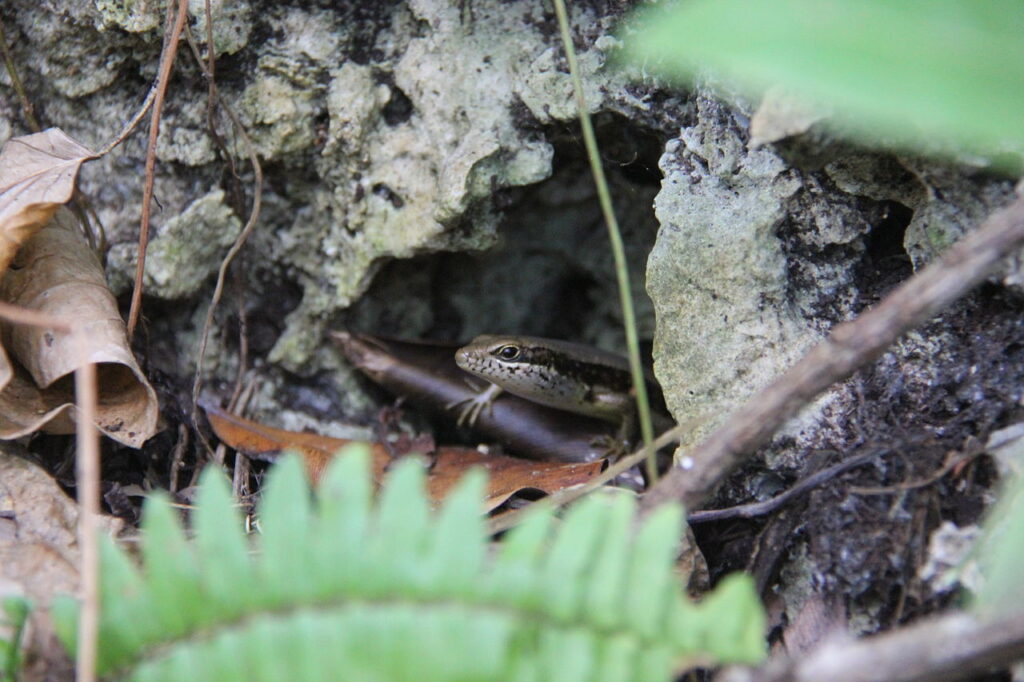
Other residents of Jozani include a population of Zanzibar Sykes’ monkey ( Cercopithecus albogularis albogularis ), a subspecies that is endemic to the archipelago and which you are quite likely to see on a guided walk. The forest is also home to Ader’s duiker ( Cephalophus adersi ), a species of small antelope found only on Zanzibar and some parts of the Kenyan coast, and the even tinier suni antelope ( Neotragus moschatus moschatus ). Both are extremely shy and unlikely to be seen. Ader’s duiker is virtually extinct in Kenya now and, listed as Vulnerable by the IUCN, its best chance of survival is on Zanzibar Island. Its population is between
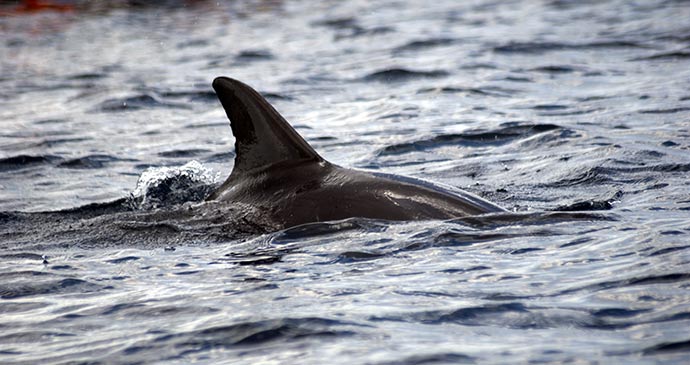
Menai Bay Conservation Area
At the far end of the island’s southwestern peninsula, on an increasingly rutted coral road 15km from Zanzibar Town, is the peaceful village of Fumba. It’s a quiet, scenic place and very few tourists ever come here, which gives it a good deal of its charm. There is only one upmarket lodge offering accommodation, but day trips to the marine conservation area of Menai Bay are run by two reputable operators, so even if you can’t stay it’s still possible to get a taste of this area.
From the beach south of the village, local fishermen take their ngalawa outriggers and dhows to the islands and fishing grounds beyond, and here too is the departure point for one of the boat trips. It’s truly stunning in the surrounding waters but if you also want to get a deeper insight into the community, ask around for a local villager called Issa Kibwana, who conducts small tours of the nearby fruit and spice plantations, or arrange a meeting with him through Sama Tours.
What to see and do
The Menai Bay Conservation Area has a number of picturesque uninhabited islands and sandbanks to explore as well as some fascinating marine life. It’s well worth taking one of the full-day sailing and snorkelling excursions here, either through Fumba Beach Lodge (if you’re a guest), with Safari Blue (departing from the Fumba Peninsula), or Eco+Culture (departing from Unguja Ukuu).
Eco+Culture is a socially & environmentally aware tour operator that specialises in the Unguja Ukuu Boat Trip. On a traditional dhow, small groups are taken past rich mangrove forests to the pristine beaches of Miwi, Nianembe or Kwale islands & accessible sandbanks. Snorkelling kit is provided & the shallow reefs around the bay & islands provide excellent opportunities to spot brightly coloured fish & corals. After a good amount of time in the water, a delicious BBQ lunch is prepared on the beach, which invariably features a selection of freshly caught fish, Swahili side dishes & tropical fruits.
The Safari Blue tour pauses at a few of the bay’s islands & sandbanks for exploration, a tasty lunch & relaxation, in between guided snorkelling forays & hopeful spotting for humpback & bottlenose dolphins. The 1st stop of the day is usually Kwale sandbank for gentle snorkelling. If conditions allow, a 2nd snorkelling session takes place at West Kwale. Sailing on further, BBQ seafood lunches await on Kwale Island, where tamarind trees offer shade (vegetarian/non-fish options must be ordered in advance).
Some shade is available on these boats and beaches, but remember to apply sunscreen and preferably wear a T-shirt for protection when snorkelling. Towels and waterproof shoes are also recommended as you’ll most likely have to wade out to the boat across coral rock.
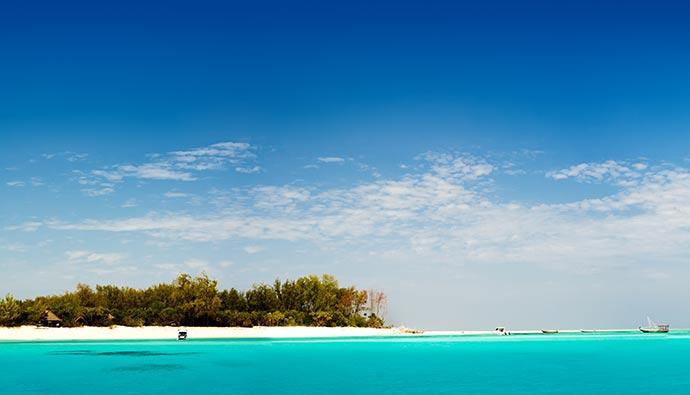
Mnemba Island
Lying approximately 2.5km off the northeast coast of Zanzibar, Mnemba is a picture-perfect 11ha coral island enclosed by calm turquoise waters that hide some of East Africa’s best coral reefs in a relatively unspoilt aquatic wonderland. Now privately leased by &Beyond, the previously uninhabited island operates as one of Africa’s most-exclusive and sumptuous beach retreats, and as such cannot be visited without an overnight booking. Fortunately, however, there are no restrictions on diving and snorkelling sites on the fringing reefs, where several spectacular submarine sites are visited on popular daily excursions out of Nungwi, Matemwe, and elsewhere in northern Zanzibar.
The triangular perimeter of Mnemba comprises 1.5km of soft, brilliant-white coral-sand beaches: perfect for romantic evening strolls, migrating wading birds, scuttling ghost crabs, and nesting turtles. At the island’s centre, a casuarina forest is home to nothing more dangerous than cooing red-eyed doves, colourful butterflies, and an ancient well.
For most visitors, Mnemba’s astonishingly diverse marine fauna is of more interest than its terrestrial wildlife. The island is part of a coral formation that supports a staggering variety of marine creatures: not only hundreds of different species of colourful reef fish, but also a wealth of pelagic visitors, ranging from marine turtles and dolphins to whale sharks and manta rays. The reefs were once threatened by overfishing and a general disregard for the fragility of the environment, but sustained lobbying by &Beyond and the government resulted in the official creation of the Mnemba Island Marine Conservation Area in 2002. This was later expanded to become the Mnemba-Chwaka Bay Marine Conservation Area, which protects the entire barrier reef fringing the northeast coast as far south as Chwaka, and Mnemba’s future now seems reasonably secure.
A small conservation levy is charged on all watersports, notably snorkelling and diving, within the protected zone. This revenue is paid into a community conservation fund, the primary purpose of which is to show local fishermen and their communities the very real economic value in protecting rather than exploiting these exceptional reefs. In addition, the lodge and Africa Foundation (&Beyond’s social development partner) have invested at least US$180,000 in community projects on Zanzibar close to Mnemba: building classrooms, a windmill and ablution blocks, refurbishing the doctor’s house, supporting the orphanage, and assisting villagers with access to clean water.
Nungwi and Kendwa
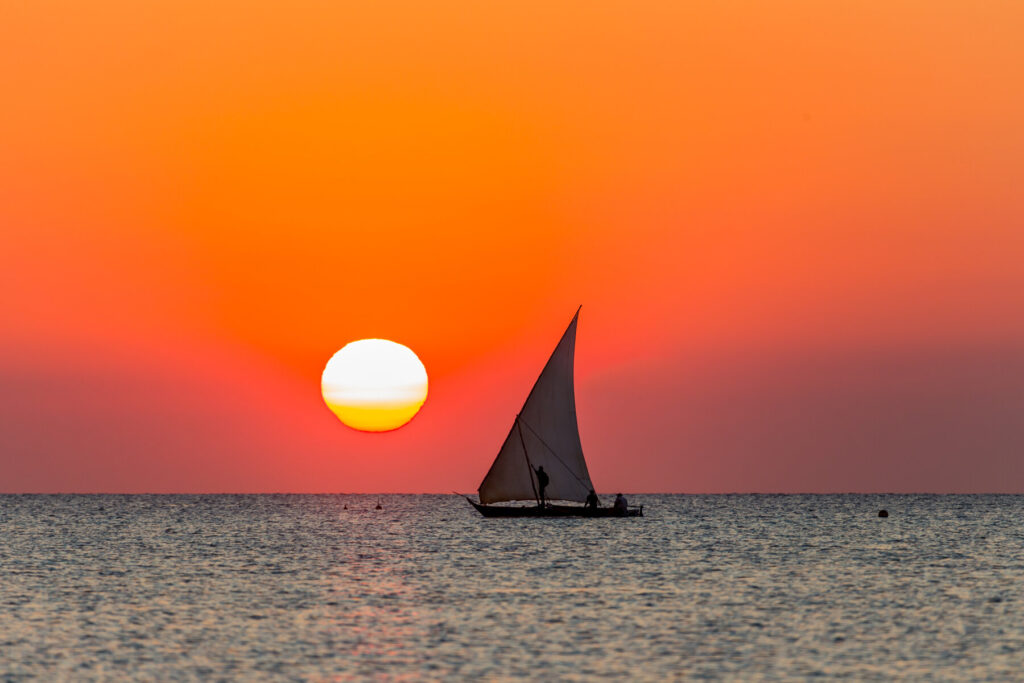
Nungwi is traditionally the centre of Zanzibar’s dhow-building industry, and over the last decade the coastline here has rocketed in popularity to become one of the island’s busiest beach destinations. The ramshackle fishing village has been largely sidelined by an ever-increasing number of guesthouses, bars, shops, restaurants and bikini-clad Europeans.
Over the last decade or so, the number of hotel rooms in Nungwi has rocketed from around 400 to well over 1,000. Hotels have sprung up in literally every direction, roads have been repeatedly re-routed and costs have escalated. With the exception of the World Bank-funded tar road to Stone Town, and the police post paid for by local hoteliers, there has been little thought given to the pressure on natural resources, specifically fresh water, with this vast increase in visitor numbers, and sadly the local population has suffered the brunt of the negative consequences, in very direct contrast to those who come to enjoy their ‘island paradise’.
That said, the Nungwi beach scene has matured in recent years and become a little more comfortable in its own skin. The beachfront hassle has declined in favour of clusters of local curio stalls; basic shops and small businesses have been established offering everything from massage to snorkel hire; the wild nights have tempered, making way for tables set for feet-in-the-sand beach dinners; and a couple of cool cocktail spots have taken the place of pop-up makuti-roofed bars. Professionalism has spread, too, with benefits to the community through training and employment and, of course, to the visitor’s experience. Dive operations are now universally reliable and reputable, accommodation standards are on the rise (at all budgets), and the village is benefiting from some decent efforts at hotel-funded community projects.
After a few crazy years of incessant building and change, things are finally settling down. Gardens have flourished in those dusty construction sites and, though Nungwi has changed irrevocably from the sleepy island backwater of old, it is once again reclaiming some of its exotic charm. Backpackers still come here looking for a cheap, fun beach break, but now so do city executives, honeymooners, retired couples and families – and all appear to be having a good time. Within the village, population numbers have spiralled with immigration (local and from the mainland) driven by the prospect of employment and tourist dollars; for the first time, Nungwi’s population hit 10,000 in the 2012 census and it is now almost certainly the island’s second-largest settlement, behind Zanzibar Town.
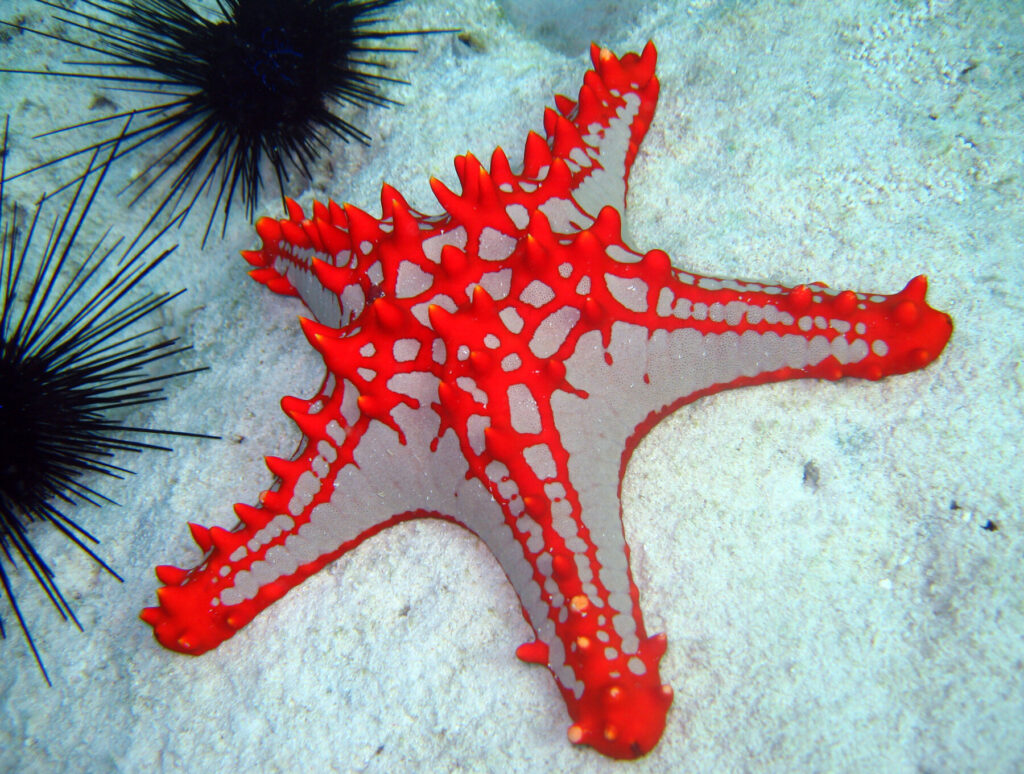
Ironically, given its current state, Nungwi was one of the last coastal settlements on Zanzibar to have a hotel, or any tourist facilities. As recently as the mid 1990s, proposals for large developments in the area were fiercely opposed by local people. Today, in spite of the influx of tourists, Nungwi remains a fairly traditional, conservative place with proudly independent villagers. They are not unfriendly, however, and most visitors find that a little bit of cultural respect, politeness and a few words of Swahili go a long way.
Most visitors come to this area to relax on the beach, swim in the sea, and perhaps to party at night. For local attractions, the small turtle sanctuary on the beach, terrific local coral reefs and growing array of watersports are still a draw. If you want a more cultural experience, check out the village tour, head down the coast to the 16th-century Swahili ruins at Fukuchani and Mvuleni, the bustling and ramshackle market at Mkokotoni, or venture across the water to Tumbatu Island. If you want peace, quiet and fewer people, you will probably need to visit a different corner of the island.
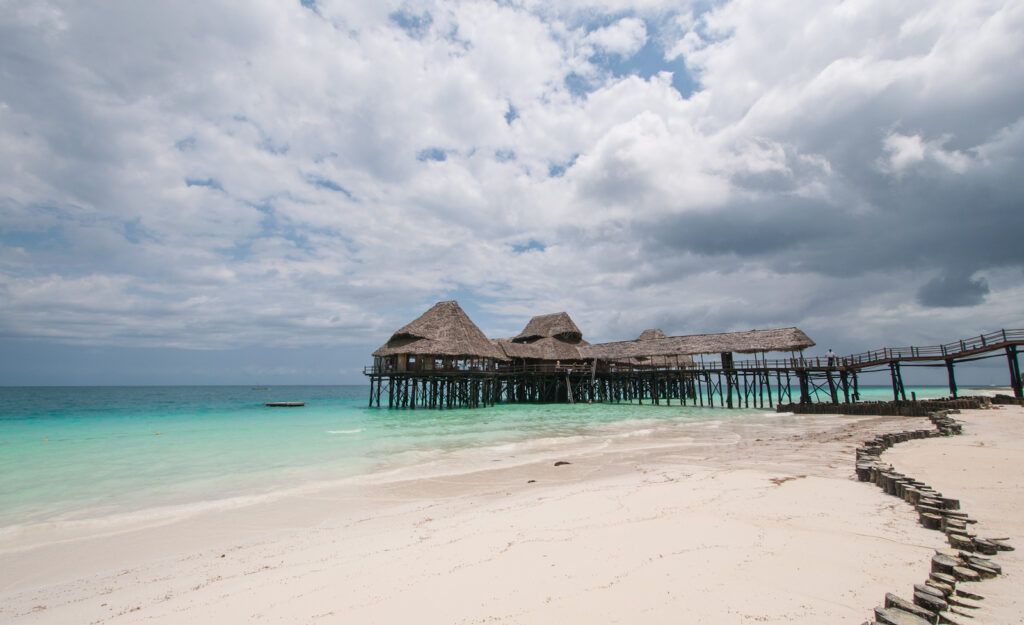
On the west coast, about 4km south of Nungwi, is the tiny, linear village and beautiful beach of Kendwa. Once offering relief from the noise and crowded development of Nungwi, its glorious, wide, sandy beach used to cater almost exclusively to free-spirited budget travellers and those in search of simple escapism – that is, until the upmarket coastal La Gemma Dell’Est arrived around 1km further north in 2005. It’s now somewhat less serene. A clutch of neighbouring, luxurious resorts now line its shore and the simple beach huts of old are increasingly hard to find. Unlike some areas, however, the developments here are generally well landscaped, low-level and on large plots, giving a greater sense of space and making it a peaceful place to chill out.
A few original beach bars remain, alongside the beachfront hotel restaurants and their banks of carefully guarded loungers, and there are three great dive schools. The beach also benefits from less extreme tidal changes than the east coast, making swimming possible all day long. Things do liven up in the evenings, with bonfires, barbecues and serious Full Moon beach parties, attracting island- wide crowds, but otherwise Kendwa is still a relative haven of peace – though you do have to negotiate a fairly awful (but mercifully short) approach road to get here!
Sunbathing, beach volleyball, diving and snorkelling are the main activities in Kendwa – it’s a terribly laidback beach hangout. The vast majority of the hotels and guesthouses will hire out basic snorkelling gear, organise day trips by boat to Tumbatu Island, and offer sunset dhow cruises; some will rent out kayaks, too.
Once a small fishing village, straggled along the coast, Paje is centred on the junction of the tar road from Zanzibar Town with the main east coast road between Michamvi and Makunduchi. This prime location has always made it the easiest place on the east coast to reach by public transport and certainly contributed to its early success as the backpackers’ choice location.
After an initial peak, Paje’s visitors declined as Nungwi claimed the crown for budget beach action, but the north is pulling upmarket again these days, and the backpacker pendulum is currently swinging back to the east coast. Recent years have also seen a veritable boom in Zanzibar kitesurfing, and Paje is now firmly on the map as a destination for sun-blond kiters seeking a cheap getaway in warm, tropical waters with reliable conditions. More lodges have sprung up, old ones have expanded, cafés have opened, a basic curio street now stretches back from the beach, and everywhere along this stretch, kites fill the sky. During peak season, the beach is pretty hectic with people and fluttering silk, and swimming is an absolute non-starter.
The kitesurfing community – both professional centres and visitors – are generally fairly laidback and responsible, but the sheer numbers of visitors here have attracted some associated troubles: a rise in beach boys permanently lingering on the sand, some beach robbery and reports of increasing problems with drugs. By and large, the area surrounding the village remains a quiet spot for an idyllic beach break, but it’s worth taking sensible precautions when wandering around. Genuine interaction with the local community is virtually non-existent here, with only the beach traders mixing with the tourists.
The primary activities in Paje are sunbathing on the beautiful beach and swimming in the sea. If staring out at the waves breaking along the fringe reef pricks your curiosity, there are two dive schools and a number of European-run kitesurfing operations; be aware, though, that the latter is seasonal, with the best times being December to February, or even better, from June to August. For those tired of the salt and sand, a small heart-shaped pool at Dhow Inn is open to non-residents for a daily fee of US$5.
An informative diversion is the Mwani Zanzibar Seaweed Company , which operates a suburban visitors’ centre in the back roads, about 1km north of the village centre. Given the visibility of seaweed farming, it’s well worth checking out these lovely new ‘headquarters’ to better understand its very real importance to the community. An informative 1-hour guided tour, including a glass of seaweed juice and a visit to one of the seaweed production areas on the nearby beach, costs US$15 per person. The on-site shop sells a range of organic seaweed products, including soaps, scrubs, and oils, that make perfect, lightweight souvenirs.
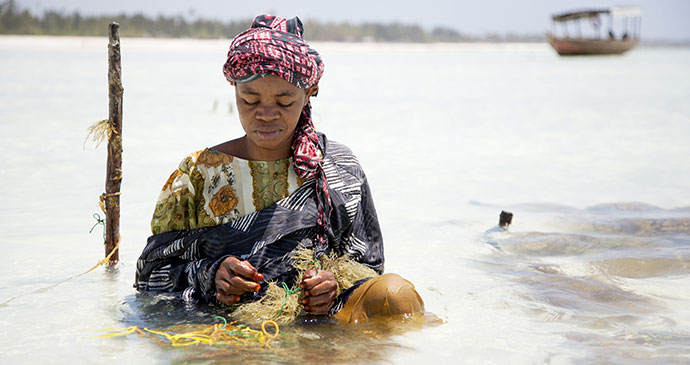
There is also an old mausoleum : a low rectangular edifice with a castellated wall, inset with antique plates and dishes. This design is thought to have originated in Persia, and may indicate that this part of the island was settled by Shirazi immigrants prior to the western side of the island, near present-day Zanzibar Town. Ask one of the local villagers to escort you for a small fee.
In the last decade, kitesurfing has literally taken off on Zanzibar, particularly in the area around Paje. A colourful and fascinating spectator sport, its rise comes as no surprise to the many operators here. Warm, calm, tropical waters, a shallow lagoon and constant steady wind (13–25 knots is ideal) for eight months of the year have all contributed to its success. There is good, flat, waist-deep water for freestylers at low tide, and choppy conditions (1–3m waves) beyond the reef at high tide that thrill the wave riders.
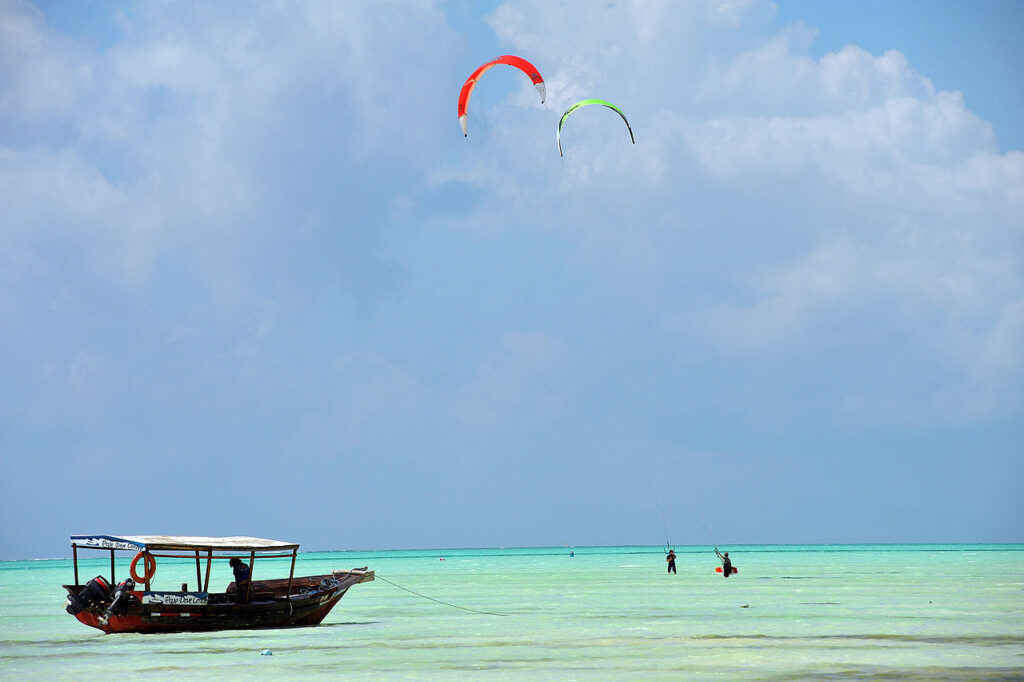
Beginners can take courses with licensed instructors, advanced riders can bring and store their own kit or hire on the beach, and the kitesurfing community is generally professionally run on the island. Perhaps the only drawback of the popularity is that swimmers are perhaps better off away from this kiting heartland, where boards zip through the surf from dawn to dusk. Should this be of interest to you, equipment, courses and more information can be found at Airborne Kite Centre , Harakakite or Kite Centre Zanzibar .
Pemba Island
Pemba Island lies about 80km to the northeast of Zanzibar Island, and about the same distance from the Tanzanian mainland, directly east of the port of Tanga. Smaller than Zanzibar, at just 67km long, it covers an area of 985km ² and has a more undulating landscape, even though its highest point is only about 95m above sea level. But one of the first things that most strikes the visitor is how green it is. More densely vegetated than Zanzibar (with both natural forest and plantation), Pemba has always been seen as a more fertile place. The early Arab sailors called it El Huthera, meaning ‘The Green’. Today, as always, far more cloves are grown here than on Zanzibar.
With 406,848 inhabitants recorded in the 2012 census, Pemba is – like Zanzibar – one of the most densely populated areas of Tanzania, although this is no urban jungle. Most of the population live in traditional square houses, with a wooden frame, mud walls and thatched roofs (occasionally upgraded to corrugated iron). The largest town is Chake Chake, the island’s capital and administrative centre, about halfway down the western side of the island. Other main towns are Wete, in the north, and Mkoani, the main port, in the south.
For today’s visitor, Pemba’s greatest attractions include long, empty beaches, some excellent diving and snorkelling, and the unspoilt Ngezi-Vumawimbina Forest Reserve. There are several small historical sites which, although not ‘must sees’, ertainly repay a visit if you use just a little imagination. Perhaps more important, though, attracting a few thousand visitors annually, and with relatively few tourist facilities, Pemba is still a place where travel for its own sake (by car, bus, bike or on foot) remains a prime reason for visiting.
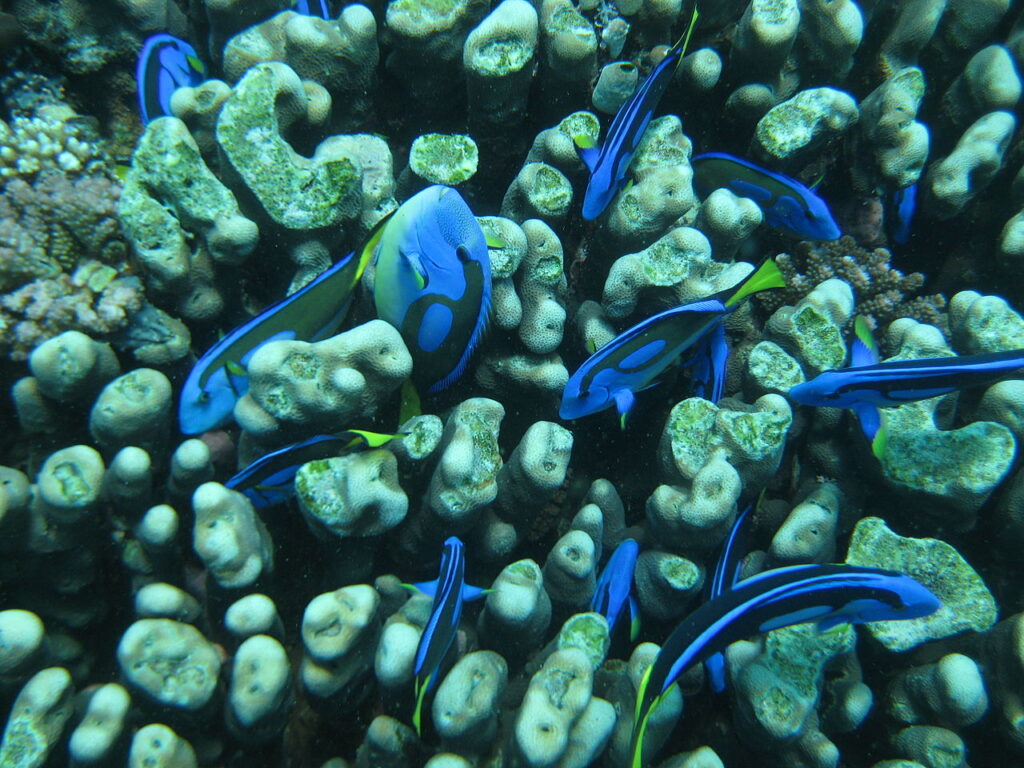
Recreational diving off Pemba is, for the most part, confined to the Pemba Channel on the more sheltered west of the island. Misali Island in particular provides a wonderful array of corals and fish life. Unlike the reefs around Zanzibar Island, many of the reefs off Pemba fall away into steep walls, offering opportunities for some exciting drift dives and the chance to see creatures such as the spotted eagle ray, with its 3m wingspan.
Despite Pemba’s undoubted reputation for the big pelagics, such as barracuda, trevally, giant groupers and the endangered Napoleon wrasse, sightings of shark are extremely rare on the west of the island, and even to the south. If it’s sharks that you’re after, you need to deep dive in the east, where the steep walls and fast currents attract hammerheads.
Most operators use either speedboats or motorised dhows to get to the dive sites. While the former are undoubtedly faster, there’s a lot to be said for the leisurely pace of a dhow, giving the opportunity to take in the beauty of the islands or to watch large teams of fishermen working with their nets from narrow wooden boats. On the way to the dive sites, particularly in the morning and further north, you may be joined by schools of common or spinner dolphins, just tagging along for the ride, and occasionally humpback whale sightings have been reported. See 360 Dive Pemba , Dive 710 or Swahili Divers for more information.
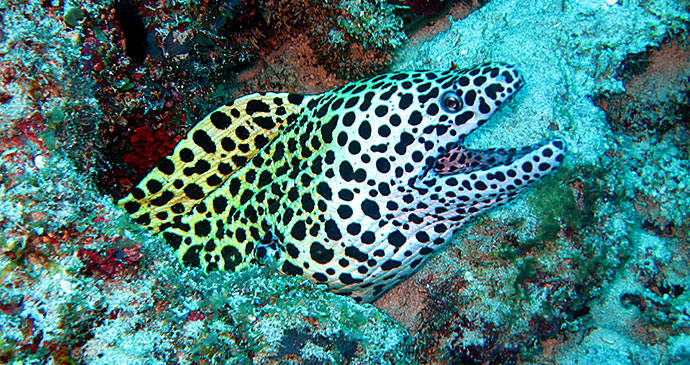
Snorkelling
While there is no shortage of places to swim and snorkel off Pemba, most are viable only at high water. One of the best places for snorkelling lies in front of the visitor centre on Misali Island, where – in just a few feet of water, and regardless of the tide – countless fish and other underwater life can be seen in almost perfect visibility.
As you drift through the water, keep an eye out for unicornfish, sea goldies, cleaner wrasse, deep red and blue parrotfish, and the startling Moorish idol. Giant clams grip the reef, and sea cucumbers edge along the sandy bottom; you may even spot a grouper. Other excellent sites include the Aquarium in the Njao Gap and the 1km-long reef protected by the Kwanini Foundation in front of the Manta Resort. Other possibilities include areas around the sandbanks that dry out at low tide along the west coast. Snorkelling trips can be organised through all the hotels and lodges; expect to pay US$20–40, depending on the distance to the site.
All the larger tourist lodges and hotels have kayaks, with short guided trips offered by Fundu Lagoon for their guests. The Manta Resort offers kayak safaris (US$30 pp), while at Swahili Divers, a half-day guided mangrove tour costs US$35.
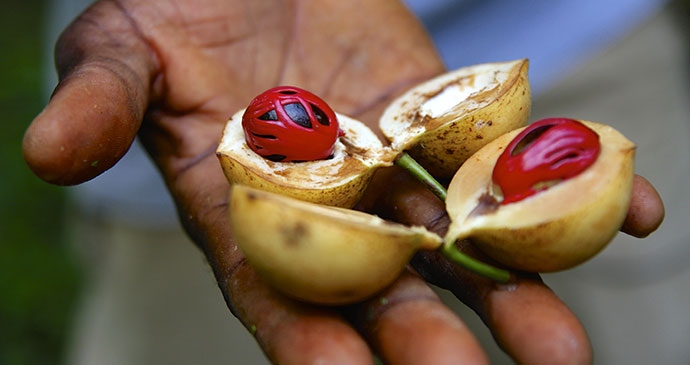
Spice tours
Sooner or later every visitor to Zanzibar will be offered a ‘spice tour’ – a trip to the farmlands just outside Stone Town to see aromatic plants and herbs growing wild or cultivated in kitchen gardens. Even if you decline a tour, the array of spices on offer in the souvenir shops or heaped in baskets in the local markets will tell you that spice is central to Zanzibar’s history and economy.
The history of spices in Zanzibar begins early in the 16th century, when the ‘spice race’ between the major European powers to control the lucrative trading routes to the Far East was at its height. Portuguese traders gained a toehold on Zanzibar as part of their plan to rule the coast of East Africa and imported various plants, including spices, from their colonies in South America and India. Some land was cleared for plantations, but the Portuguese never really developed their presence on Zanzibar beyond a military one.
It was left to the Omani Arabs, who ruled Zanzibar from the early 19th century, to develop Zanzibar economically as a spice-producing entity. Sultan Seyyid Said, the first Omani sultan to govern Zanzibar, quickly realised the potential of his new dominion, with its hot climate and regular rainfall, as a location for spice farming. With the demise of the slave trade in the late 19th century, spices became Zanzibar’s main source of income.
When the era of the sultans ended and the long arm of the British Empire reached Zanzibar, the island’s new colonial administrators encouraged the farming of spices and other useful plants, bringing European scientists to establish experimental agricultural stations and government farms such as those at Kizimbani and Kindichi. Today these areas still contain spice plantations controlled by the modern Tanzanian government.
But spices in Zanzibar today are by no means simply the preserve of governments keen to produce cash-rich export products or a useful tourist attraction. For the ordinary people of Zanzibar, spices and useful plants are a vital part of everyday life and a rich element in the island’s strong and vibrant culture. The spices grown in village kitchen-gardens give their flavour to the distinctive cuisine of Zanzibar, provide innumerable cures for everyday ailments, and yield the dyes and cosmetic products needed to celebrate weddings and festivals.
A spice tour is probably the best way of seeing the countryside around Stone Town and meeting rural communities. Guides take you on a walking tour of the villages and plantations at Kizimbani or Kindichi, picking bunches of leaves, fruit and twigs from bushes and inviting you to smell or taste them to guess what they are. Pretty much all the ingredients of the average kitchen spice rack are represented – cinnamon, turmeric, ginger, garlic, chillies, black pepper, nutmeg and vanilla among many others. Local children follow you all the way round, making baskets of palm leaves and filling them with flowers to give to you. At lunchtime, you’ll stop in a local house for a meal of pilau rice and curry, followed by sweet Arabic coffee and perhaps a slice of lemongrass cake. Many spice tours include a visit to the Persian baths built by Sultan Said for his harem, and stop at Fuji or Mangapwani beaches just outside Stone Town for a swim on the way back.
All in all, even if horticulture isn’t one of your interests, a spice tour is still an excellent way of gaining an insight into one of the most important aspects of rural life in Zanzibar.
Zanzibar Town is divided in two by the wide thoroughfare that is officially called Benjamin Mkapa Road but is more commonly referred to by its older name: Creek Road (in reference to a creek that was long ago reclaimed). On the west side of Creek Road is the ‘heart’ of Zanzibar Town: the evocative old quarter, usually called Stone Town. This is the more interesting section for visitors: many of the buildings were constructed during the 19th century (although some date from before this time), when Zanzibar was a major trading centre and at the height of its power.
The trade created wealth which in turn led to the construction of palaces, mosques and many fine houses. Discovering the architectural gems hidden along the tortuous maze of narrow streets and alleyways that wind through Stone Town is part of the island’s magic for many visitors. Aside from the souvenir Tingatinga paintings, neatly folded kanga fabrics and beaded jewellery, it’s a scene virtually unchanged since the mid 19th century.

What to see and do in Stone Town
One writer has compared the old Stone Town of Zanzibar to a tropical forest where tall houses stretch to the sky instead of trees, and the sun filters through a network of overhanging balconies instead of foliage.
Its labyrinth of twisting streets and alleys is a stroller’s paradise, with new sights, sounds or smells to catch the imagination at every turn: massive carved doors, ancient walls, tiny tempting shops with colourful wares and bustling shoppers, old men hunched over a traditional game, kids with homemade toys, ghetto-blasters at full volume, little boys hawking cashews or postcards or fresh bread, the sound of the muezzin calling from the mosque and the scent of cloves or ginger or lemongrass – and everywhere the echoes of Zanzibar’s rich and fascinating history, the sultans, shipbuilders, explorers, slave markets, merchants and exotic spice trade.
The market is about halfway along Creek Road and a good place to visit even if you don’t want to buy anything. At the end of the 19th century, the town’s marketplace was inside the Old Fort. Today’s market hall was built in 1904, and some very early photographs of the market displayed in the museum show that very little has changed since then. The long market hall is surrounded by traders selling from stalls, or with their wares simply spread out on the ground.
It’s a very vibrant place where everything, from fish and bread to sewing machines and secondhand car spares, is bought and sold. Don’t miss the swathes of multi-patterned cotton fabrics, the fragrant spices and mound after mound of exotic fruit and vegetables, though – and just enjoy people-watching and being part of a Zanzibar experience which hasn’t yet become especially touristy.
Livingstone House Museum
On the northeast side of the town, in the Kinazini waterfront quarter, this old building was constructed in around 1860 for Sultan Majid, at a time when Zanzibar was used as a starting point by many of the European missionaries and pioneers who explored eastern and central Africa during the second half of the 19th century. David Livingstone, probably the most famous explorer of them all, stayed in this house before sailing to the mainland to begin his last expedition in 1866. After independence and the Revolution the house became the Zanzibar headquarters of the Tanzania Friendship Tourist Bureau, the forerunner of the Zanzibar Tourist Commission.
A large downstairs room is due to open as a Livingstone Museum at an unspecified point in the future, under the curatorship of Said El-Gheithy, the local academic and guide who is also the curator of the Princess Salme Museum. When open, it will offer displays of original artefacts and reproductions of items associated with Livingstone’s life, as well as story boards recounting his travels.
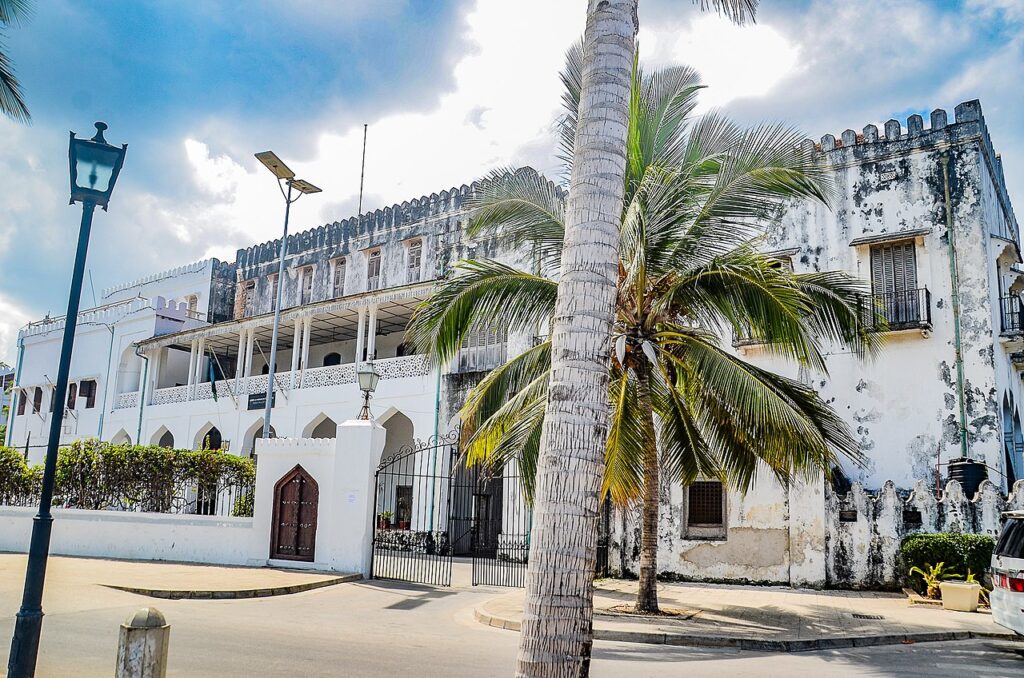
Palace Museum
Housed in a large white building with castellated battlements situated on Mizingani Road, where the latter runs very close to the sea, this palace was built in the late 1890s for members of the sultan’s family and was originally called the Sultan’s Palace. From 1911, the palace was used as the Sultan of Zanzibar’s official residence, but was renamed the People’s Palace after the 1964 Revolution, when Sultan Jamshid was overthrown. It continued to be used as government offices until 1994 when the palace was turned into a museum dedicated to the history of the sultans of Zanzibar. Remarkably, much of their furniture and many other possessions survived the revolutionary years and can now be seen by the public.
The upper floors are largely devoted to exhibits from the later, more affluent period of 1870–96, with thrones, banqueting tables (the banquet room is said to be still used on occasions) and ceremonial furniture, plus personal items such as beds (look out for the intricately carved ebony love seat and the Indian sofa with Krishna on its back) and the sultan’s mobile water closet with its unusual arrangements.
The Old Fort
The Old Fort is a huge building, containing large open courtyards, and with high, dark walls topped by castellated battlements. It was built between 1698 and 1701 by the Busaidi group of Omani Arabs, who had gained control of Zanzibar in 1698, following almost two centuries of Portuguese occupation. Today, the fort has been renovated, and is open to visitors.
It is easy to walk around the top of the battlements and enter the towers on the western side, which house ‘Colours of Zanzibar’ in the southwest tower and the ‘Collective Art Gallery’ in the northwest tower, from where local art can be purchased. In 1994, the eastern courtyard was turned into an open-air theatre. The development was imaginative yet sympathetic to the overall design and feel of the original building: seating is in an amphitheatre, and the fort’s outer walls and the neighbouring House of Wonders form a natural backdrop. It’s used for contemporary and traditional music, drama and dance, including most performances in the annual Sauti za Busara and the Zanzibar International Film Festival.
The entrance area also houses a tourist information desk, with details on performances in the amphitheatre and other events around town, plus a selection of books for sale and a range of tour company leaflets to browse. There are also several spice and craft shops, a pleasant café and public toilets. With so many attractions and facilities, it’s easy to spend an hour or so here.
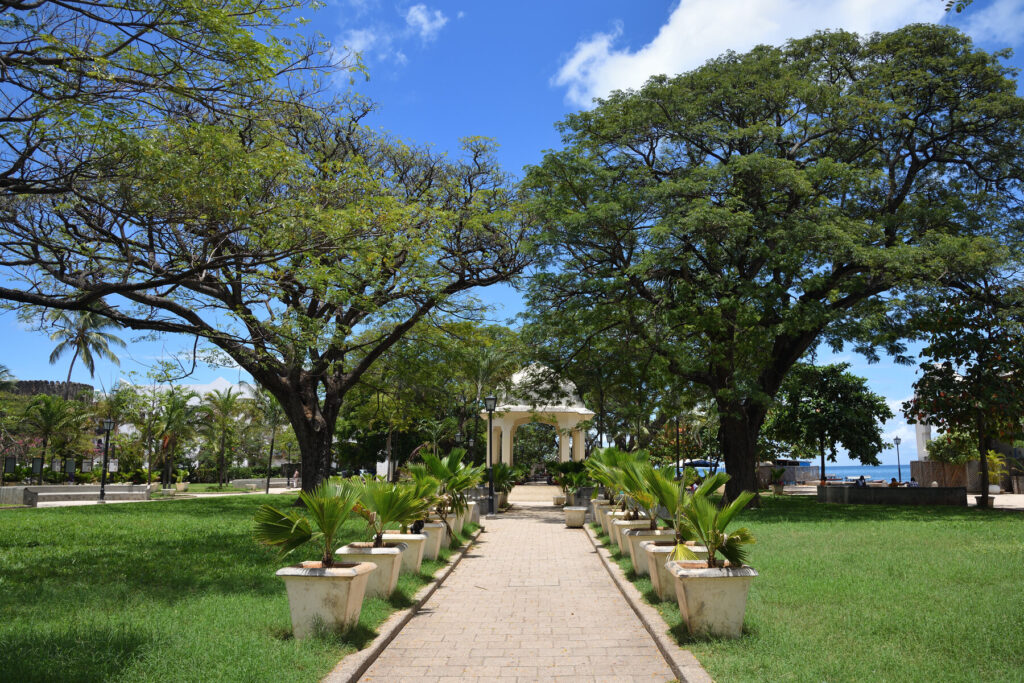
Forodhani Gardens
The Forodhani Gardens are between the Old Fort and the sea, overlooked by the House of Wonders. The gardens were first laid out in 1936 to commemorate the Silver Jubilee of Sultan Khalifa (sultan from 1911 to 1960), and were known as Jubilee Gardens until the 1964 Revolution.
In 2009, after years of neglect, the gardens were re-landscaped by the Aga Khan Trust for Culture and are now the pulsing heart of Stone Town every evening when the food stalls come into their own. Everyone agrees the new gardens are a vast improvement, with the street lighting, waste collection, a new sea wall of salvaged stone, and an organised food court for the evening stallholders. Cafés, the bandstand, a dhow-shaped adventure playground and tropical planting amid manicured lawns make it look like the central park it is. We hope this project will prove a catalyst for ongoing urban upgrading and economic opportunity in Stone Town, as well as improving the rest of the waterfront’s aesthetic appeal.
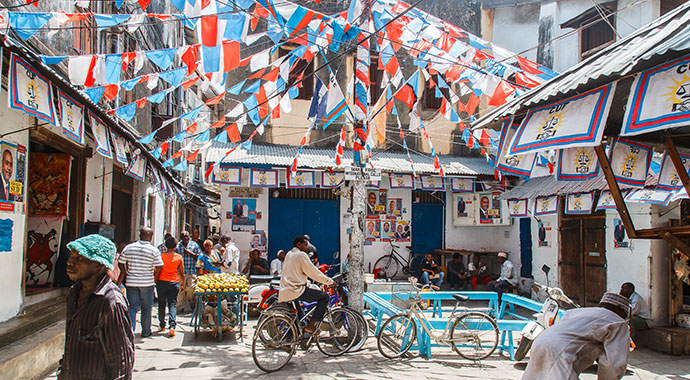
Related books
For more information, see our guide to Zanzibar :
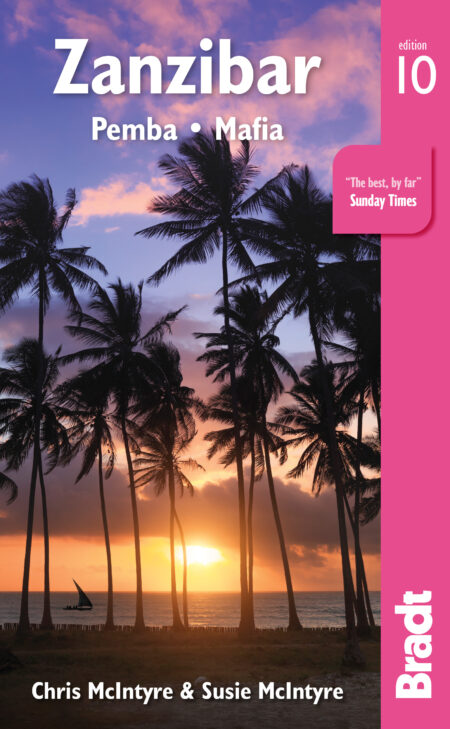
Articles about Zanzibar
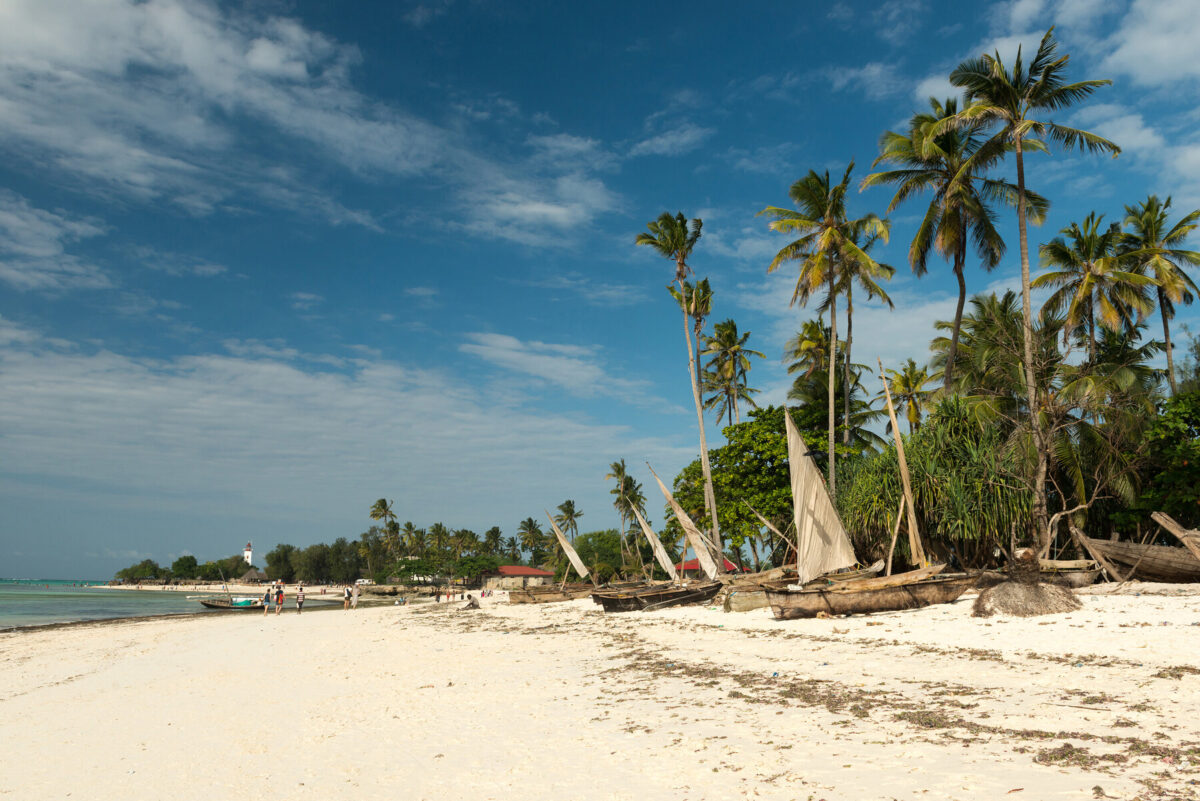
Why travel to Zanzibar?
Home to traditional coastal villages, excellent wildlife and some of the best dive sites in East Africa, Zanzibar is a paradise well worth visiting.
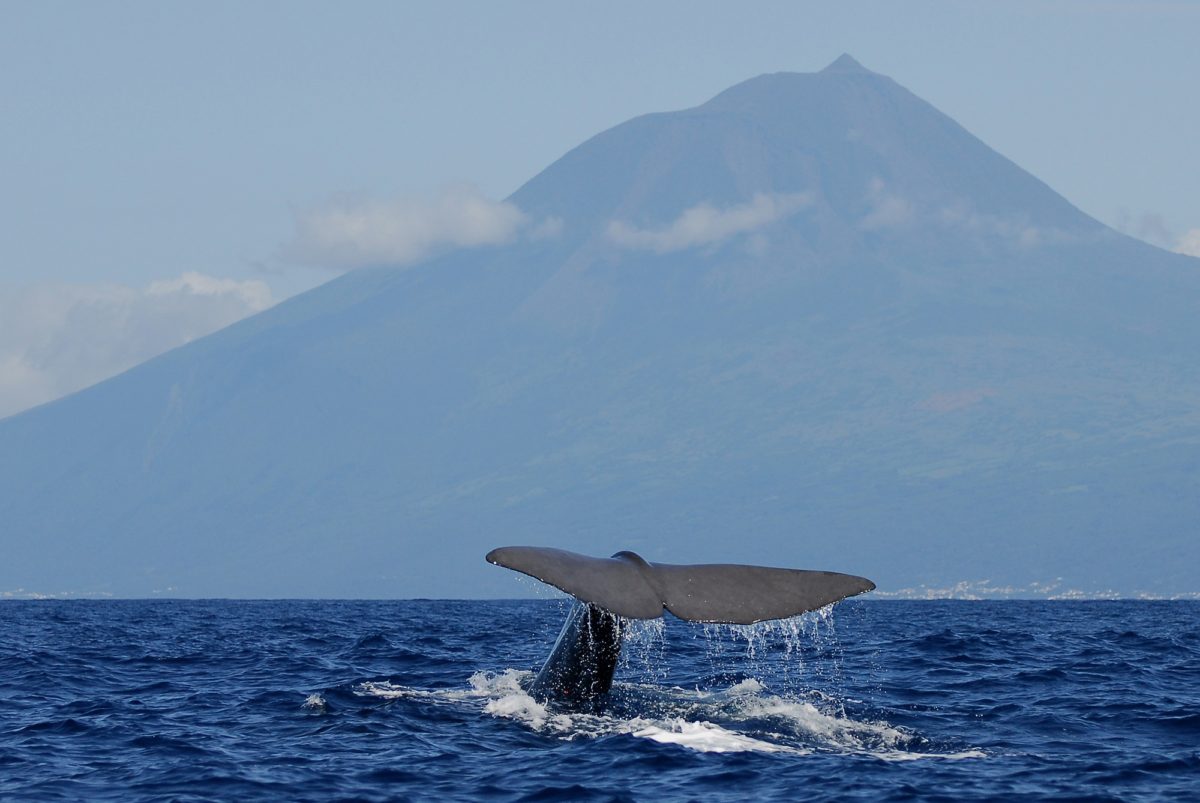
A whale of a time: the world’s best whale-watching destinations
Want to spot a whale in the wild? Then these are the destinations for you.
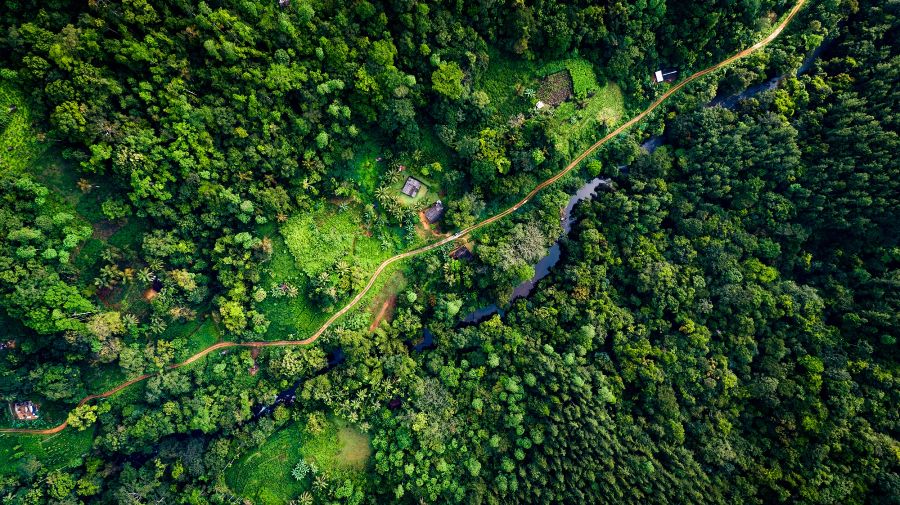
Seeing the wood for the trees: 11 of the world’s most spectacular forests
Covering even more of the world than our guidebooks, forests are ubiquitous but almost always different.

Travel Blog
The ultimate zanzibar travel guide for luxury travel.
- July 28, 2023

Introduction to the Zanzibar Travel Guide
Welcome to the exotic Zanzibar Archipelago, a tropical paradise nestled in the Indian Ocean off the coast of East Africa. Mallerby’s Luxury Travel is thrilled to present this comprehensive Zanzibar Travel Guide, offering you insights into the enchanting islands and captivating atolls that make this a dream destination for discerning travellers seeking a perfect blend of history, culture, and natural beauty.
Table of Contents

Position & Geography
The Zanzibar Archipelago is nestled just a short distance from the Tanzanian mainland. Geographically, it lies between the latitudes of 5 and 7 degrees south of the Equator, ensuring a warm tropical climate year-round.
Islands and Atolls
The Zanzibar Archipelago consists of two main islands: Unguja (also known as Zanzibar Island) and Pemba, as well as several smaller islets and atolls, such as Mafia Island and Mnemba Island which add to its allure. Known for its scenic beauty, exquisite white sandy beaches, turquoise waters and vibrant coral reefs teeming with marine life, Zanzibar also boasts a rich history and showcases a unique blend of African, Arab, Indian, and European influences. A variety of activities offers a dream-like escape for all types of travellers, whether you’re looking for a romantic escape, a fun-filled family vacation or a digital detox, whilst the island’s theme of laid-back living gently coaxes you to slow down and enjoy each moment as it comes. Join us as we delve deeper into the islands through this Zanzibar Travel Guide.

Travel Guide to Zanzibar Island
Zanzibar Island, also known as Unguja, is the largest and most famous island in the archipelago and is a mesmerizing tapestry of culture and history. This enchanting island has incredible natural beauty, offers a plethora of activities to suit all travellers, wonderful warm hospitality and is the epitome of laid-back island living. The capital, Stone Town, is a UNESCO World Heritage Site, where narrow alleys lead to old Arabic-style buildings and bustling markets. Relax on the idyllic white-sand beaches or immerse yourself in the spice-scented plantations that earned Zanzibar the title of the “Spice Island.” For ease of reference, we’ve divided Zanzibar Island into two focus areas, namely Stone Town and the Coast, in order to offer you the best travel advice on offer on this island.
About Stone Town & Things to Do:
Stone Town is the oldest and one of the most beautiful parts of the island. Imagine cobbled streets and meandering alleyways where you’ll find intricately carved doors, historic buildings and bustling markets, allowing you to immerse yourself in the cultural tapestry of this iconic town. We recommend that you spend at least a night or two here if your time allows.
Our preference for you is a full day in Stone Town with a guide. You’ll walk through the slave markets, the Palace of the Sultans, the Anglican Cathedral and the Old Arabic Fort, learning about Zanzibar’s fascinating history along the way, and then as the sun sets, you’ll enjoy sundowners at a local spot before sampling the local cuisine as you wander from venue to venue for your starter, main and dessert.

We also recommend experiencing the following:
- The Forodhani Night Market for a culinary adventure of local street food.
- The Tea House for an evening of deliciousness, but bookings are essential.
- A guided Spice Tour – it’s the Spice Island after all and still one of the largest spice producers today. Head out with you guide to explore a community supported spice farm where you’ll learn about the spices and their medicinal uses, as well as try some spiced tea and taste the fruits in season.
- Prison Island. This tiny island, just off the coast, was once a prison for rebellious slaves but today is inhabited by giant tortoises. A half-day guided tour includes the 30-minute boat transfer from Stone Town, return.
- The Zanzibar Butterfly Centre which has the largest butterfly enclose in East Africa.
- The Jozani Forest where a guided walk takes you along forest trails in search of the different species of monkey.
- The Seaweed Centre where you’ll learn about the harvesting and processing of seaweed, plus the opportunity to buy wonderful beauty products like organic soaps and essential oils.
Our favourite authentic accommodations in Stone Town are Upendo House and Kisiwa House.

About Zanzibar Island’s Coast & Things to do:
Beyond Stone Town lies the pristine coastline of Zanzibar, the perfect setting for a fabulous beach vacation, whether you prefer to laze on the white sandy beaches, take a dip in the crystal-clear waters and turquoise lagoons, or dive the colourful reefs. There are luxurious accommodations dotted along the coastline to suit all types of travellers, whether you’re looking for a private villa, a family-friendly resort, a romantic getaway or even a destination wedding venue, and Mallerby’s Luxury Travel will assist you in finding the most perfect place to suit all your needs. Activities range from some of Africa’s best snorkelling and diving experiences to dhow sailing, deep-sea fishing and dolphin safaris, to culinary classes, wellness treatments, romantic dinners on the beach, horse riding and immersive conservation projects.
Important to note is that the Zanzibar Island experiences two low and two high tides per day, with 6 hours between the low and high tides. The northern coast of Zanzibar Island experiences the least tidal effect on the coastline, so staying in the northern areas is best for perfect beach conditions. The north coast also offers a vibrant nightlife and exquisite sunsets, whilst the east coast is quieter and more tidal but has excellent conditions for kiteboarding.
Our favourite accommodations are Zuri Zanzibar, Xanadu Villas and Safira Blu Luxury Resort and Villas.

Zanzibar Travel Guide to the Islets within the Archipelago:
Lying off the coast of Zanzibar Island are several smaller islands, islets and atolls scattered around the Zanzibar Archipelago, each one perfect for those seeking a quieter and more secluded experience.
Accommodations range from exclusive sole-use islands to luxury private resorts on an island. Below is a travel guide to our favourite islands within the Zanzibar Archipelago:

Mnemba Island:
Located just off the north-east coast of Zanzibar Island, this tiny island is just 1.5kilometres wide and synonymous with luxury and exclusivity. With only 12 luxuriously rustic palm-frond bandas peeping out onto the white coral sand beach from the dappled shade of the casuarina pine forest, the island is only inhabited by its 24 guests and the staff taking care of them. Reached only by boat from Zanzibar Island, you’ll experience butler service, private dining on the beach under the stars, yoga, wellness treatments and a variety of water activities from snorkelling off the beach to scuba diving courses. Highlights include the Green Turtle nesting and hatching in season, community visits, conservation initiative projects, dolphin boat trip and sunset dhow cruise.
Pemba Island:
To the north of Zanzibar Island, Pemba Island is a lesser-explored gem and just a short, scheduled flight from Zanzibar. This pristine island of great beauty and fertility, has forests, swamps, mangroves, hidden beaches and lagoons, making it a haven for nature enthusiasts and diving aficionados. Still the predominant global producer of cloves, Pemba Island has been designated an Important Bird Area by BirdLife International and is also home to several dive sites with steep drop-offs, untouched coral and abundant marine life. Pemba Island offers an authentic experience for those looking for serenity and close encounters with nature.
Our favourite accommodation on the island is The Manta Resort. Set on the northern tip of Pemba Island, Manta is a luxurious retreat featuring 13 villas and suites, suitable for couples and families, some with a private pool and others with a private garden. A highlight is the Underwater Room – a floating structure showcasing a lounge and sundeck with an underwater bedroom where you overnight underwater! Activities range from snorkelling and diving to sunset Ngalawa cruises to spa treatments on the beach. Explore the island on a visit to a Spice Farm, walk through the Ngezi Rainforest or stroll along the beach to the lighthouse. A signature activity, the Pemba Coral Reef Safari, is an exclusive diving experience that promises to take you on an immersive, guided journey through the Pemba Coral Reef ecosystem.
Mafia Island:
To the south of Zanzibar lies a small archipelago of islands, of which Mafia Island is the largest. Known to be one of the best diving and snorkelling destinations in the world with incredible coral reefs, tropical fish and sea turtles.
Thanda Island is part of the archipelago and is a short helicopter flight north of Mafia Island. A mere 5.5 hectares in size, Thanda Island is offered on a sole-use basis for a maximum of 18 guests, offering a luxurious paradise to enjoy in complete privacy with family and friends. Situated in a private marine reserve, guests can dive the exquisite reefs, swim with whale sharks, watch sea turtles nesting in season, sail in a traditional Arab dhow, savour a Swahili or Arabian feast, indulge in a massage or just rest and rejuvenate in a copper bath on the beach.

Fanjove Island:
South of the Mafia Archipelago is the Songo Songo Archipelago which is composed of 22 reefs and 4 islands. Fanjove Island is a secluded and exclusive tropical island, reached by a 50-minute scheduled flight from Dar es Salaam via Mafia Island to Songo Songo Airport, where a 45-minute transfer in a traditional dhow sailboat gets you to the shores of Fanjove Island. This tiny island, covering about 1 kilometre in length and 400 metres in width, accommodates a maximum of 20 people and is yours to explore and enjoy. Surrounded by azure blue seas with white sandy beaches that are shaded with coconut palm trees, step off your beach villa deck, toes in the sand and wade right into the lovely tepid waters. Swim and snorkel straight off the beach, SUP or kayak, set sail on a dhow cruise, savour a beach picnic on a sandbank or explore the pristine 11-kilometre coral house reef snorkelling or diving.

Getting & Around the Zanzibar Archipelago:
The main entry point to the Zanzibar Archipelago is Zanzibar International Airport and several major airlines operate regular flights from various cities around the globe. If on safari, scheduled light aircraft flights connect to Zanzibar from Dar es Salaam and Arusha. Transportation from the airport to your chosen island destination may be via private road transfers, scheduled flights, helicopters or boat transfers, and Mallerby’s will arrange this for you as part of your itinerary.

The Best Time To Visit the Zanzibar Archipelago:
Zanzibar enjoys a tropical climate throughout the year, with warm temperatures and high humidity. The best time to visit is during the long, dry season which extends from June to October, and the short, dry season which generally starts mid-December through to the end of February. Avoid the long rains from March until the end of May. The short rains during November and December are lighter and more like afternoon thundershowers.
Read more on the Best Time to visit Africa by Country

Travel Advice When Planning Your Trip to the Zanzibar Archipelago:
When considering travel to the Zanzibar Archipelago, it’s essential to plan carefully to ensure a safe, enjoyable, and memorable experience. Here are some travel advice and tips to bear in mind when you are ready to start planning:
- Check the latest travel advisories issued by your government regarding travel to Zanzibar and stay informed about any safety or health-related concerns in the region.
- Visas depend on your country of origin – some nationalities require visas in advance whilst some may be eligible on arrival.
- Make sure your passports are valid for at least six months beyond your intended stay.
- Comprehensive travel and medical insurance are essential and should cover, but not be limited to, medical emergencies, trip cancellations, luggage and personal belongings, activities you plan to participate in such as diving and water sports, and any other unforeseen events.
- Consult your local travel clinic well in advance to receive recommended vaccinations and take necessary health precautions.
- The local currency in Tanzania is the Tanzanian Shilling (TZS). While some places may accept major foreign currencies, it’s best to exchange money on arrival or withdraw cash from the ATM’s. Credit cards are accepted at larger hotels and restaurants, but smaller establishments may prefer cash, as do local stores and markets.
- Tipping is widely appreciated as the industry relies heavily on tourism.
- When buying at the markets, bartering is acceptable, but be friendly and fair.
- The locals make wonderful gifts and souvenirs, anything from the local spices and essential oils to clothes and jewellery, so keep space in your luggage for special mementos for yourself, friends, and family.
- When packing, lightweight, breathable clothing is suitable for the tropical climate, along with essential items such as sunscreen, mosquito repellent, a hat, and sunglasses.
- Please respect the local culture. Zanzibar is a predominantly Muslim region, so it’s important to dress modestly. Women are asked to cover their knees and shoulders when in public, and skimpy beachwear is frowned upon, as is public displays of affection.
- Whilst the people of Zanzibar are wonderfully friendly, please ask their permission before taking photographs.
- Swahili is the local language; however, English is widely spoken. The locals are very friendly, so try to learn a few Swahili phrases prior to your journey. ‘Jambo’ is an easy one and it means ‘hello’.
- Zanzibar is generally safe for tourists, but like any destination, exercise caution. Avoid displaying expensive items, be aware of your surroundings, and don’t walk alone in poorly lit areas at night.
- When swimming, pay attention to local advice regarding the ocean currents as some areas may have strong currents or tides. Lifeguards always know best.
- Zanzibar’s delicate ecosystem is home to diverse marine life, so when snorkelling or diving, avoid touching or damaging coral reefs and marine creatures.
- Zanzibar’s cuisine is as varied as it is delicious, so tantalise your tastebuds by sampling as much as you can!
- And lastly, but most importantly, Zanzibar works on ‘Island Time’. Life is slow, laid back and there’s no rush… so whatever you’ve ordered, prepare to wait, but it will be worth it!

Extending your trip from the Zanzibar Archipelago:
Adding a luxury safari experience to your Zanzibar beach escape is a fantastic way to experience the diverse beauty of Africa, so our below Travel Guide to extending your trip to the Zanzibar Archipelago offers some of the best options to consider. Each country offers a unique safari experience and combining it with a relaxing beach vacation in Zanzibar will create a well-rounded and unforgettable African adventure.
We recommend at least 4 nights on Safari and 4 nights on the beach, however more time allows you to explore further areas to truly experience the best of both worlds.
Since Zanzibar is part of Tanzania, it makes for a seamless combination with a safari on mainland Tanzania. The country boasts world-renowned safari destinations like the Serengeti National Park which hosts the famous annual Wildebeest Migration ; the Ngorongoro Crater, once a gigantic volcano and now home to a diversity of wildlife; Tarangire National Park, well known for its huge herds of elephants; and the southern parks of Tanzania which offer exceptional walking safaris, fishing and wildlife viewing. Each area is unique, well-worth a visit and your itinerary can be designed to seamlessly fly between each destination of choice, ending in Zanzibar.
Read about the Serengeti Safari Experience
Bordering Tanzania to the North, Kenya offers remarkable wildlife viewing experiences. The Maasai Mara National Reserve is famous for its abundant wildlife and the annual wildebeest migration; the Laikipia region is a collection of private reserves and conservancies teeming with wildlife and offering a range of activities from walking safaris to camel riding and conservation initiatives; the Amboseli region is well known for its large herds of elephants, horse riding and walking safaris, with Mount Kilimanjaro as its backdrop. Direct flights from Nairobi’s Wilson Airport to Zanzibar will connect you from your safari to the beach in a matter of hours.
Read about the Masai Mara Safari Experience
Southern Africa:
Should you choose to safari in South Africa or any of its neighbouring countries, a direct flight from South Africa’s Johannesburg International Airport will connect you to Zanzibar on certain days, within a matter of hours.
South Africa is home to the world-famous Kruger National Park, as well as the malaria-free Madikwe National Park and Eastern Cape conservancies, all offering a fantastic Big 5 wildlife experience.
Botswana is home to the Okavango Delta, a UNESCO World Heritage Site, and one of the most unique safari destinations offering both land and water-based game viewing opportunities.
Zambia and Zimbabwe are neighbouring countries which both offer incredible wildlife viewing as well as access to the iconic Victoria Falls, one of the world’s most impressive natural wonders.
Each of these countries offers its own distinct safari experiences, so whether you opt for the vast savannahs of Tanzania or the unique waterways of Botswana, combining a safari with a Zanzibar beach escape will create an unforgettable African adventure.

Travel with Mallerby’s Luxury Travel:
At Mallerby’s Luxury Travel, we strive to provide unparalleled experiences tailored to your preferences. Planning and executing your journey can become a stressful experience, so allow us to take care of the logistics and stress for you! Our expert guides will personally design an itinerary based on your specific travel requirements, offering suitable suggestions on accommodations and activities, and then add in the finer details to ensure you have a seamless and unforgettable journey that surpasses your expectations.
Summing up your Zanzibar Experience:
Zanzibar is a tropical haven that promises an escape from the ordinary. From its pristine beaches and vibrant coral reefs to its rich cultural heritage and enchanting Stone Town, Zanzibar and its archipelago of island escapes offers a blend of luxury and exclusivity with relaxation, adventure, and exploration. Whether you’re seeking a romantic getaway or an unforgettable family vacation, Zanzibar promises an experience of a lifetime. We hope that this comprehensive Zanzibar Travel Guide offered you some noteworthy insight into the possibilities you may wish to encounter on your special journey. Mallerby’s Luxury Travel is committed to curating personalised journeys for its clients, so pack your bags, immerse yourself in the island’s beauty, and let Zanzibar’s charm captivate your senses.
Recent Posts

Family Safari Adventure: Exploring South Africa’s Exclusive Bush Villas
In a world that is constantly on the move, seeking solace in nature while bonding with family has become more precious than ever. And what

The Conscious Traveller: Elevating Luxury Travel through Authenticity with Mallerby’s
Elevating luxury travel through authenticity for The Conscious Traveller In the quarter century of being immersed in the travel industry, I’ve witnessed a profound shift

Visit Rwanda: Your Essential Guide for a Remarkable Trip
Introduction to Visit Rwanda Visit Rwanda, a captivating country in the heart of Africa, where nature’s allure and cultural wonders blend seamlessly. Join Mallerby’s Luxury
Related Posts
25 years’ experience in Luxury Travel across Africa. Curated itineraries for Big 5 safaris through Southern Africa, East Africa and Indian Ocean Island escapes. Contact us for your travel to Africa – we’re ready to assist.
- DESTINATIONS
- CURATED EXPERIENCES
CONTACT DETAILS
Copyright © 2023 Mallerby's Luxury Travel | Website development by Memeworx
WhatsApp us
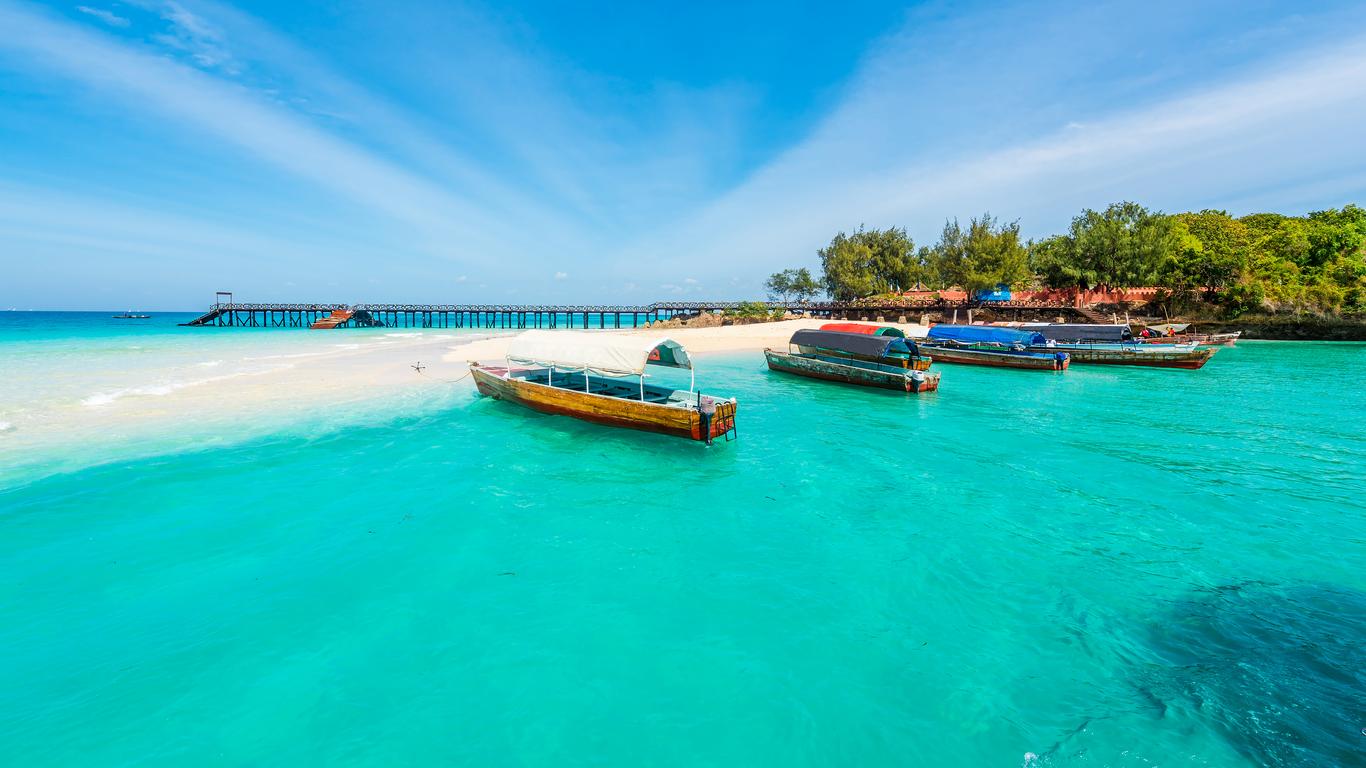
Zanzibar travel guide
Zanzibar tourism | zanzibar guide, you're going to love zanzibar.
Zanzibar is an escape from the everyday and the ordinary, with world-class beaches, and a rich history, culture, and geography like no other in the world. It's a true tropical paradise, but with so much more to offer than just surface beauty.

Zanzibar is an archipelago, consisting of a string of islands in the Indian Ocean just over 15 miles off the coast of Tanzania in East Africa. Unguja, commonly called Zanzibar, is the largest island, and it's where most visitors spend their time. Zanzibar is also known as the Spice Islands, and has been a major source of the world's supply of cloves, nutmeg, cinnamon, and black pepper for centuries.
There is evidence of civilization in Zanzibar dating back 20,000 years. It has seen waves of settlement and colonization from ancient Persian traders to the Portuguese and British. The result is a fascinating modern island with a diverse population and a welcoming spirit towards visitors to their beautiful tropical home.
Top 5 Reasons to Visit Zanzibar
1. the perfect tropical beach experience.
You have your choice of several stunning beaches with fine, coral white sand, and brilliant blue waters on Zanzibar Island alone. The area around Nungwi and Kendwa at the northernmost tip of the island includes an idyllic, wide beach. There are also great beaches to savor at Matemwe, Kizimkazi on the eastern side, and Bwejuu and Dongwe in the southeastern part of the island.
2. Explore a Unique History
In historic Stone Town, a UNESCO World Heritage Site in Zanzibar City, you can see the mix of Islamic and East African Swahili cultures in the architecture, with elegant minarets and wonderfully carved doorways. You can walk through laneways that meander past historical landmarks like the House of Wonders, an 18th-century sultan's palace.
3. World-Class Water Sports
Whether you want to explore in, on, or under the water, you'll find the adventure you crave in Zanzibar, including diving, snorkeling, jet-skiing, and windsurfing. You can go fishing, take a cruise on a traditional dhow, kayak, parasail, or kiteboard. Whether you are an expert or complete novice, you'll find many opportunities to have fun, learn new skills, and enjoy Zanzibar's brilliant blue waters.
4. Unique Nature and Wildlife Encounters
Zanzibar is home to unique species like the Zanzibar red colobus monkey and Zanzibar leopard. You can visit their natural habitat in Jozani Chwaka Bay National Park and check out the colobus and other types of monkeys from a trail through a mangrove forest. The Mnarani Marine Turtle Conservation Pond is a sea turtle sanctuary that is helping to conserve these interesting creatures.
5. Exciting Cuisine in the Spice Islands
Dining in the Spice Islands is everything you'd expect - a fragrant mixture of East African, Arabian, Chinese, and Indian influences. You'll find dishes from the Seychelles Islands too, along with contemporary fusion cuisine, with fresh seafood, seasonings, and other ingredients to offer you the best of land and sea.
What to do in Zanzibar
1. nakupenda beach: pristine expanses.
This may be the most untouched paradise you will ever see in your life. Nakupenda Beach off the coast of Zanzibar Town is an isolated island of pure sand surrounded by crystal waters. Simple as can be, the beach instills peace and relaxation in every visitor. Spend the day lying out in the sun, snorkeling the clear sea, and appreciating the disconnection from hectic civilization. This is the ultimate escape.
2. Stone Town: Historical Center
Zanzibar's capital city is known as Stone Town, and it overflows with historic sights combined with contemporary experiences. Don't miss the 17th-century Old Fort or the House of Wonders, Zanzibar's architecturally stunning Museum of Culture. St. Joseph's Cathedral still stands after centuries, and the time-worn details are stunning. For a taste of local culture visit Darajani Market or head to Forodhani Gardens for the epic seafood night market on the water.
3. Changuu Island: Prison to Paradise
Also known as Prison Island, this offshore marine wonderland had a grizzly history during the slave trade. Today, however, it is a popular day trip for visitors to Zanzibar. Giant turtles that roam the island are the number one attraction, along with a diversity of other creatures - from dolphins to butterflyfish. There is also an informative and commemorative Slave Trade Museum with moving exhibitions about events of centuries past.
4. Nungwi Beach: Treat Yourself
The northern tip of Zanzibar Island is filled with all your beach vacation needs and desires. Nungwi Beach has been rated one of the best in the world and is surrounded by resorts of the highest quality. Even if you are just visiting for the day, their water sports rentals, scuba diving courses, massage booths and seaside bars are available to one and all. Make sure to stick around for the epic sunset too. There truly is something for everyone here.
5. Cheetah's Rock: Make New Friends
One of the island's unique attractions brings tourists face to face with majestic African creatures, and it is a mind-blowing experience for all. Rescued cheetahs, lions, zebras, and more are introduced to each guest in an intimate and safe setting - soon, everyone reaches a mutual understanding. This immersive day of wildlife wonderment will stick with you forever, and you'll have unbelievable photos to show for it.
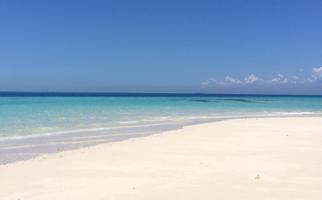
Activities & attractions in Zanzibar
Nature & outdoor activities.
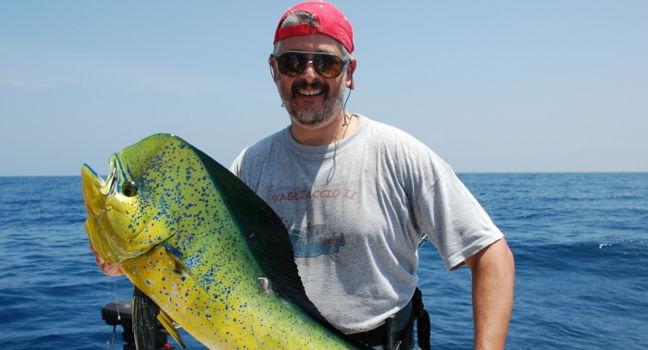
Sports & Fitness
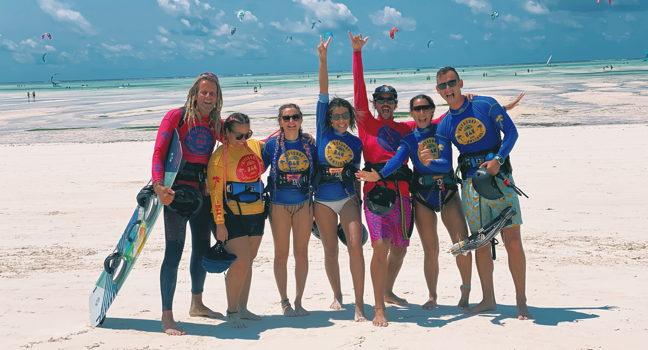
Other activities

Where to Eat in Zanzibar
At the Ubora Restaurant, located in the Ras Nungwi Beach Hotel, you can enjoy serene views of the ocean at a table by the pool, along with a menu of seafood and other dishes done with East African flair. Mains start at about TZS45,000. At The Rock, you'll dine on seafood - literally - on a rock in the Indian Ocean. Main dishes start at about TZS29,000. At Forodhani Gardens, a small park near Stone Town, you'll be joining locals at a street food scene where you'll pay about TZS3,000 for vegetarian dishes with rice, and about TZS4,500 for dishes with chicken or beef.
When to visit Zanzibar
Strong breezes have a cooling effect on Zanzibar's tropical climate. The cooler, drier months of June to October are the most popular for visitors, when daytime highs hover around the mid-80s Fahrenheit. There is a rainy season from March to May associated with monsoons, and a lighter one from November to December.

How to Get to Zanzibar
Abeid Amani Karume International Airport (ZNZ) is just over three miles south of Zanzibar City on Unguja Island. Taxi is your only reliable option to get to town, and the drive is negotiable. You should pay about TZS33,500 to get to Zanzibar City and about TZS111,500 to reach one of the north coast resorts. It is also possible to fly to Julius Nyerere International Airport (DAR) in Dar es Salaam on the mainland and take the ferry to Unguja Island.
Dar es Salaam, on the mainland, is a train hub, making it possible to get to Zanzibar from other points in Tanzania via a combination of train and passenger ferry. The ferry costs only TZS78,120 to TZS111,500.
Ferry service from Dar es Salaam is for passengers only, by and large, making the trip by car unfeasible. A car rental is possible once you get to the island, but you will need a temporary Zanzibar driver's permit.
The most common mode of travel between cities, villages, and resorts on Unguja Island and Pemba Island is offered via dala-dala, a crowded, open-sided minibus operated by a private company. There are several runs daily between Zanzibar City and other points on the island, as well as between the towns on Pemba Island.
Airports near Zanzibar
Airlines serving zanzibar, where to stay in zanzibar.
Zanzibar City - located in the heart of Unguja, this is the capital and center for Zanzibar's spice trade and other commerce. It includes both historical Stone Town and Ng'ambo, a growing modern city of office towers and apartment blocks.
Popular Neighborhoods in Zanzibar
Nungwi and Kendwa - these villages on the north coast of Unguja are where you will find some of Zanzibar's finest beaches. Not surprisingly, it's also where to find many of the area's premium luxury hotels and resorts.
Pemba Island - this is the second largest island, separated from the rest of the archipelago by deep ocean channels. It is a green island with fertile land often cultivated for cloves. It's also where you'll find world-class diving and game fishing, along with newer resorts and hotels.
Where to stay in popular areas of Zanzibar
Most booked hotels in zanzibar, how to get around zanzibar, public transportation.
There is no public transportation in Zanzibar per se. There are privately owned companies that operate dala-dalas, the open-sided minibus taxis that operate on a shared ride basis. Popular with locals, it's a true adventure in Zanzibar culture for visitors, and the flat fare is TZS2,000 from Stone Town to the coastal areas.
Taxi service is plentiful in Stone Town and in many areas of Zanzibar Island where there are luxury resorts. A trip within Stone Town costs about TZA11,150 during the day, with negotiable fares often rising at night.
Car rentals are available from local companies such as Zanzibar Express Car Hire and First Car Rental starting at about TZS78,120 per day. Scarce parking can be an issue in some areas of the cities. Many tourists opt to hire a car and driver for about TZS111,500 per day.
The Cost of Living in Zanzibar
Shopping streets.
Stone Town offers you a unique and varied shopping trip. For clothing made by local designers and companies, along with jewelry, spices, and even music by local artists, look into the boutiques along Gizenga Street and Kenyatta Road. For both fine jewelry made of gold and silver, and local artisan work such as beaded pieces, Soko Muhogo Square is an alternative to Gizenga Street.
Groceries and Other
Kwality Supermarket and Migoz Supermarket are both located in Zanzibar City. You can buy produce, basic groceries, and just about anything else at the Darajani Markets, a bazaar located in Stone Town near the Anglican Church. One quart of milk costs about TZS2,835 and a dozen eggs costs about TZS 3,500.

Ten Days in Zanzibar: An Itinerary for First-Timers
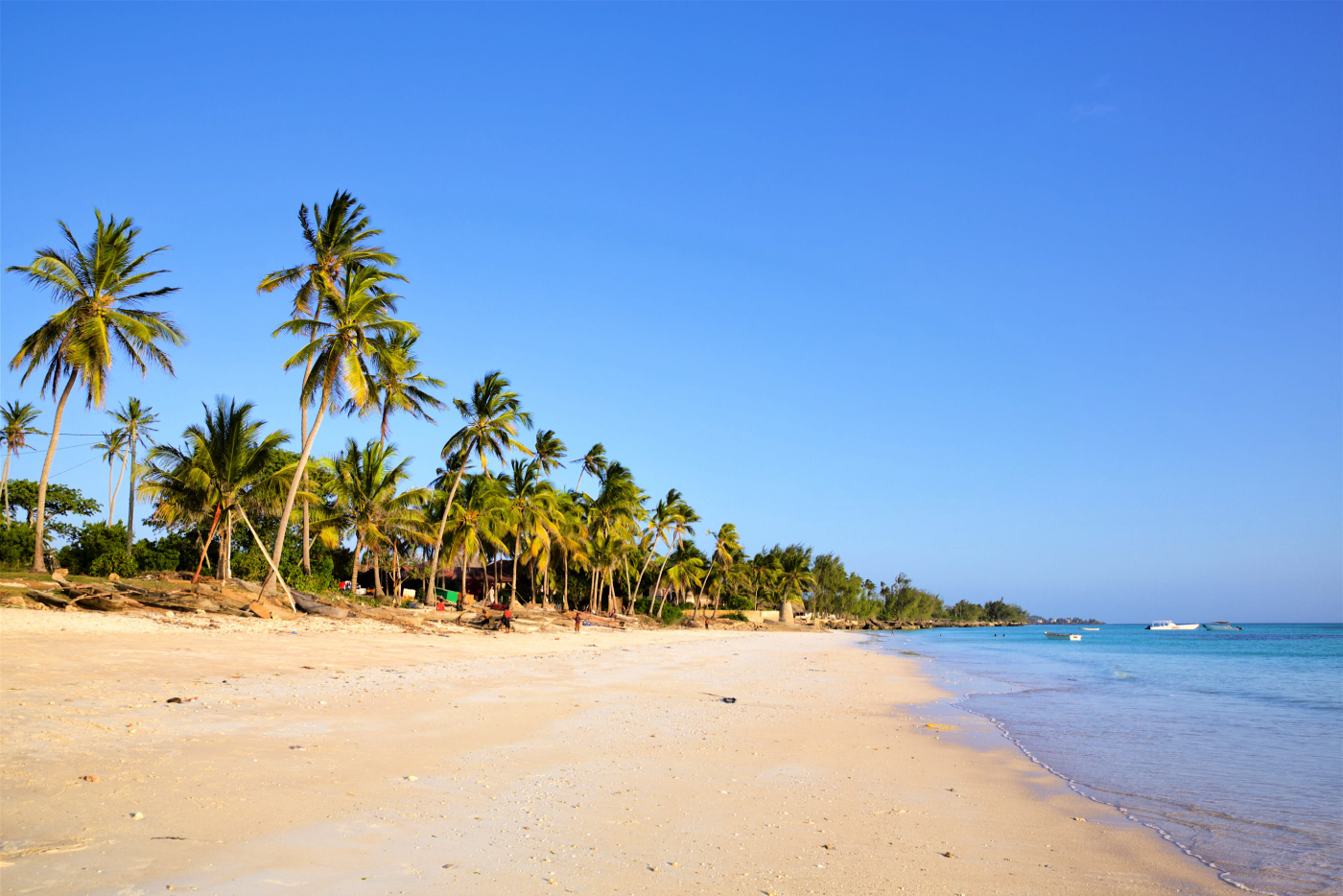
Located just off the coast of East Africa, Zanzibar is an archipelago with a fascinating and colorful history. Today, Zanzibar is a semi-autonomous zone within the nation of Tanzania, after having experienced several different periods of colonization by a number of different world powers. Throughout this time, however, Zanzibar was a major hub for slavery in the African Great Lakes region, as well as Stone Town being a busy port city.
Today, this history is reflected in the extensive cultural diversity among Zanzibari people, an ethnic mixture of backgrounds ranging from Persian and Arab to African. The vast majority of the population is Muslim, although there are small factions of other religions present in the archipelago, and Swahili is the locals’ first language.
Visiting Zanzibar offers you the opportunity to enjoy two major sides of what the archipelago has to offer – an incredibly rich cultural and historical experience, as well as a gorgeous seaside holiday. Of course, there are many destinations around the world where you can experience vibrant cultures, fascinating history, and pristine beaches, but there aren’t many places where you can tick all these boxes within 565 square miles. That’s the dream, right?
My trip to Zanzibar was quite unlike anything else I’ve experienced before. I’d read a lot about the plethora of things to see and do, ranging from visiting the old slave market in Stone Town to swimming with dolphins off the north-eastern coast of the main island. However, when I was finally able to do these things myself, I found myself in awe of how incredibly multifaceted Zanzibar is as a holiday destination.
The hustle and bustle of the busiest parts of Stone Town make you feel like you’re in a North African riad, while the white sandy beaches of the east coast are comparable to the picture-perfect honeymoon locations of Mauritius and the Seychelles – just quieter and a little more authentic!
But the best part of all is that Zanzibar is relatively cheap. Whether you’re looking for a budget holiday or a middle-of-the-road type of trip, Zanzibar is a holiday destination that’ll allow you to have an epic experience and do plenty of activities without having to break the bank. I wrote a detailed guide on how to visit Zanzibar on a budget , if you’re interested.
Zanzibar has so many things to do that it can be overwhelming at first, but the good news is that because the main island is small, it’s absolutely possible to experience a little bit of everything without feeling like you’re being run off your feet. It’s all about striking a balance between experiencing the history and culture while also making time to sit back, relax and enjoy your gorgeous surroundings, and in my opinion, this is the perfect place to do just that.
Today, I’m going to share with you some things that I wish I’d known when first visited Zanzibar, along with a comprehensive itinerary of where to go, what to do, and where to stay during your ten days in Zanzibar.
My itinerary will take you all over the island – you’ll start in Stone Town and see the most important historical sites and do a traditional spice tour, among other things. After that, I’ll guide you through the best way to see the whole island – from doing a dhow cruise in Nungwi to hanging out on the beaches in Kiwengwa, to exploring the legendary Jozani Forest, to finally enjoying a little bit of paradise in Kizimkazi. I’m going to give you advice on where to go, what to do, and where to stay so that you can have an epic trip without any bumps in the road (metaphorically, of course).
Whether you follow my guide from A to Z or just pick out a few fun places or useful tips, I hope that my experience can help you plan the perfect holiday to East Africa’s most underrated tropical paradise. Now, let’s dive right into our 10-day Zanzibar itinerary!
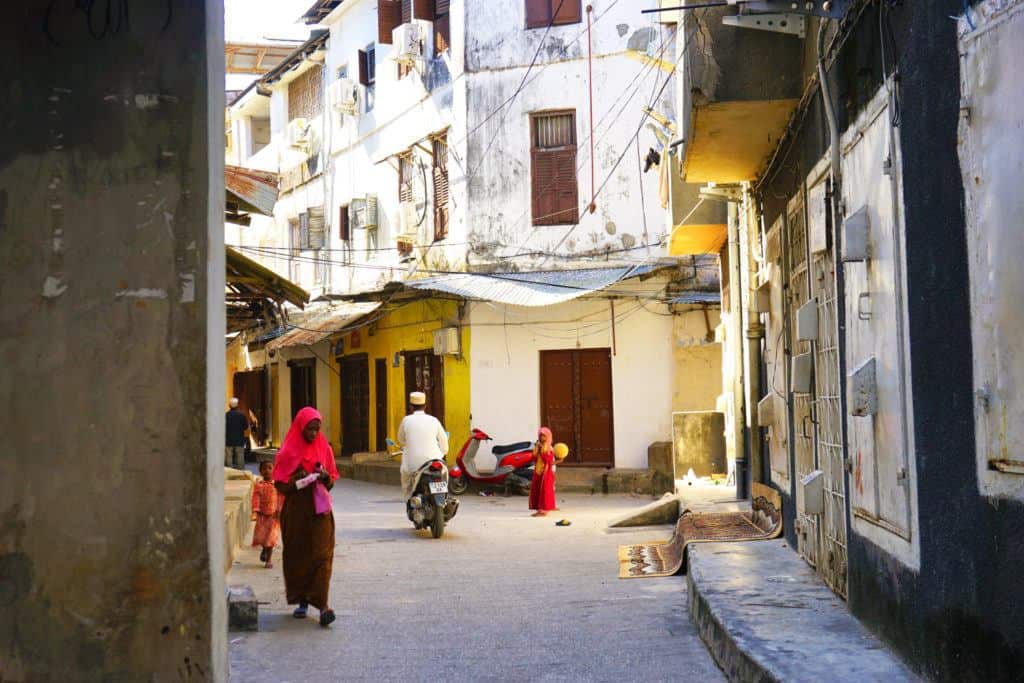
Day 1: Exploring Stone Town
Prepare to be greeted by Stone Town’s bustling atmosphere the minute you arrive – you’ll be surrounded by friendly locals, bustling storefronts, and remarkable architecture. To be in and amongst the action is the best way to properly experience Stone Town, so I’d suggest exploring on foot as much as possible! I found that it allowed me to really appreciate the complexities of my surroundings – from the colonial buildings to the exquisitely designed wooden doors. The best part of this is that Stone Town is pretty small, so you can absolutely walk it!
Take the plunge and start your adventure at the Darajani Bazaar, arguably the biggest and most popular market in Stone Town. There’s nothing quite like wandering around a traditional market – surrounded by local merchants and families doing their grocery shopping, this is one of my favorite things to do in Zanzibar. There really is no better way to immerse yourself in the local culture! But remember, you will, most likely, stick out like a sore thumb as a tourist, so don’t allow any vendors to take advantage of you and charge you the world for produce or products.
Next, take a quick stroll down Market Street to the Old Slave Market, probably the most important stop of your Zanzibar itinerary. Be warned – this is, as you may have anticipated, a somber experience. But, having said that, it was truly enlightening and educational too. I’d advise doing a proper tour, during which your guide will show you around the site and explain the distressing history of slavery in Zanzibar.
The site includes several statues and memorials for the people who died during this period, and the atmosphere is palpable. The former slave market serves as a harsh reminder of the shadows of darkness that are cast by the island’s colonial history of oppression, appearing in stark contrast to the beautiful old colonial buildings that line the streets of Stone Town – but it’s an important reminder, nonetheless.
Next up, on a slightly different note, head on over to Freddy Mercury House. Yep, you heard me! If you didn’t already know this, you may be surprised to hear that Freddy Mercury grew up in Stone Town and you can visit his former home. You can’t go inside, but you’ll be able to admire the beautiful, traditional door and read all about his life on the plaques positioned outside the house. I found this to be quite a fun and unexpected pitstop, but then again, I’m a bit of a Queen fan girl – so it may not be as much fun if you’re impartial to them (the greatest rock band of all time, cough, cough). Each to their own!
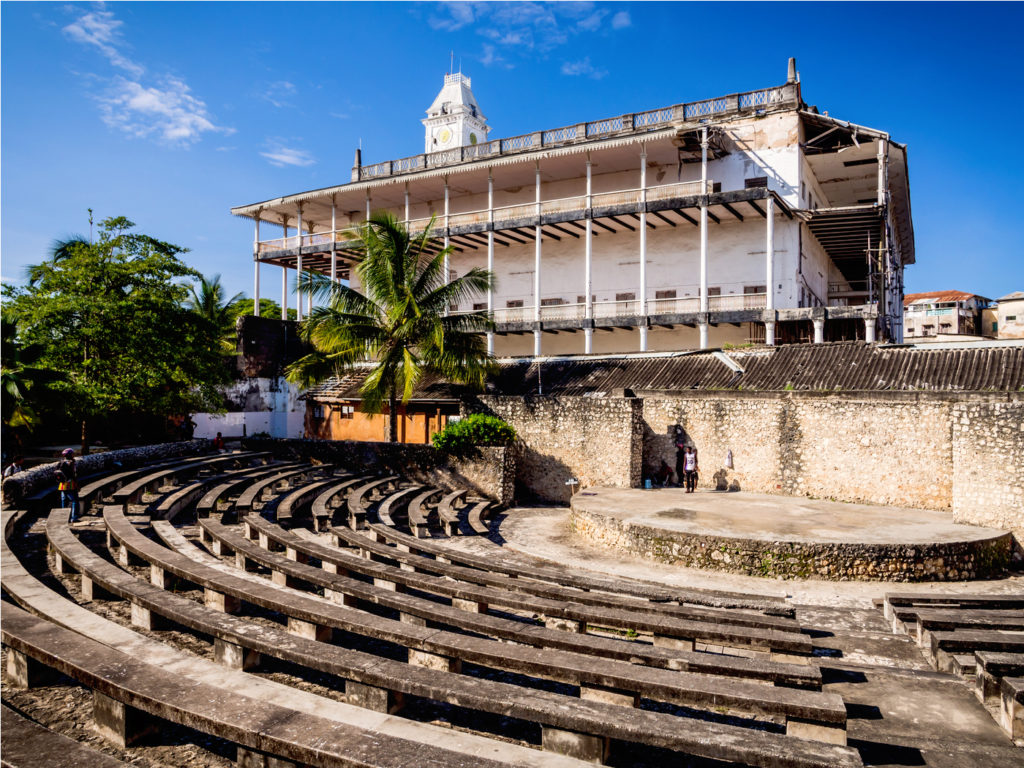
Making a jump to a bit more local history, wander up to the Old Fort, otherwise known as the Arab Fort. The oldest building in Stone Town, the Old Fort was built in 1699 and has been used as a prison and a train terminal, among other things, over the years. Today, it’s well set up for tourists and it even has a visitors’ center and a restaurant.
Across the street from the Old Fort, you’ll find the House of Wonders and the Palace Museum, two of Zanzibar’s landmark museums. They’re both culturally significant, the former being the most modern building in the archipelago at one point in time, and their architecture combines European and Zanzibari styles, adding to their sublime uniqueness. Make sure you take a moment to have a look at these buildings when you leave the Old Fort. Viewing them from the outside should be sufficient, however, because they’re not as well kept as the fort, so don’t waste too much time here!
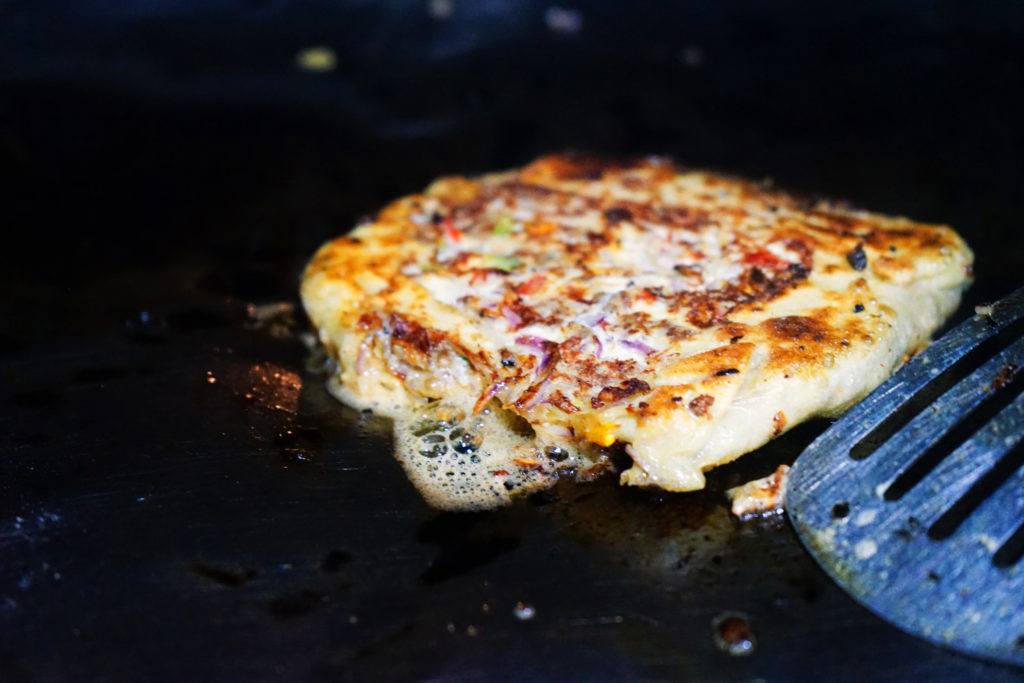
End your day with a cultural experience that is sure to be an absolute blast! By now, you’re bound to be absolutely dying to try some local Zanzibari street food, and where better to do this than at a local night market? As the sun sets, the Forodhani Gardens, located at the Palace Museum, transforms into a hustling and bustling food market.
Here, you’ll be able to spend the evening wandering around, meeting locals, and trying out some of the most interesting and delicious food! My favorite things are Zanzibari pizza (which is nothing like a typical pizza), Chapatti, and Urojo! My mouth is watering just thinking about these delicious treats.
Where to stay in Stone Town: Stone Town boasts loads of accommodation options, but I personally think that since you’re going to be doing a lot of exploring and spending significant time outdoors, it’s nice to have a really nice and comfortable place to stay – that’s why I’d recommend Sharazad Wonders Boutique . Its location is super central – only 150 meters from the main beach and close to the Old Fort – and it offers handy extra services like the use of free bikes and air-conditioning in the rooms.
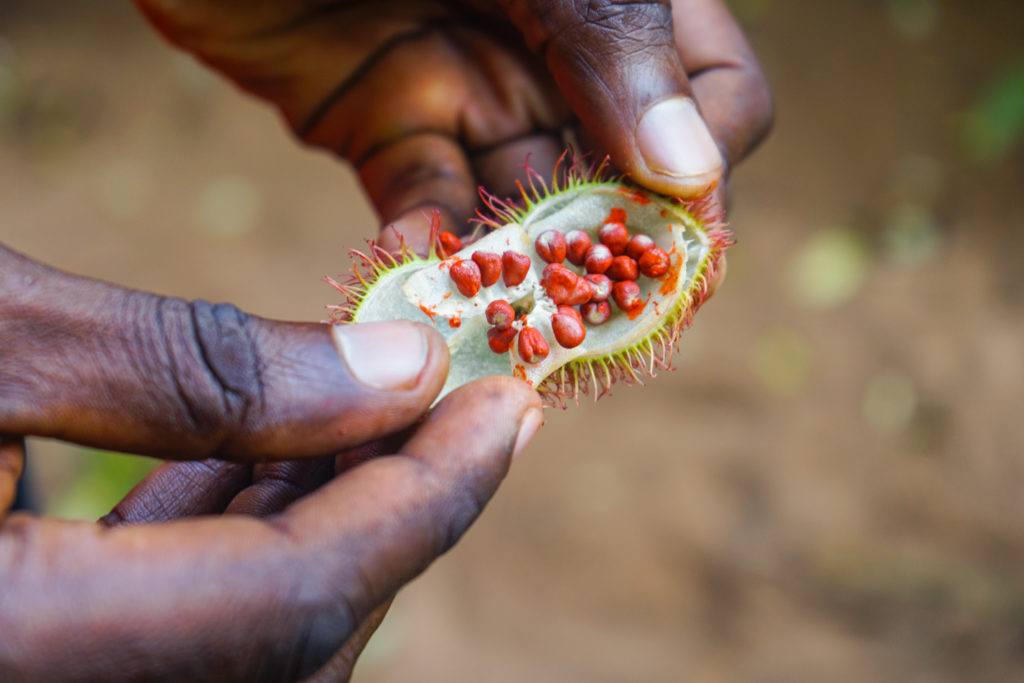
Day 2: Traditional Spice Tour from Stone Town
No trip to Stone Town is complete without a traditional spice tour! Now, I was a little bit skeptical when I was first told that I had to do a spice tour while in Zanzibar – I’m not particularly interested in spices, nor am I much of a cook (or so I’ve been told). Luckily, however, my curiosity got the better of me and I did it anyway, and boy am I glad it did!
A Zanzibari spice tour is about more than just spices, it’s a full-on cultural experience. Not only do you get to see and try a vast array of traditional spices, but you get to spend the day with locals away from the business of the town, cook with them, and even share a meal.
Your morning starts at 9:00 where you’ll meet your guide at the entrance of the Old Fort – yes, the one you visited yesterday. From there, you’ll be driven out to the spice farm by means of their arranged transport, so you don’t have to worry about a thing. Best of all, the journey is fairly quick, 20 to 30 minutes maximum, and you’ll get to see Stone Town from a different vantage point along the way.
When you arrive, your guides will show you around the farm, telling you all about their different spices – you can even taste them fresh from the fields which I’d highly recommend. You’ll see things like vanilla, cardamom, and nutmeg that ought to be familiar to you, as well as a few more unusual things as well, it’s all part of the fun.
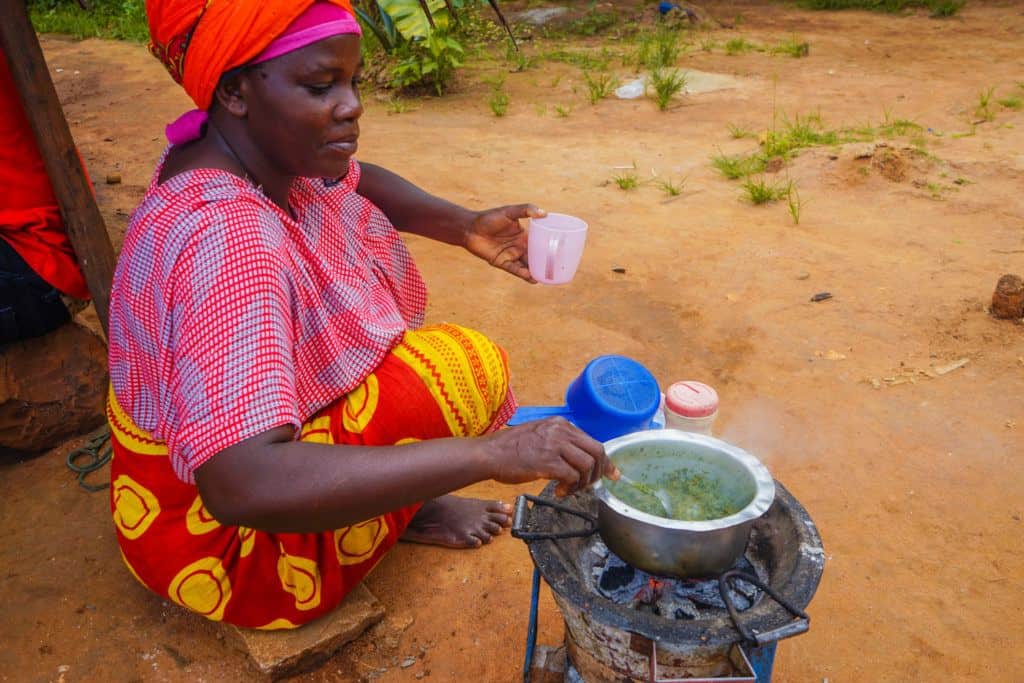
After the tour, you’ll be invited to take part in a cassava leaf harvest, a coconut milk-making tour, and finally, you’ll have an intimate cooking lesson with the locals, using a collection of local ingredients and spices. As if the cooking lesson wasn’t fun enough, you get to eat the final product!
But in all seriousness, I really believe that few traveling experiences come close to sharing a meal with locals, no matter where you are in the world. And here, you get to (literally) break bread with people from a completely different walk of life as they share with you their culture and traditions. It really is an epic experience!
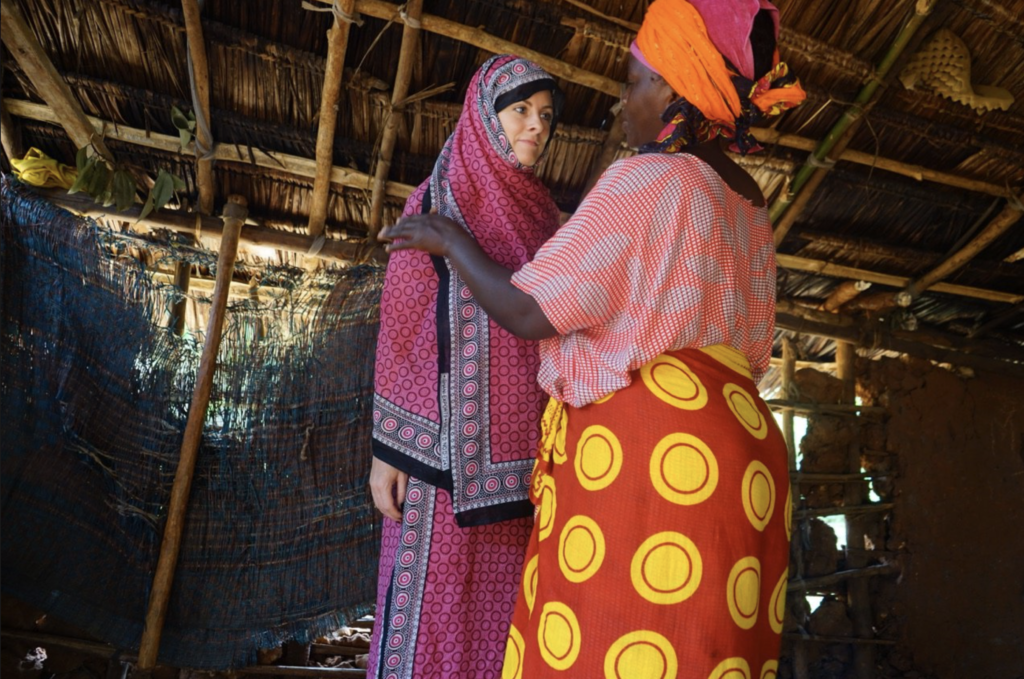
However, from a practical perspective, be warned that you’ll be spending much of the day in the sweltering sun. So make sure you take a hat, sun cream, water, comfortable shoes to walk in, and cash to buy some spices of your own afterward!
You’ll get back to the Fort in the afternoon and will most likely be rather knackered, so I’d suggest that you spend the rest of the afternoon chilling. But if you do feel up to doing something more, consider checking out the Persian baths, the Malindi Mosque, St. Joseph’s Catholic Cathedral, or just going for walk along the beach.
When you’re ready for dinner, I found that the best way to find the most delicious food was to simply take a stroll around town until you found something you like the look of. The streets are bustling in the evenings, and you’ll have no trouble finding a place for dinner – whether you grab something from a street vendor or sit down at a proper restaurant!
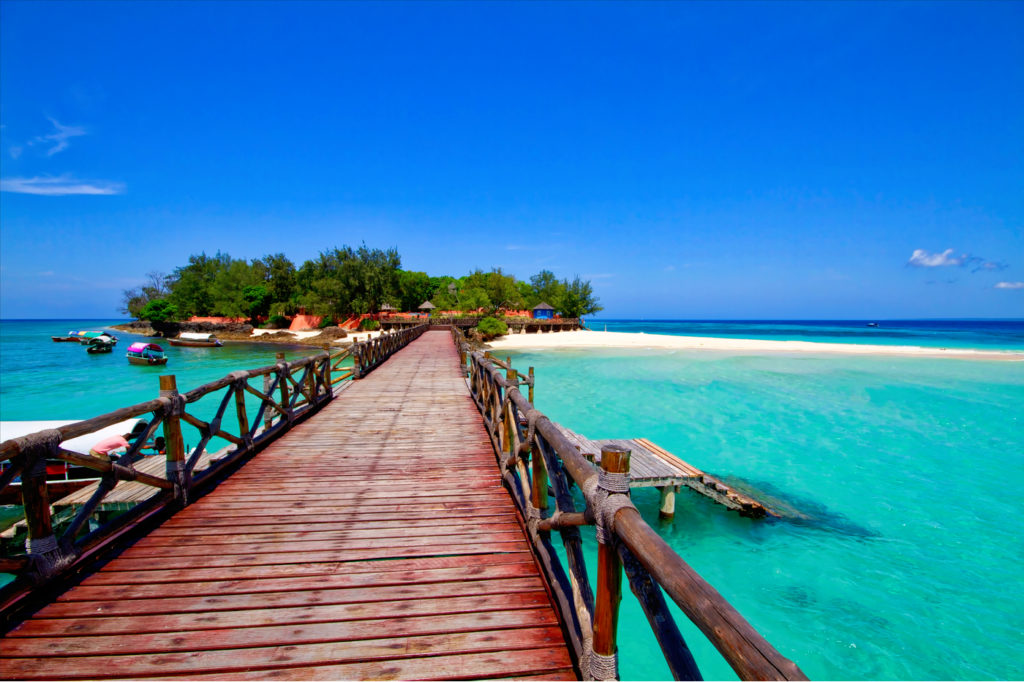
Day 3: Changuu Island Day Trip from Stone Town
Get ready for a proper island-style day out when you do a day trip to Changuu Island . Meet at the Old Fort in the morning (yeah, it’s a common meeting place for tours) and you’ll be taken down to the coastline where you’ll hop on a little boat and your guide will drive you out to the island. Although the boat itself is nothing special, it’s always fun to be out on the water. And don’t panic if you get seasick, it’s not a long ride and you won’t spend any time bobbing around!
Changuu Island, colloquially known as Prison Island, is incredibly significant in Zanzibar, naturally, culturally, and historically. The island was purchased by Lloyd Matthews, Zanzibar’s first-ever British Prime Minister back in 1893, and its initial purpose was, you guessed it, to be a prison. However, these plans didn’t materialize and the island was later used as a location for local yellow fever patients to quarantine – yikes!
When you arrive, you’ll be able to wander around and learn about the local history from your guide. But it’s not all about colonial history! Animal lovers will be pleased to hear that the island is inhabited by at least 50 tortoises. In fact, some will be older than you, as there are even a few who are older than 100 years old! You’ll be able to see the local animals and even feed them if you’re brave. Your guide will give you some background as to what these little guys (who aren’t always so little) are doing there. And keep an eye out for peacocks and antelope too!
Once you’ve seen and learned about the island, wander back down to the beach to cool off in the picturesque waters. Your guides will even bring along snorkeling gear, so if you’re keen to check out what’s below you, grab some goggles, flippers, and a snorkel and hit the water!
When you’re tired, lunch will be waiting for you, cooked for you by your guides. You’ll have the pleasure of enjoying a traditional Swahili feast including local fare, a seafood BBQ, fresh fruit, and delicious cheeses.
After your lunch has settled, you’ll jump back on the boat and enjoy a leisurely ride back to the main island. You’ll probably be full from lunch, so if you’re not too tired, wander around and find a spot on the beach for some sundowners – I’d suggest 6 Degrees South or Mercury’s – and get an early night.
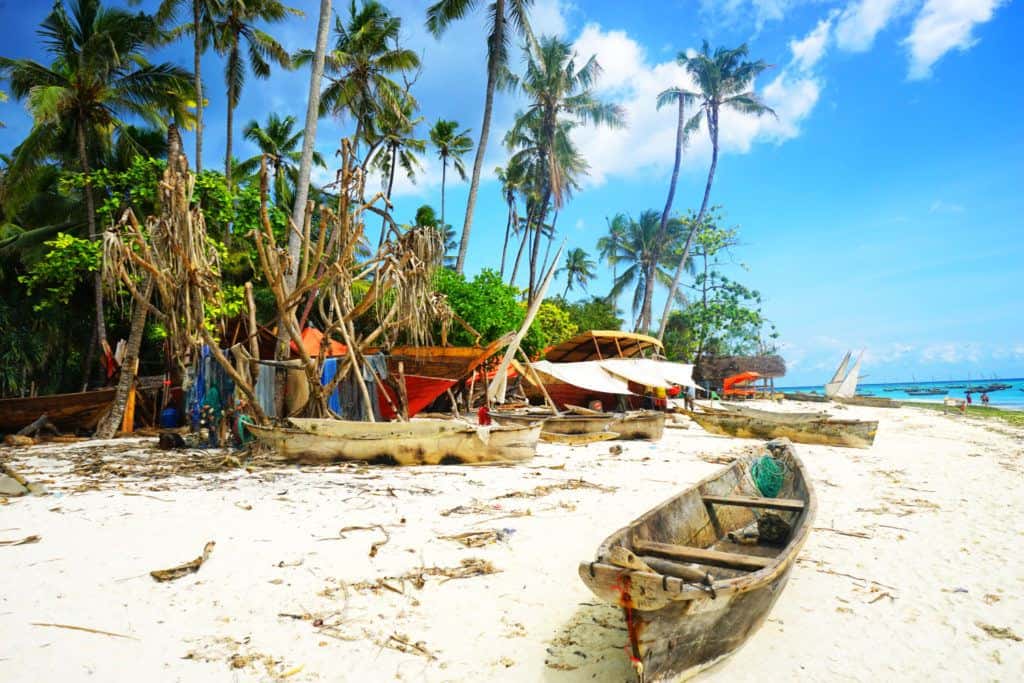

Day 4: Chill Out on the Coast at Nungwi
Start your day bright and early and head up north to Nungwi. There are four ways to get there – by bus, shuttle, taxi, or rental car. When I did the trip, I hired a car and drove myself because I wanted the freedom to stop as I liked. But if you’d rather let somebody else do the driving, my recommendation would be to pre-order a taxi. You can take a bus or shuttle, but you may be in for some delays, multiple stops, and just a generally full and uncomfortable journey. Of course, it’s all about preference! But if you are going to take a taxi, make sure you book it in advance and settle on a price beforehand – this goes for the rest of your trip too!
When you arrive (the drive is only about an hour and fifteen minutes if you go directly), check into your accommodation and spend the day exploring the village and relaxing on the beach.
If you’re an active person, however, and sitting still just isn’t your cup of tea (I get it, I always need to be busy), there are loads of things you can do without going too far. Head down to Nungwi Beach and you’ll find loads of space to lay down your towel and read a book, as well as several operators offering cool things to do. This may include things like hiring snorkeling or diving gear or going surfing.
For dinner, I’d highly recommend, um, Sexy Fish Restaurant. They serve the most delicious African-European fusion seafood made with locally sourced ingredients – it’s to die for.
Where to Stay in Nungwi: Nungwi is a fairly touristy part of the island – by Zanzibar’s standards – but Canary Nungwi Hotel and Spa is the perfect escape from the business you may experience elsewhere. It’s only a few hundred meters away from Nungwi Beach and a few kilometers from Royal Beach and Kendwa Beach (which, by the way, is divine).
Canary Nungwi Hotel is one of my personal favorites, not only because of its location but it’s got a laid-back vibe while still offering you all the amenities you need. It even has its own restaurant, so if you’re needing a quick and easy meal, you don’t have to go far. And their food is delicious too!
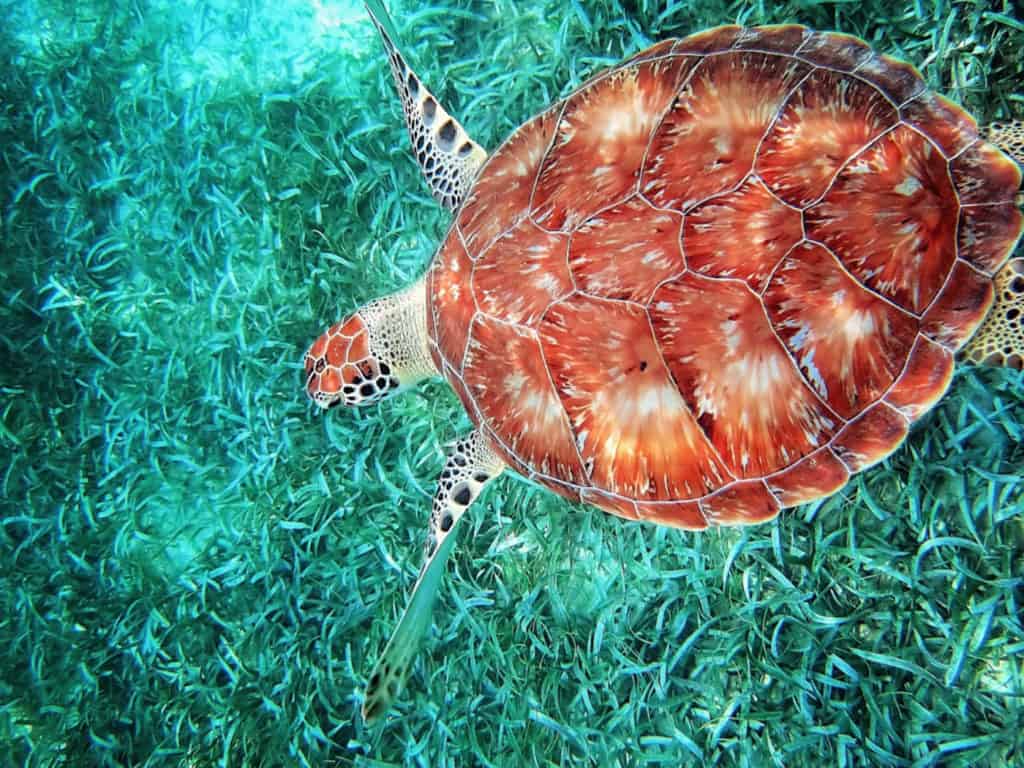
Day 5: Visit the Turtles and Go for a Sunset Dhow Cruise
You’ve seen local tortoises, and now it’s time to hang out with their aquatic counterparts! Visit the Mnarani Marine Turtle Conservation Pond in Nungwi, a natural aquarium, and see these little local wonders with your very own eyes.
At the conservation pond, you’ll be able to learn all about the local turtle population and the aquarium’s conservation efforts. If you’re keen, you’ll even be able to feed and swim with the turtles – a truly special experience! Entrance fee is $10 which goes towards their conservation efforts, which is pretty worth it if you ask me.
Spend the afternoon relaxing on the beach and in the sun before heading out on a sunset dhow cruise . In my humble opinion, this was one of the coolest things I got to do while in Zanzibar. Being out on the open ocean in a traditional Zanzibari dhow with a glass of wine – it doesn’t get better than that. Depending on the weather, you may even have the option of jumping in the water for a snorkel when you arrive at the reef, and you’ll be serenaded with local live music on the boat while you enjoy your sundowners.
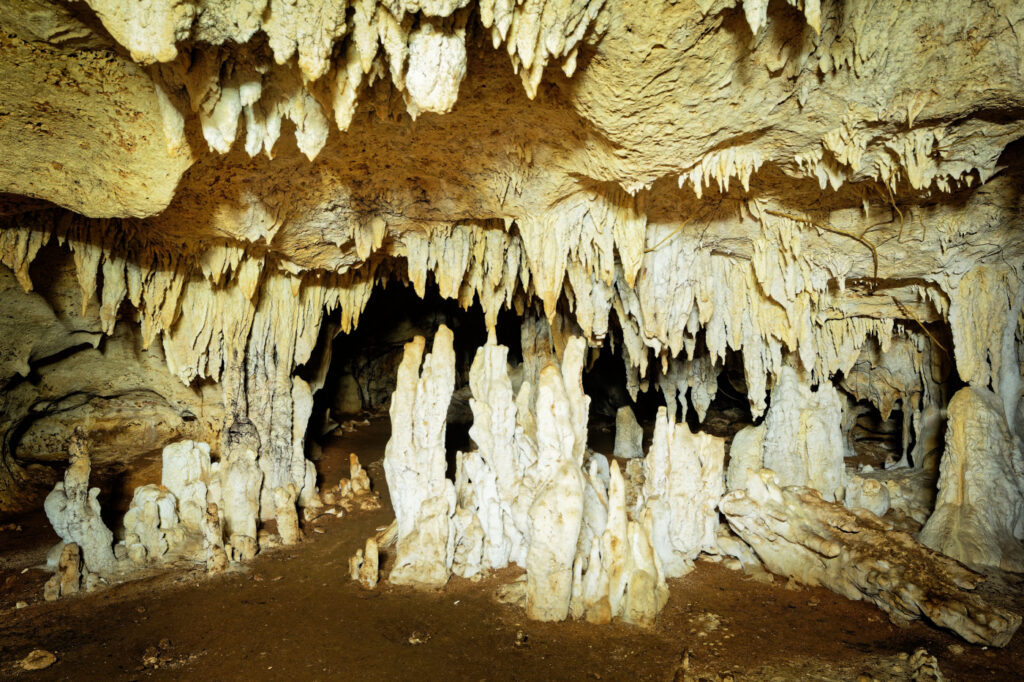
Day 6: Visit the Kiwengwa Caves on the Northeastern Coast
It’s time to hit the road – you’re going to Kiwengwa! This is when it comes in handy to have hired a car, but don’t fret if you don’t – you can, once again, pre-order a taxi (for about $25) or catch a local bus. It’ll only take you about 45 minutes to get there.
Kiwengwa is a popular destination for tourists, and it’s no wonder why. It boasts a gorgeous beach and several cool attractions – also, the beaches in the North Eastern part of Zanzibar are known to be the best, and I can absolutely attest to that!
When you arrive, drop off your bags and enjoy a relaxing morning. Then put on some active clothes, comfy shoes, and get ready to do some exploring, because you’re going to the Kiwengwa Caves!
There are actually two caves – one is 150 meters long and the other is 200 meters long – and they differ in shape and height. They’re a pretty awe-inspiring sight and when you get there, you’ll be surrounded by bats and exquisite birds, making this an epic excursion for animal lovers, especially ornithologists. The caves are full of massive trees and their roots, as well as stalactites hanging from the roof of the caves.
Spend the afternoon exploring the nearby little village of Pongwe. It’s a quaint local village with a beautiful beach boasting pristine, calm waters and a protected coral reef. Wander around the village and meet the locals, and spend some time lazing around on the beach and in the water.
Head back to Kiwengwa and have dinner at La Base Jungelkite, a local seafood and fish restaurant. Now, don’t be thrown off when you realize it’s also a kitesurfing school – their food is excellent and there’s always a cool atmosphere!
Where to stay in Kiwengwa: When you’re visiting Kiwengwa, you absolutely have to stay at Ndoto Africa Bungalows . Here, you’ll be treated to all the comforts of home along with a typical East African touch. The rooms are separate little bungalows so you can enjoy your privacy and there’s a lovely pool that you’re sure to want to use to cool off after long, hot days in the sun.
Their breakfasts are also an absolute must – they serve a variety of options, including an a la carte menu, continental breakfast, as well as several Italian-style options if you’d like to try something different.
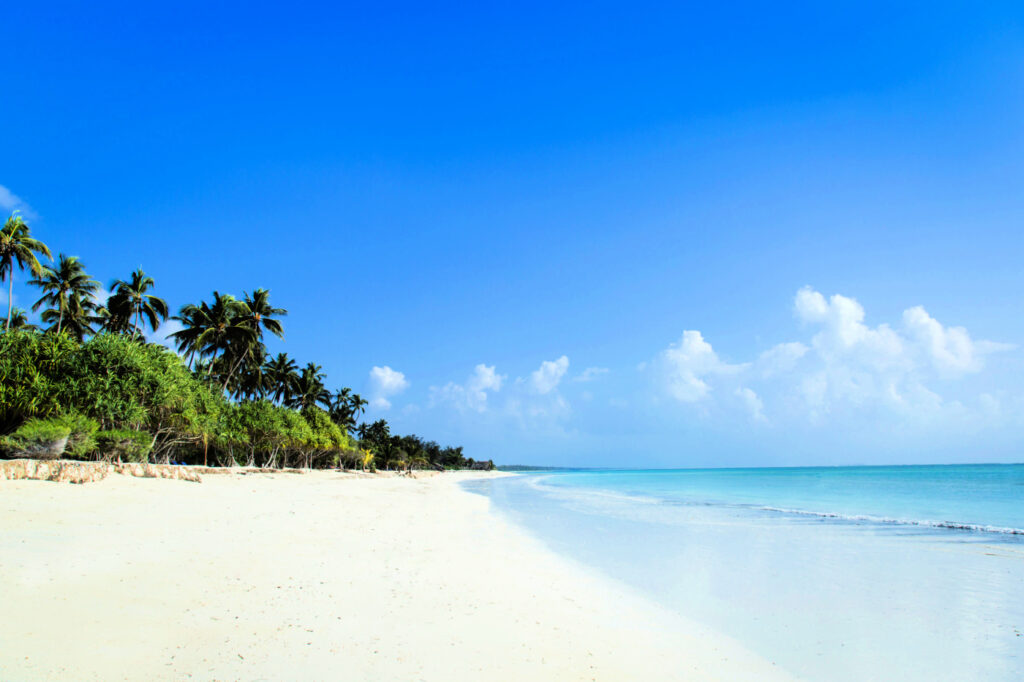
Day 7: Kiwengwa
Today is all about relaxing. After all, Kiwengwa, along with the rest of the northeastern coast of Zanzibar, is renowned for its sublime beaches and epic swimming spots. And after a busy week, you’re most likely aching for a day in the sun and the sand doing whatever the heck you want.
So, start your morning in the most relaxing way possible and down to the Yoga Bar. Enjoy a yoga class at the beach at this special family-run establishment and stick around for a coffee and a healthy breakfast afterward.
Spend the rest of the day hanging out on the beach and taking a walk out on the sand banks at low tide. Hit the water and do some snorkeling, or, if you really feel like being active, why not try out a kite surfing lesson? I’d recommend either making your way back to La Base Junglekite or try out One Love Kite Surfing – they’re both popular kite surfing schools and you’re bound to have a fun day out!
In the late afternoon, head to the Beach Lounge for sundowners and enjoy a laid-back evening.
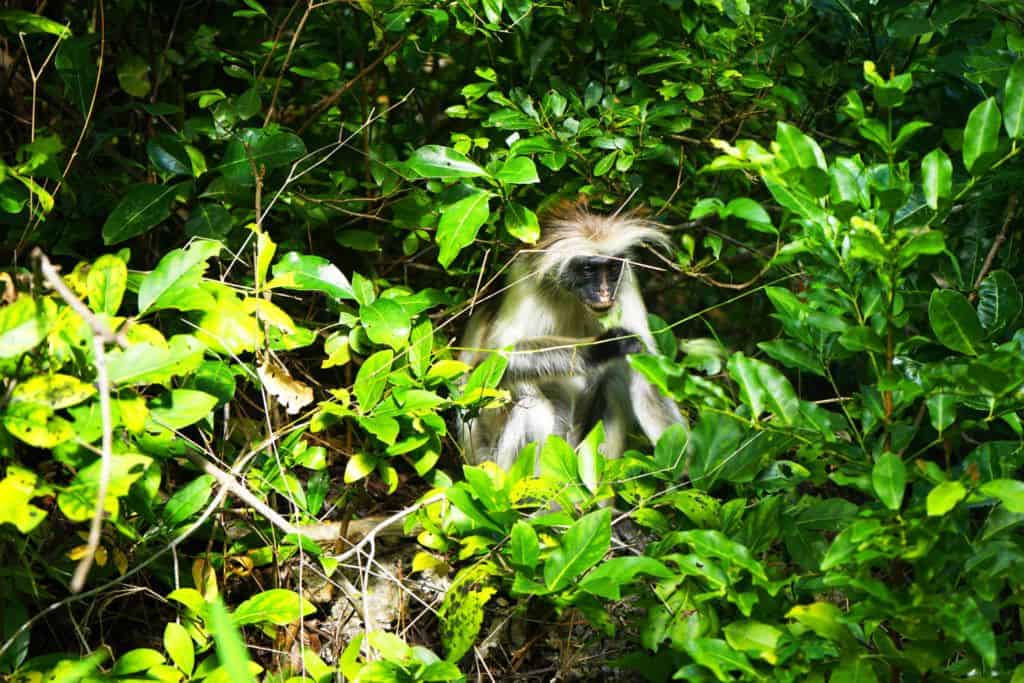
Day 8: Visit Jozani Forest from Jambiani
Hit the road and head from Kiwengwa to Jambiani – the drive should take you just over an hour (if you travel directly) and a taxi will cost you between $35 and $40. Jambiani is a quaint little village, slightly quieter and less touristy than some of the northeastern parts of Zanzibar. It’s known as a fishing and seaweed farming village and wandering around the streets and up the seven-kilometer-long beach is a beautiful and fascinating experience.
Spend the morning exploring the village, enjoying the beach, and frolicking in the water before getting ready to head out for a little afternoon adventure. Make sure you’re wearing comfortable clothes head on out to Jozani Forest – either drive or hop in a taxi. The forest is located inside Jozani Chwaka National Park – Zanzibar’s only national park.
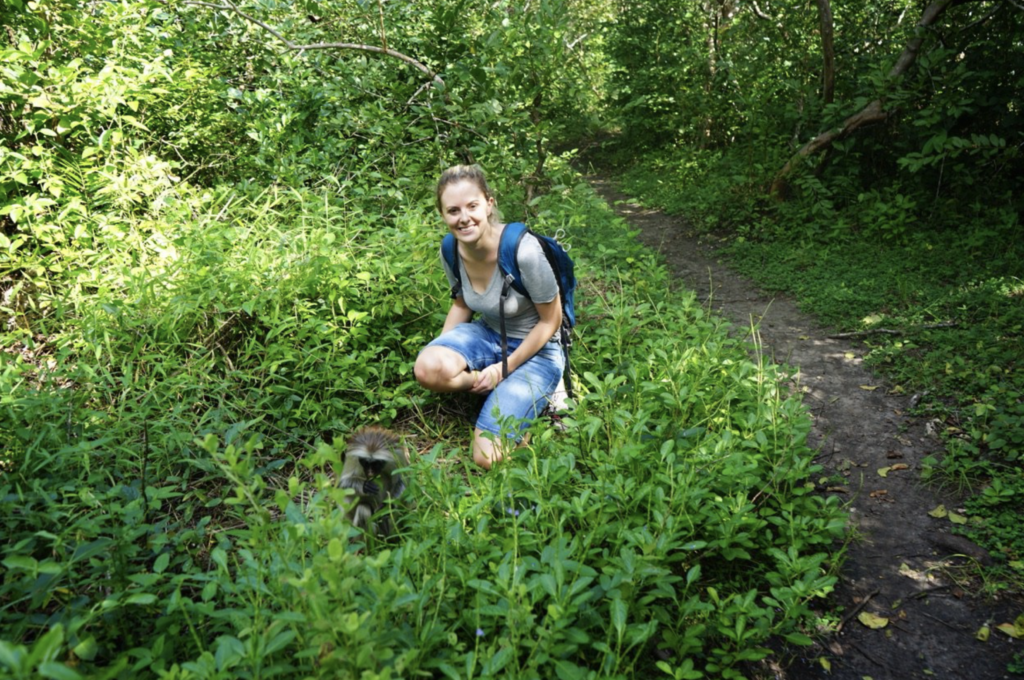
For the full experience, I would absolutely recommend doing a guided forest tour. That way, you’ll be shown around the forest by a local guide, and they’ll tell you all about the natural vegetation and the wild animals that call the forest home. One of the most unusual animals you’ll see are Red Colobus Monkeys – they’re only found in Zanzibar, so they’re a pretty special sight!
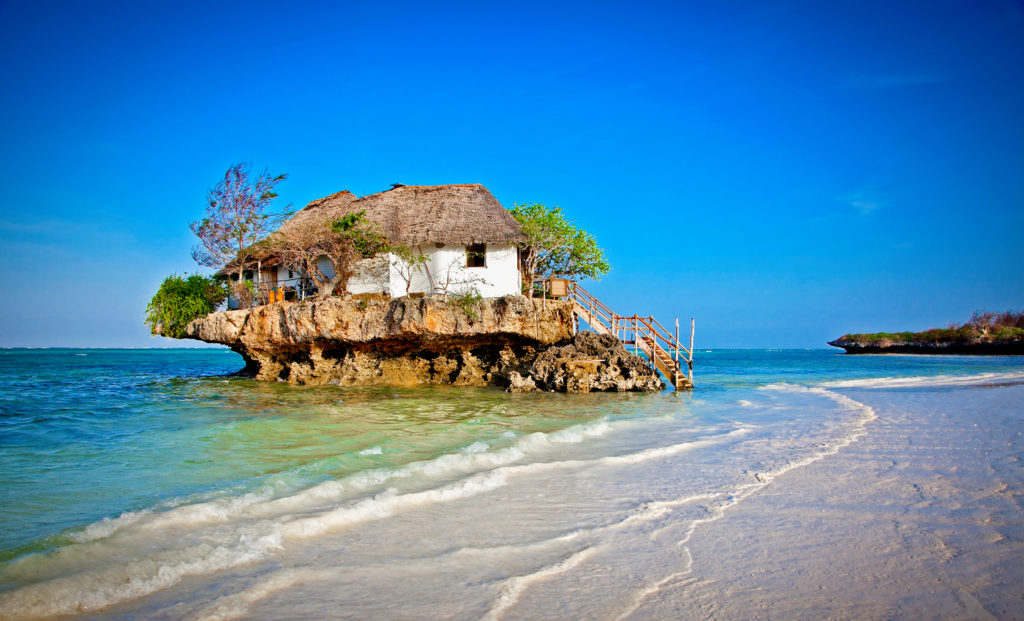
After your day in the forest, head back to Jambiani to enjoy an evening on the beach. If you’re into seafood, I’d highly recommend going to Casa Del Mar – they serve Sea Cigal which is a local breed of lobster, and it’s absolutely to die for! And if you’re into Instagrammable settings, take a taxi up to the Rock for dinner: the instafamous restaurant that’s located on a rock in the ocean!
Where to stay in Jambiani: Since you’re only staying one night, why not treat yourself to a full-on resort experience? And there’s no better place to do it than at Zen Boutique Resort .
The resort offers visitors everything you could possibly dream of – from a pool with crystal clear water to a top-notch restaurant and vibey bar. Ideally, it’s only about 30 kilometers from Jozani Forest and there’s even a shared lounge, which I’ve always found is a really fun way to meet other travelers!
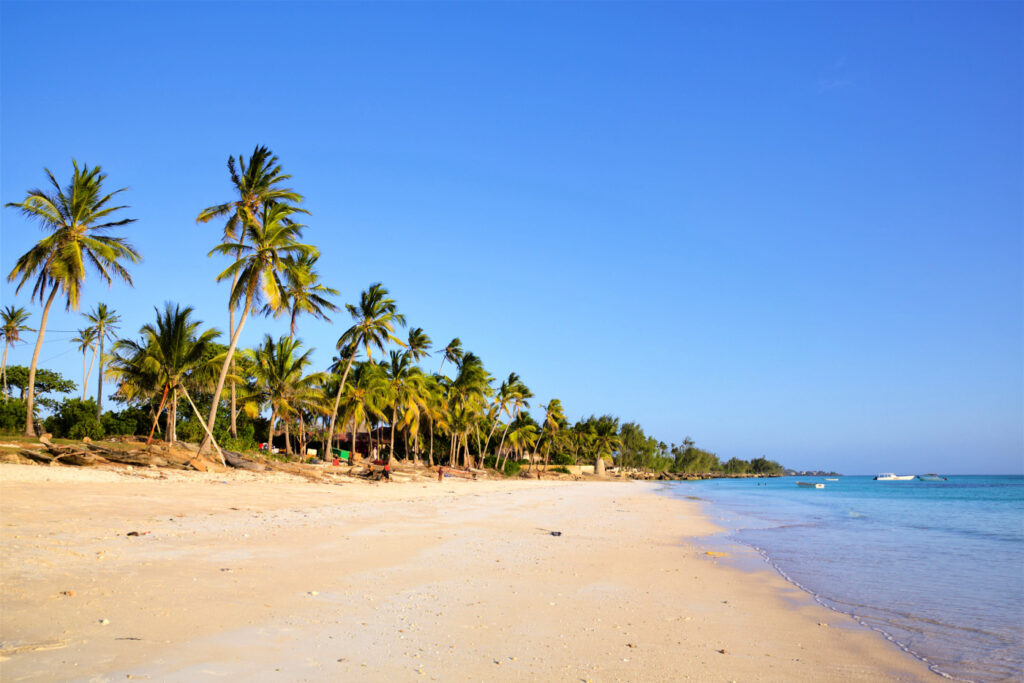
Day 9: Enjoy the Beach at Kizimkazi
The time has come for you to head to your final destination of your trip to Zanzibar – Kizimkazi. It’ll only take you about half an hour to get there (once again, either by driving yourself or by taxi) so have a slow morning in Jambiani before you head down south.
Kizimkazi is the ideal place to relax and just enjoy the tropical paradise that is Zanzibar during your second last day on the island. My favorite beach to visit when I was there was Aya Beach – it may not boast the white sandy beaches you see on postcards, but I actually think that in many ways, it’s better! It’s a beautiful piece of shoreline and you can walk along the beach no matter the tides.
Spend the day enjoying the outdoors and hanging out on the beach. If you’re feeling adventurous, why not go snorkeling? The water is warm and it’s crystal clear!
For dinner, head down to Mnana Lodge. Here, you’ll find an awesome spot that serves Italian-Zanzibari fusion food – it’s exactly what you never realized you’ve been missing in your life! Honestly, the food is incredible and it’s super well-priced, you simply can’t go wrong with Mnana Lodge.
Where to stay in Kizimkazi: Last but certainly not least is Kamelon Blue in Kizimkazi – my favorite place that I’ve stayed at on the island! Kamelon Blue just has such a cool atmosphere. It’s relaxed but professional, and you’ll have access to a gorgeous pool and cool bar on the property (make sure to try out a few of their signature cocktails, they’re amazing).
The setting is absolutely gorgeous, with the private rooms situated in and amongst greenery all around the property, so walking back to your room tonight makes you feel like you’re in the middle of the forest!
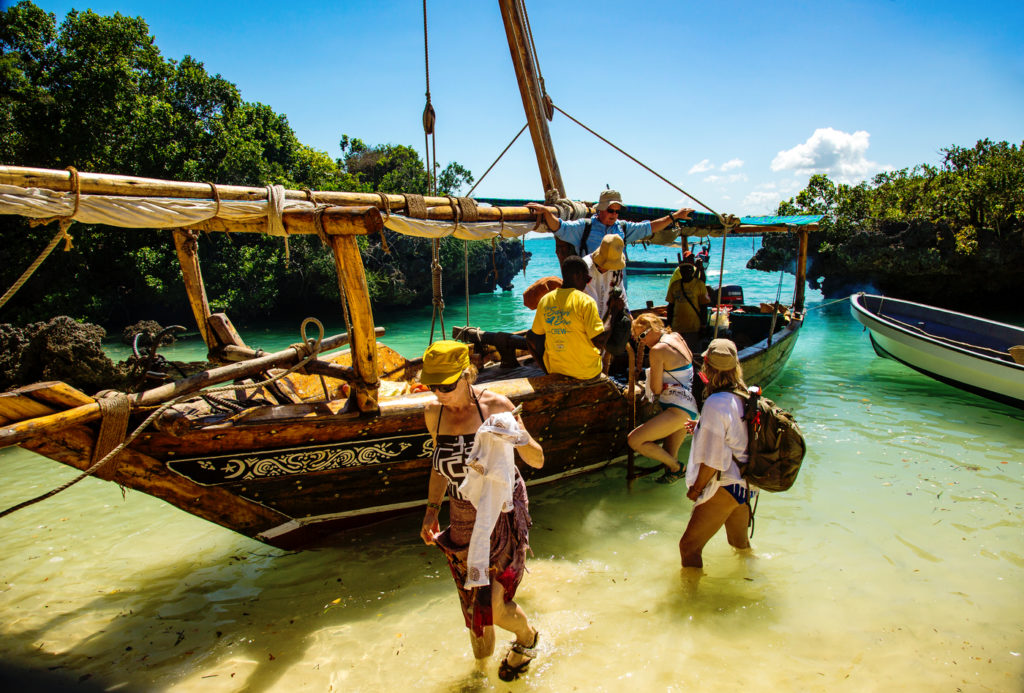
Day 10: Enjoy a Blue Safari
It’s your last day in Zanzibar, but don’t let that get you down! Spend your final morning going on what the locals call a blue safari – a day trip on a boat to marvel at some of the island’s most incredible scenery and wildlife! Best of all, you’ll even get to hop in the water and come face-to-face with some of them.
Now, before you head out, it’s essential that you’re properly prepared – it gets pretty darn hot out there, so make sure you pack a hat, sun cream, and clothing that won’t make you too hot. Definitely wear a swimsuit and if you have a second skin, take it along! The last thing you want is to get a gnarly sunburn just before you have to travel home.
When you’re deciding which tour operator to pick, my advice is to look carefully at what the tours include and make a decision based on how long you want to be out on the water and which activities most suit your interests. Some of the activities they include are visiting Menai Bay which is Zanzibar’s largest marine protected area, going snorkeling in special locations, viewing dolphins, and even swimming with dolphins. Some will offer all, especially if it’s a private tour, while others tend to focus on either sightseeing at Menai Bay and learning about the conservation side of things or swimming with the dolphins.
Honestly, all these options are epic. But since you have limited time, I’d say you should prioritize swimming with the dolphins. I mean, how often do you get that kind of opportunity?
After a special day out on the water, surrounded by phenomenal scenery and beautiful animals, you ought to feel pretty fulfilled! And while you may be sad to leave, the one upside is that your trip back out to Stone Town, from where you’ll depart (either by plane or ferry) will only take you about an hour by taxi.
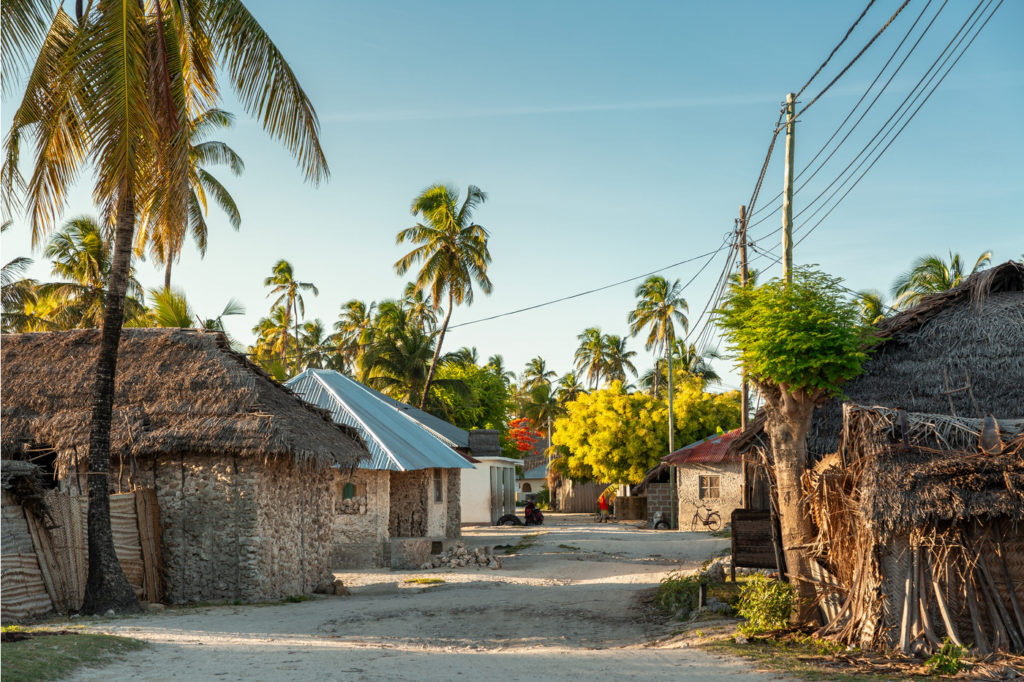
Final Thoughts on How to Spend 10 Days in Zanzibar
Well, there you have it! I’ve done a fair bit of traveling in different parts of the world, but there’s just something special about Zanzibar. It’s the locals, the food, the incredible scenery, and the fact that the archipelago has such a rich and deep history just waiting to be explored. The true essence of Zanzibar is tangible wherever you go and whatever you do, and in my opinion, it’s something that everybody should experience.
So, now that you’ve heard my take on the best way to see Zanzibar in ten days, all there’s left to do is start booking and pack your bags!
Lauren Juliff
Lauren Juliff is a published author and travel expert who founded Never Ending Footsteps in 2011. She has spent over 12 years travelling the world, sharing in-depth advice from more than 100 countries across six continents. Lauren's travel advice has been featured in publications like the BBC, Wall Street Journal, USA Today, and Cosmopolitan, and her work is read by 200,000 readers each month. Her travel memoir can be found in bookstores across the planet.
Related Posts

The Cost of Travel in Mauritius: My Detailed Budget Breakdown

How to Spend One Week in Mauritius: An Itinerary for First-Time Visitors

Why You Need to Take a Game Drive in Swaziland/eSwatini

Exploring Kolmanskop: Namibia’s Ghost Town in the Desert

In-Depth Namibia Travel Guide: What’s it Like to Travel in Namibia?
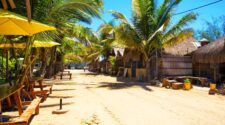
Introducing Tofo: My African Beach Paradise
Leave a reply cancel reply.
Your email address will not be published. Required fields are marked *
Meet Lauren Juliff
+255 757 40 40 77
Kwerekwe St, Zanzibar, [email protected]

Visit Zanzibar: Ideal Destination for a Dream Vacation
Discover things to do, places to visit, and experiences to explore when visiting zanzibar. learn about zanzibar's natural beauty, culture, and attractions., get free travel advice, exclusive deals, and discounts in your inbox, paradise awaits, what is zanzibar famous for.
Zanzibar is an archipelago located off the coast of East Africa in the Indian Ocean, and it is a semi-autonomous region of Tanzania. It is renowned for several notable features:
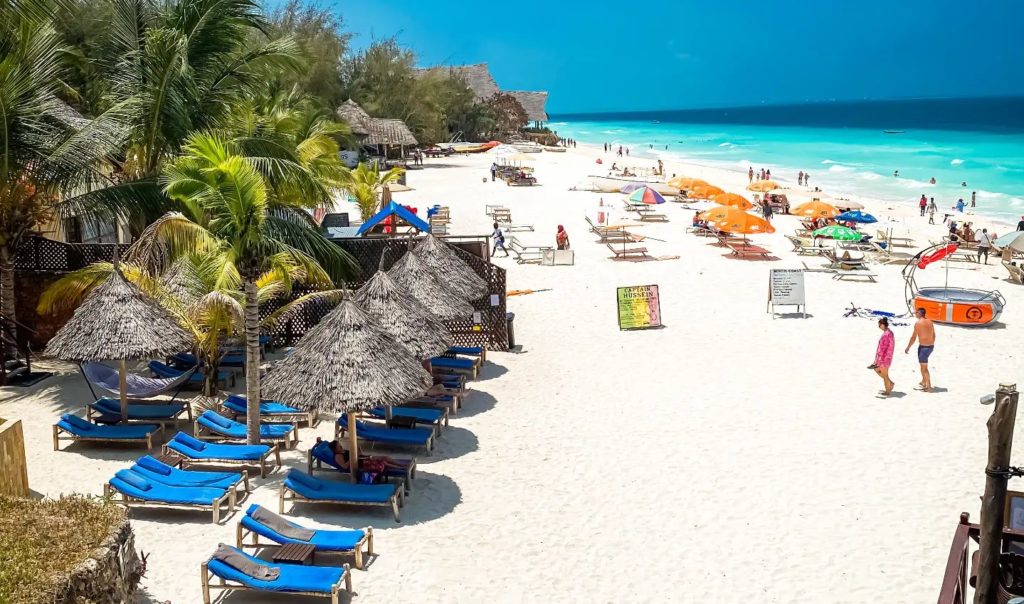
Beach Bliss
. The archipelago is home to some of the world's most beautiful and untouched coastal stretches. With powdery white sands and waters as clear as crystal, destinations like Nungwi, Kendwa, and Paje offer a paradise for sun-seekers and beach lovers.
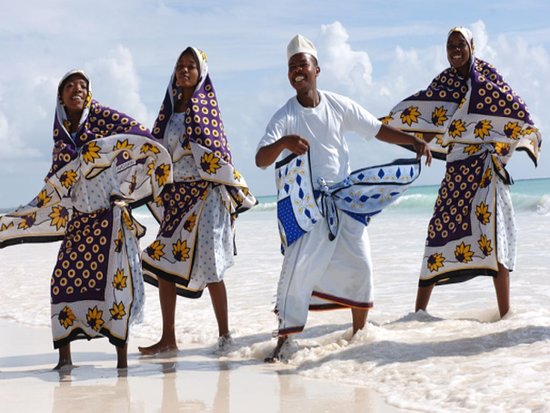
Cultural Riches
Zanzibar's rich history is a tapestry woven from African, Arab, and Indian influences. This unique blend is evident in the island's architecture, cuisine, and vibrant street markets. In the heart of Zanzibar City lies Stone Town, a UNESCO World Heritage site
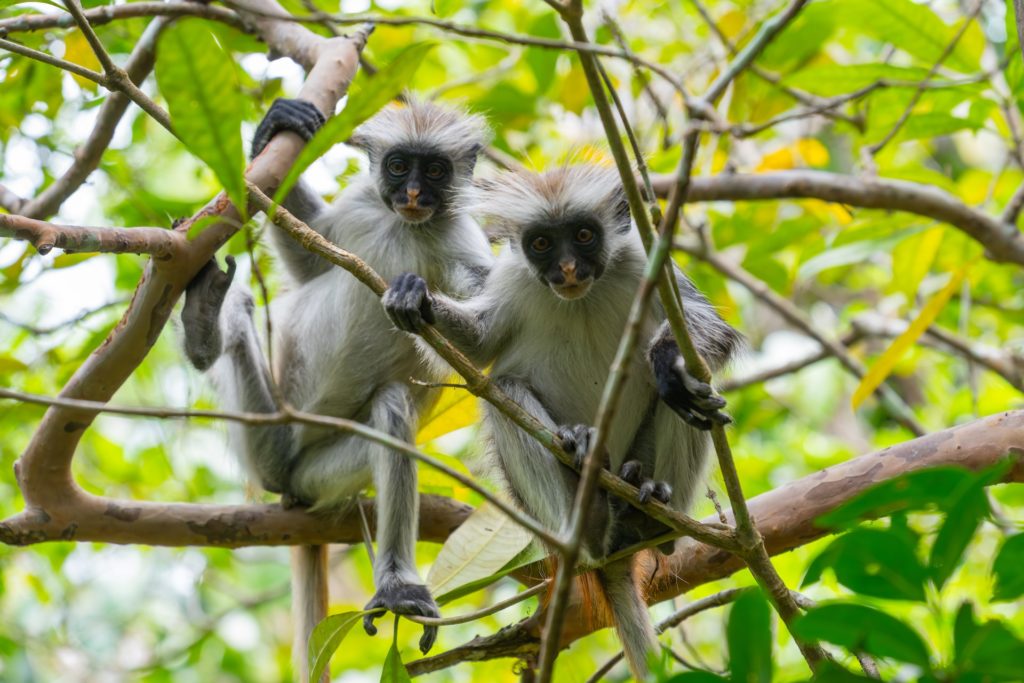
Natural Wonders
Zanzibar's natural beauty is a marvel to behold. Its landscapes are diverse, from the lush mangrove forests to tropical rainforests. Coral reefs along the coastline make for breathtaking snorkeling and diving opportunities, showcasing the vibrant marine life that thrives beneath the surface
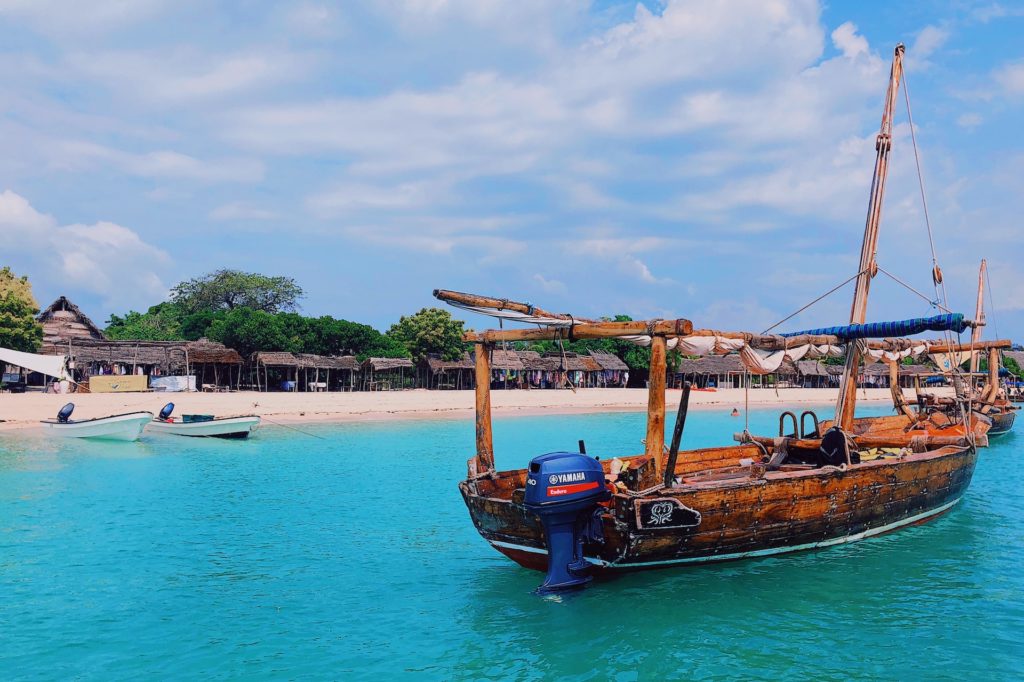
Thrilling Activities for All
For adventure enthusiasts, Zanzibar offers an array of activities. Water sports like diving, snorkeling, kite surfing, and deep-sea fishing are readily available. Nature lovers can explore the island's forests, go hiking, or embark on boat excursions to nearby islands.
About Zanzibar
Tucked away in the azure waters of the Indian Ocean, Zanzibar is an archipelago that captivates travelers with its pristine beaches, rich culture, and a unique blend of natural wonders
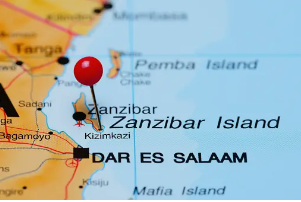
Where is Zanzibar and How to Get There?
Zanzibar’s geographical coordinates are approximately 6.1654° S latitude and 39.1989° E longitude, southern hemisphere, just south of the equator

Is Zanzibar Worth It?
Zanzibar, the very name conjures images of pristine beaches, cultural riches, and the unmistakable scent of exotic spices carried on the ocean breeze. But, as you contemplate your next travel destination, you may wonder, "Is Zanzibar worth it?" The answer, unequivocally, is yes.

Perfect Time to Visit Zanzibar: A Seasonal Guide
Zanzibar, with its breathtaking beaches and rich cultural heritage, beckons travelers year-round. However, understanding the distinct ....
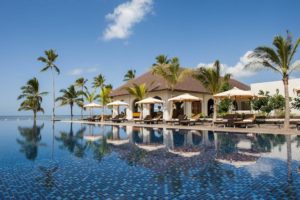
Frequently Asked Questions About Zanzibar
Whether you're considering a visit, planning your dream vacation, or simply curious about this captivating archipelago, this FAQ guide is here to answer your questions and offer insights into all things Zanzibar
Explore Zanzibar: The Spice Island
Embark on a journey of discovery as you explore the diverse treasures of Zanzibar. From pristine beaches to rich cultural experiences, this is your gateway to the Spice Island's wonders. Uncover Zanzibar's allure and plan your adventure today
Where to Stay in Zanzibar?
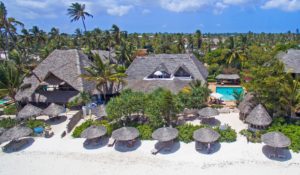
Choosing where to stay in Zanzibar is a vital decision for your island getaway. Explore the unique characteristics of each side of Zanzibar, from bustling beaches to tranquil escapes, to find your perfect slice of paradise
Things to Do and See in Zanzibar

Uncover an array of exciting activities and experiences that await you in Zanzibar. From water sports to cultural adventures, this page is your guide to creating unforgettable moments on the Spice Island
Best Beaches in Zanzibar
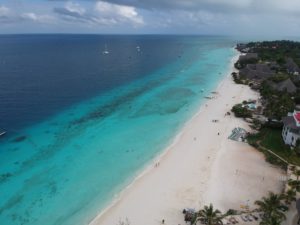
Explore the enchanting beauty of Zanzibar’s best beaches, from Nungwi’s golden sands to the serene shores of Paje and the vibrant vistas of Kendwa. Let us guide you to the finest coastal retreats the Spice Island has to offer
Pemba Island, Zanzibar

While Zanzibar often takes the spotlight, nestled to the north is a lesser-known paradise waiting to be discovered. With lush landscapes, serene beaches, and a sense of untouched beauty, Pemba Island offers a unique and enchanting escape.
Popular Tours and Excursions in Zanzibar
Discover the best of Zanzibar with our curated selection of popular tours. From exploring the historic treasures of Stone Town to embarking on a marine adventure with the Safari Blue Tour, there's a world of experiences waiting for you

Zanzibar Spice Tour: A Journey Through Aromatic Delights
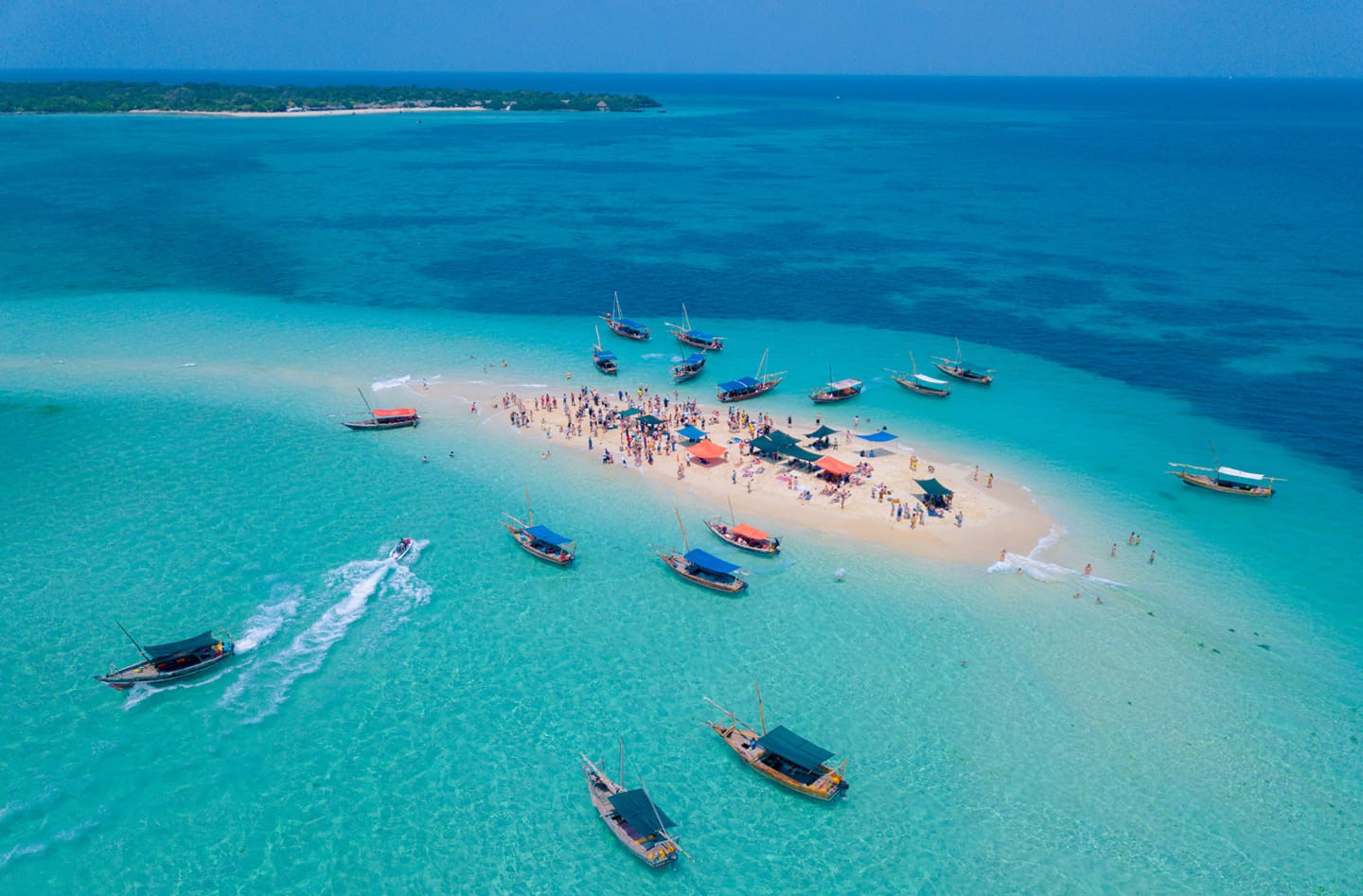
Safari Blue Tour Zanzibar: Snorkeling, Sandbanks, and Seafood Delights
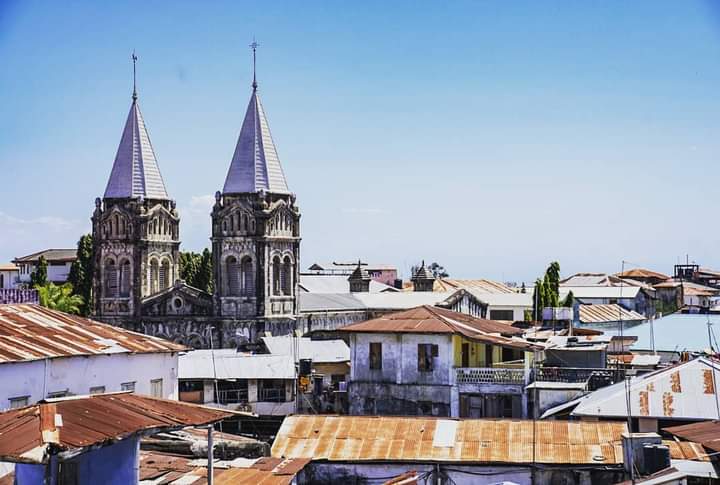
Stone Town Tour :Explore The Town’s Rich History and Culture
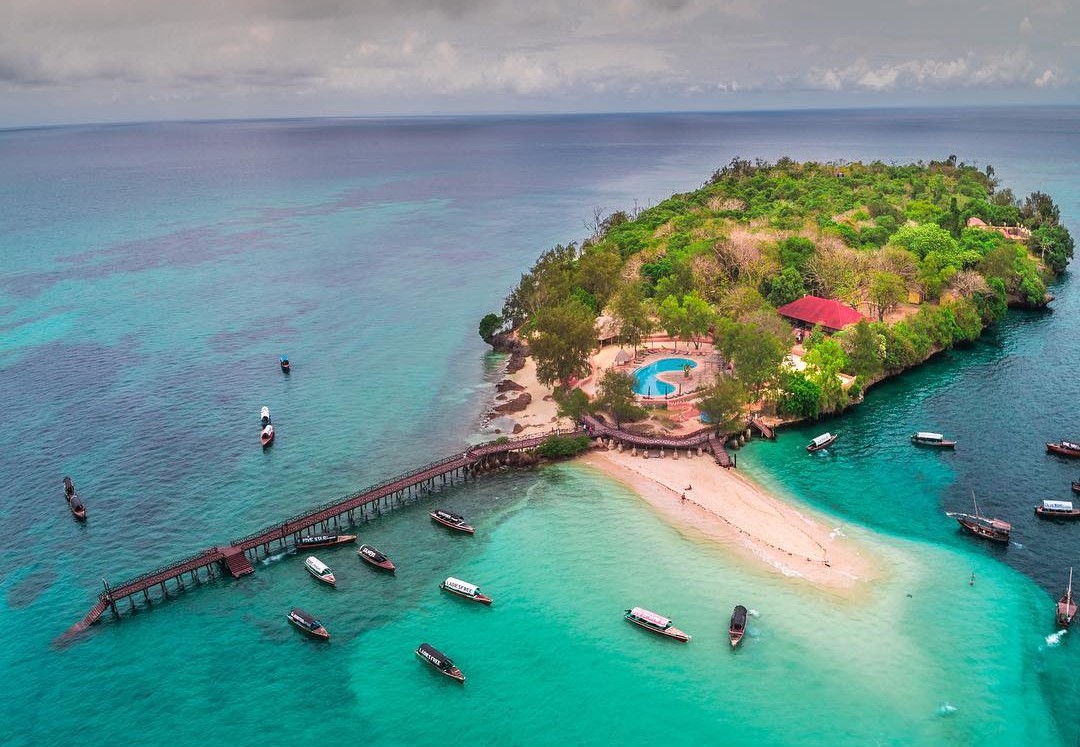
Prison Island Tour in Zanzibar: A Historical and Natural Gem in Zanzibar
What the world say about zanzibar.
Here are some international news articles discussing tourism and attractions in Zanzibar.

"Zanzibar's stunning beaches, hotels and more"
Nungwi’s expansive coastline is wide open for swimming and snorkeling in some of Africa’s most pristine, reef-rich waters.

"Zanzibar, an island of magic"
The Guardian
The spice island of Zanzibar offers dramatic beaches, a Unesco world heritage old town – and a chance to connect with the spirit world

Zanzibar named top travel destination in Africa
The Travel Magazine
Zanzibar has been named as a top travel destination for 2023 by Travelers Worldwide Magazine putting the Island on top of 15 best travel destinations in Africa

Kendwa Beach, Zanzibar ranked 4th best in the world, top in Africa
Big 7 Travel Magazine
Zanzibar’s Kendwa Beach has been ranked fourth best beach in the world by travel magazine Big 7 Travel in a survey that ranked White Beach, Port Barton, in the Philippines as the best destination in the world.
Life in Zanzibar
Zanzibar is a place where everyday life is an adventure, filled with culture, natural beauty, and time-honored traditions. From the vibrant markets, serene beaches, lively festivals, and tranquil villages all play a part in shaping the island's unique way of living.
Where to Shop in Zanzibar?
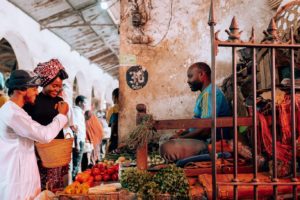
Explore the Exotic Markets of Zanzibar: From the Spice-Infused Delights of Darajani Market to the Nighttime Wonders of Forodhani Night Market
Non-hotel Vacation Rentals & Accomodation

Whether you’re seeking a luxurious beachfront retreat, a cultural immersion, or a sustainable eco-lodge, Zanzibar’s diverse options cater to every traveler’s needs
Getting Around the Island

Dala-dalas are the heart and soul of public transportation in Zanzibar. These colorful, often crowded minibuses are the most budget-friendly way to get around the island
Workation in Zanzibar

Zanzibar, the captivating island jewel in the Indian Ocean, is emerging as the ultimate destination for professionals seeking a work-life balance in an idyllic tropical setting.
Popular Blog Posts
Here, we’ve put together a collection of stories, tips, and insights, all crafted to explore the beautiful Zanzibar Islands
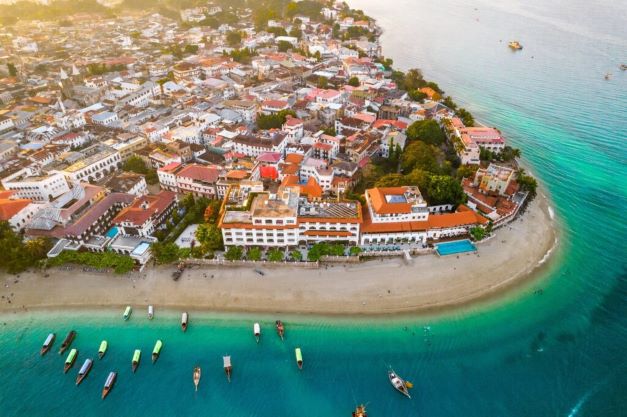
Stone Town: A Glimpse into a Bygone Era of Timeless Beauty and Cultural Riches
UNESCO World Heritage Site, Stone Town offers a glimpse into a bygone era and immerses visitors in a world of timeless beauty and cultural riches
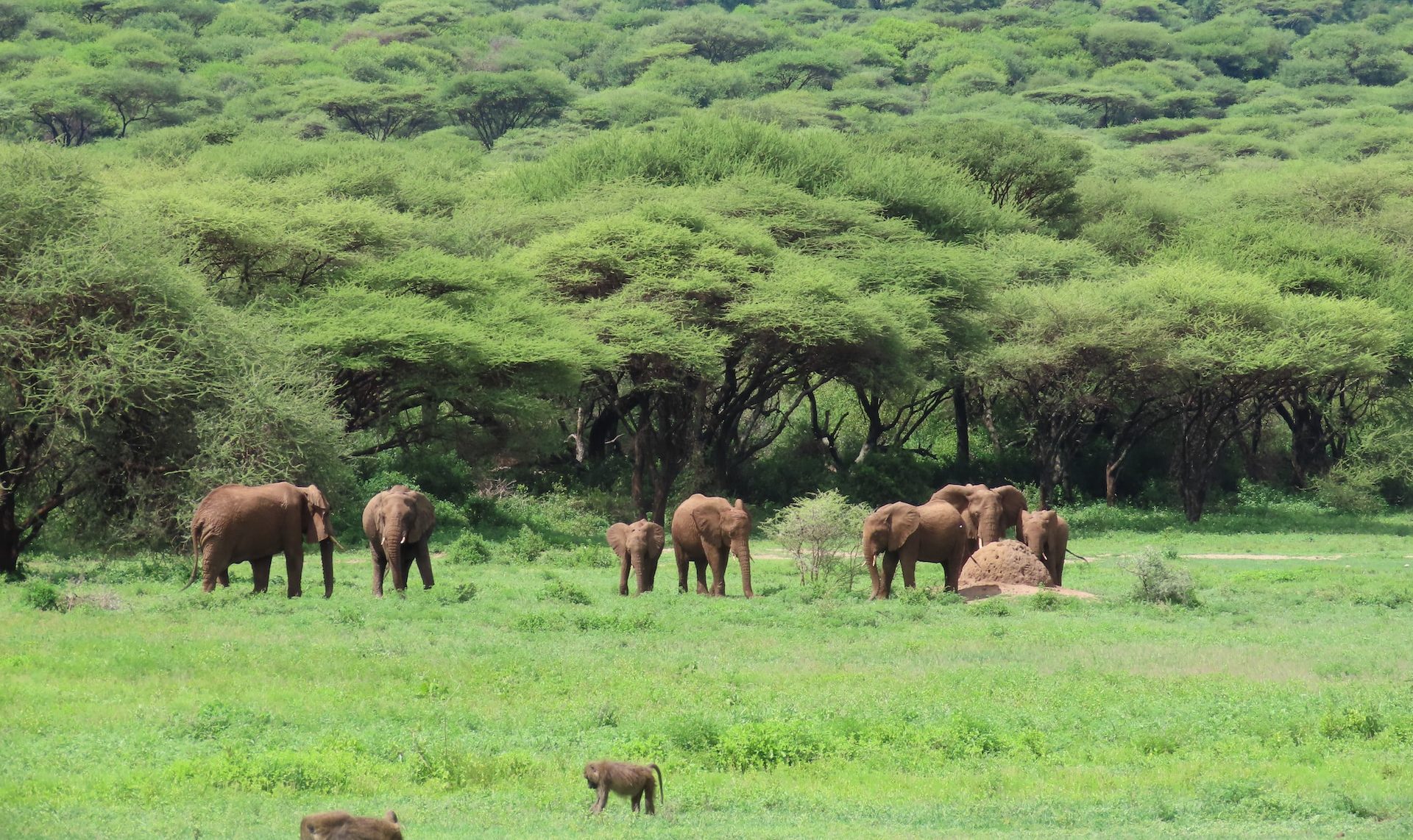
Beaches and Beasts: Combining Zanzibar Beaches with Thrilling Tanzania Safaris
Get ready to immerse yourself in the unparalleled beauty of Zanzibar’s beaches and the untamed wilderness of Tanzania’s safaris.
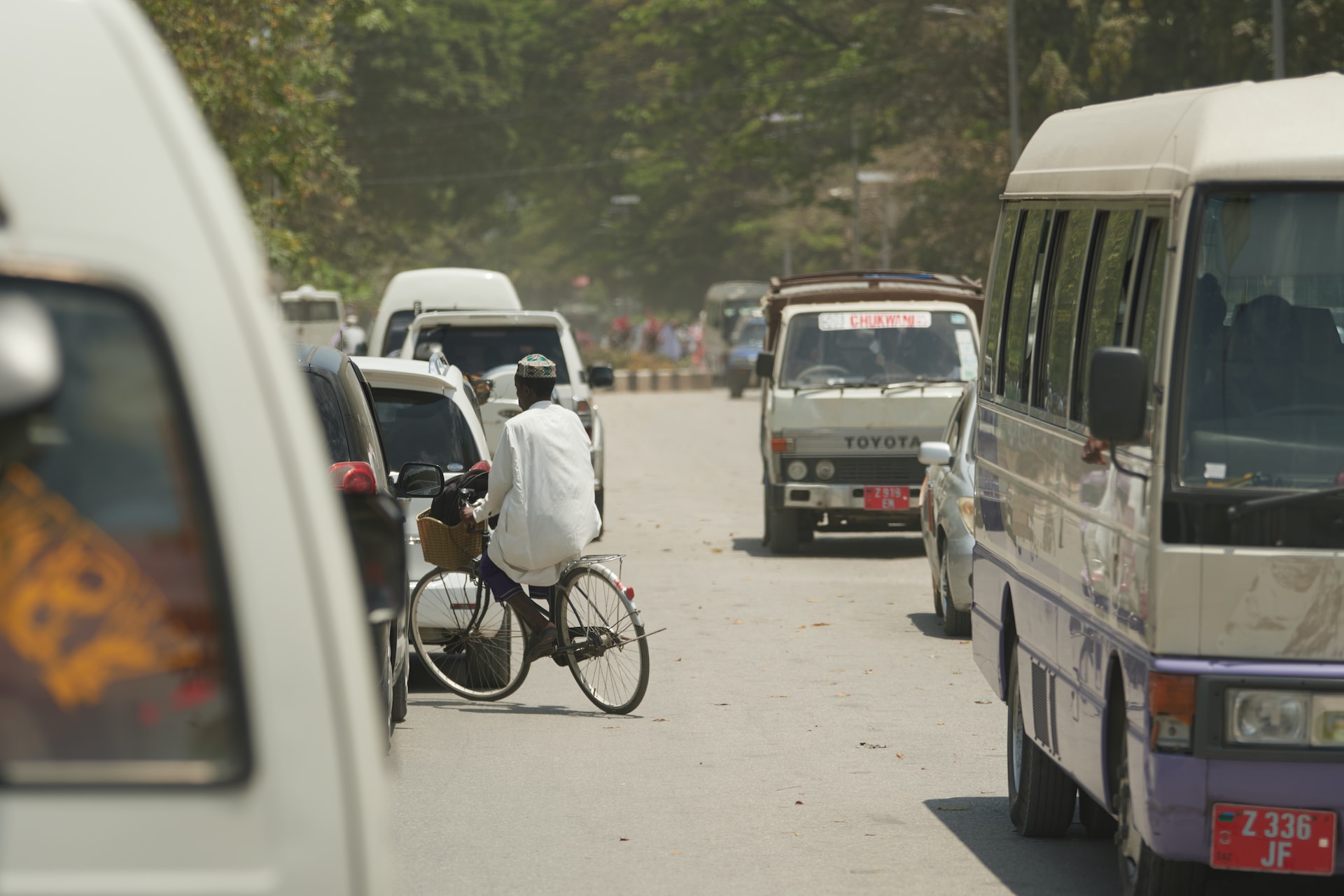
Navigating Zanzibar: Your Guide to Getting Around the Island
A comprehensive guide to transportation options on this tropical paradise.
Don't Know What To Start With?
Get a solutions for all travel services, head office.
With a strong network of partners in Zanzibar, we strive to enhance our clients' travel experiences and remain at the forefront of the industry.
Email: [email protected]
Request Consultation
Get expert advice.
Click one of our contacts below to chat on WhatsApp

Social Chat is free, download and try it now here!
Zanzibar Tours & Holidays

With endless golden beaches, crystalline blue waters and tantalising spice plantations – Zanzibar is a feast for the senses.
The island of Zanzibar may be small, but there are many ways to get lost here: amongst the ancient, cobble-stoned streets of Stone Town; in the colourful history of the people that call this paradise home; or amid the coral reefs that rival the best snorkelling destinations in the world. Take your pick, but after a day in this hidden paradise, we can promise you won’t want to be found!
Tours to Zanzibar
Let's create an exclusive trip for your group.
Tours from Zanzibar
Zanzibar highlights, zanzibar tour reviews.
Filter by rating
Road to Zanzibar
Vic Falls to Kenya
Kenya to Cape Town
Cape Town to Kenya
Articles of Zanzibar
The top 7 destinations for travel in February 2024
10 delicious dishes you should definitely eat in Zanzibar
Since when is Mt Kilimanjaro in Kenya? 5 wildly inaccurate misconceptions about Tanzania
7 reasons why your next adventure should be in Tanzania
Island time: why beautiful Zanzibar deserves your attention
Life’s a beach: why are we so drawn to the ocean?
Zanzibar at a glance
Capital city.
Zanzibar City
Swahili, English, Arabic
(GMT+03:00) Zanzibar City
CALLING CODE
Electricity.
Type D (Old British 3-pin) and Type G (Irish/British 3-pin)
Learn more about Zanzibar
Culture and customs.
The Zanzibar archipelago is an eclectic melting pot of cultures, customs and religions. Within the streets of Stone Town, you’ll find mosques and churches standing literally side by side. While Zanzibar is a primarily Muslim region, it shares a history of cultural influences that spread as far wide as the Middle East, India and ancient Persia. Previously a protectorate of Britain and officially a part of Tanzania since 1964, the archipelago has a long history of bureaucratic changes and tensions.
Currently, the population of Zanzibar is largely divided. Many still champion for independence from Tanzania and seek to have Zanzibar declared its own country. Despite their political differences, the discussion remains respectful between the locals. You are just as likely to see them passionately debating politics in town centers as you are to see tropical fruit farmers hawking their produce roadside all around the islands. But one thing everyone in Zanzibar has in common is their love of soccer. Head to any beach in the late afternoon and you are almost guaranteed to witness the locals coming together for a friendly game of beach soccer.
Eating and drinking
The variety of food in Zanzibar rivals anywhere in the world. It owes this entirely to its geography: being at the crossroads of ancient trade routes, the locals have picked up a thing or two about worldly cuisines. Whether it is yam and plantain-based dishes from the Bantu peoples of Eastern Africa, Indian inspired masala curries featuring many of the spices the island is famous for, or the sweet date and hazelnut bread is traditionally eaten to celebrate the end of Ramadan – you will be spoiled for choices to fill your plate! Unsurprisingly for an island, seafood takes pride of place in Zanzibar and seafood lovers will rejoice at the wide range of dishes available at restaurants and markets. An absolute must for anyone visiting Stone Town is the Forodhani night market. As soon as the sun sets each night, beachside Forodhani Park transforms into an open-air food market filled will vendors tempting you to try their dishes. Our pick is the Zanzibar pizza – filled with whatever fresh ingredients take your fancy at the time. Wash it all down with fresh coconut juice (direct from the coconut of course!)
Perhaps the most famous export from Zanzibar is its spices, including pepper, cinnamon and ginger to name a few. Visit a spice plantation to sample countless types of spices directly from the source. Don’t forget to pick up a selection from the local markets before you leave.
Zanzibar has a large Muslim population, so bear in mind that Ramadan is the fasting month for all Muslims. During this month, no food, drink or smoking is permitted during daylight hours. While non-Muslims aren't expected to fast, it's recommended to try to avoid eating, drinking or smoking in public during daylight hours.
Must-try foods in Zanzibar:
1. pweza wa nazi.
Octopus boiled in coconut milk to create a curry-based dish with cinnamon, cardamom, garlic and lime juice.
2. Barbecued lobster
Enjoy a lobster grilled to perfection at one of the many beachside eateries around the island.
3. Spice cake
A typical local dessert made using pastry with a mix of cinnamon, clove, nutmeg and chocolate.
Geography and Environment
Zanzibar is an island province of Tanzania located off the coast of East Africa. Surrounded by the Indian Ocean on all fronts, it is covered mostly in lush rainforest and encircled by white beaches and coral reefs.
Zanzibar is actually an archipelago made up of many small islands and two prominent, main ones: Pemba Island and Unguja Island – the largest, often mistaken as ‘Zanzibar Island’, where the majority of the province’s population lives.
While there are various swanky stores in main hubs like Stone Town, specialising inexpensive trinkets and homewares, you simply can’t visit Zanzibar and not take an afternoon stroll through one of its lively, colourful markets. Lose yourself amongst the hustle of Darajini market in Stone Town, where you will find stores piled high with spices, vegetables, fabrics and dried snacks. The market is so jam-packed, stores often spill out into the tiny laneways nearby.
Things to buy in Zanzibar
Don’t leave the island without purchasing a selection of the many spices still grown on plantations today. Pepper, cinnamon, ginger and nutmeg are among the islands’ specialities. But you can find almost every type of spice imaginable here!
2. Woven handicrafts
Pick up a handmade ukili bag, placemat, rug or even a sun hat. The locals have perfected this handicraft and are widely available throughout Zanzibar. A great way to support local initiatives and talent.
Festivals and events
Festival of the dhow countries .
The highlight of the Zanzibar International Film Festival, the Festival of the Dhow Countries is a cultural celebration of international film, music, theatre and performing arts. One of the biggest annual cultural festivals in Africa, it takes place over the first two weeks of July. Film screenings, exhibitions and craft classes are on offer during the day, while at night beach parties are a fun way to interact with locals.
Sauti Za Busara Festival
If you are lucky enough to visit Stone Town in early February you’ll be treated to a hypnotising swell of Swahili music and dance during this vibrant celebration of East African culture. The festival concludes with a beachside festival of crafts, cuisine and entertainment.
Further Reading
Zanzibar travel faqs, do i need a covid-19 vaccine to join an intrepid trip.
Trips from 1 January 2023 onwards
From 1 January 2023, Intrepid will no longer require travellers to provide proof of vaccination against COVID-19 (excluding all Polar trips and select adventure cruises).
However, we continue to strongly recommend that all Intrepid travellers and leaders get vaccinated to protect themselves and others.
Specific proof of testing or vaccination may still be required by your destination or airline. Please ensure you check travel and entry requirements carefully.
Is tipping customary in Zanzibar?
Tipping isn’t mandatory in Zanzibar but a little generosity will be received positively, especially when considering the low wages that service workers are typically paid in Zanzibar.
Setting aside a small amount for porters, guides and drivers is wise, as is leaving spare change or rounding up the bill at restaurants.
What is the internet access like in Zanzibar?
Internet access is widespread throughout the main islands of Zanzibar. However, if visiting smaller islands there will be limited to no access available.
What are the toilets like in Zanzibar?
Western-style flushable toilets are generally available in most hotels, tourist attractions and other modern buildings in Zanzibar.
I n rural areas squat/pit toilets are the general standard for local amenities.
Carry your own supply of soap and toilet paper as these are rarely provided.
Can I drink the water in Zanzibar?
Drinking tap water isn't recommended in Zanzibar.
For environmental reasons, try to avoid buying bottled water. Instead, fill a reusable water bottle or canteen with filtered water.
Ask your leader where filtered water can be found; some hotels we stay in may have drinking water available.
It's also advisable to avoid ice in drinks and peel fruit and vegetables before eating.
Are credit cards widely accepted in Zanzibar?
Credit cards are usually accepted by large hotels and Western-style restaurants but not by smaller vendors.
Ensure you have adequate cash to cover purchases not able to be made on credit.
What is ATM access like in Zanzibar?
ATMs are easily found in urban centers such as Stone Town but are rarer in rural areas and villages.
Be sure to have other payment methods available when venturing out of the built up areas as ATMs aren't always an option.
Is Zanzibar a safe destination for LGBTQIA+ travellers?
Tanzania is a conservative country and homosexuality is still officially illegal, including in Zanzibar. While prosecutions might be rare, penalties can be severe with potential imprisonment as punishment.
For this reason, public displays of affection (even between members of the opposite sex) is considered taboo and not advised.
For more detailed and up-to-date advice, we recommend visiting Equaldex or Smartraveller before you travel.
Do I need a visa to travel to Tanzania?
TANZANIA: Australia: Yes - Visa required Belgium: Yes - Visa required Canada: Yes - Visa required Germany: Yes - Visa required Ireland: Yes - Visa required Netherlands: Yes - Visa required New Zealand: Yes - Visa required South Africa: Yes - Visa required Switzerland: Yes - Visa required United Kingdom: Yes - Visa required USA: Yes - Visa required It is recommended you purchase your visa in advance at any Diplomatic or Consulate Mission of the United Republic of Tanzania abroad. The cost is approximately US$100 depending on nationality and should take 1 business day. At the present time you do not require a multi entry visa to Kenya, Tanzania and Uganda due to an agreement between the three countries (eg. if you exit Kenya to Tanzania you can re-enter Kenya on the same visa). However if your trip visits Tanzania twice after a visit to a country other than those listed above, you may need to purchase two visas. For the purpose of the visa application you can use the following address: Kibo Palace Hotel PO Box 2523 Old Moshi Road Arusha - Tanzania Phone: +255 272544472 It is also possible to obtain a tourist's visa for a single entry at any one of the following main entry points to Tanzania, subject to the fulfilment of all immigration and health requirements: -Dar es Salaam International Airport -Zanzibar International Airport -Kilimanjaro International Airport (KIA) -Namanga Entry Point (Tanzania-Kenya border point) -Kasumulu Border crossing -Isebania Border crossing
This is for general information only and may be subject to change. It is your responsibility to obtain relevant visa and travel information required for entry, departure and travel to each country or region you visit on your trip. You should confirm these with the relevant embassies and/or consulates.
Last updated: 28/11/2023
Do I need to purchase travel insurance before travelling?
Absolutely. All passengers travelling with Intrepid are required to purchase travel insurance before the start of their trip. Your travel insurance details will be recorded by your leader on the first day of the trip. Due to the varying nature, availability and cost of health care around the world, travel insurance is very much an essential and necessary part of every journey.
For more information on insurance, please go to: Travel Insurance
Does my trip support The Intrepid Foundation?
Yes, all Intrepid trips support the Intrepid Foundation. Trips to this country directly support our global Intrepid Foundation partners Eden Reforestation Projects and World Bicycle Relief. Intrepid will double the impact by dollar-matching all post-trip donations made to The Intrepid Foundation.
Eden Reforestation Projects
Eden Reforestation Projects are helping to mitigate climate change by restoring forests worldwide; they also hire locally and create job opportunities within vulnerable communities. Donations from our trips support restoration across planting sites in 10 countries around the globe. Find out more or make a donation World Bicycle Relief
World Bicycle Relief provides people in low-income communities with bicycles to mobilise school kids, health workers, and farmers in far-out areas – giving them access to vital education, healthcare, and income. Donations help provide Buffalo Bicycles – specifically designed to withstand the rugged terrain and harsh environment of rural regions – to those who need them most. Find out more or make a donation

Welcome to Tanzania
Experience the unique culture and wildlife of tanzania, meet tanzania's natural treasures.
A land of tropical allure and cultural wonders, Tanzania is a destination that captivates the hearts of travelers. With its pristine beaches, rich history, and vibrant atmosphere, Tanzania offers an unforgettable experience for all who venture to its shores. Whether you seek relaxation under swaying palm trees or thrilling water activities in crystal-clear waters, Tanzania promises to be a paradise that exceeds your expectations.
Experience Tazania's Wonders
Incredible cities, stunning beaches, amazing landscapes, travel essentials.

Travel guide

Visa & Requirements

Travel tips
Visit stone town, jozani forest, serengeti national park, forodhani gardens, prision island, #visittanzania - share your story, travel authorization.
Stay in Tanzania for up to 3 months at a time.
Enjoy a holidays, visit your family or friends or cruise, or attend a cultural event.
Study or train for up to 3 months in total.
Requirements:
No Covid-19 vaccination certificate or negative PCR test result is required anymore.
- Flight ticket (round trip).

Visa-exempt countries
Tips before going.

Visitzanzibar.travel is a comprehensive tourism portal and advisor for Tanzania, designed to provide travelers with all the information they need to plan a perfect trip to the country. The website offers a wealth of information on Tanzania culture, history, attractions, and activities, as well as practical tips on visa requirements, transportation, and accommodations. Visitzanzibar.travel is dedicated to promoting tourism in Tanzania and showcasing the best the country has to offer. With expert advice and insider tips, Visitzanzibar.travel is the ultimate guide for anyone planning to visit Tanzania.
Learn more:
Disclaimer: Visitzanzibar.travel is an independent travel advisor and is not affiliated with or endorsed by any government agency or organization. We provide travel assistance services to individuals who are planning to travel to Tanzania. Our services are designed to help travelers navigate the complex travel requirements and procedures, and our team of experienced professionals provides personalized support to ensure that travelers have a seamless and hassle-free travel experience. Please note that Visitzanzibar.travel is not a substitute for official government resources or processes, and we strongly advise travelers to refer to the relevant government websites and resources for the most up-to-date and accurate information.

Is it safe to travel to Iceland? Volcano erupts again, forcing UK Foreign Office to issue advice
A volcanic eruption in south-west Iceland has triggered the evacuation of the country’s biggest attraction, the Blue Lagoon geothermal spa.
The eruption began in the early afternoon on Wednesday (May 29) following several earthquakes north of Grindavik, a coastal town of 3,800 people that was also evacuated.
The Icelandic Meteorological Office (IMO) said lava shot about 50 metres (165 feet) into the sky from a fissure about one kilometre (1,100 yards) long.
The Blue Lagoon spa was evacuated before the volcano erupted.
To prevent further damage, man-made barriers have been built to steer lava away from infrastructure including the Svartsengi geothermal power plant, the spa, and Grindavik.
The latest eruption was the fifth in the Reykjanes peninsula since December 2023.
It came after scientists warned eruptions could happen continually in the peninsula for decades or centuries.
Until March 2021, the peninsula had not experienced an eruption for eight centuries.
Iceland has 33 active volcano systems, the highest number in Europe.
Is it safe to travel to Iceland?
Euronews reported that despite concerns over how the eruption will affect travel, nearby Keflavik Airport remained operational on Thursday. Icelandic airport operator ISAVIA advises passengers to monitor flight information here .
The capital Reykjavik and the rest of Iceland are not affected.
Travellers are advised to stay away from Grindavik.
The Blue Lagoon has been closed.
“Due to a volcanic eruption that commenced in Sundhnúksgígar on May 29, we took the precautionary measure of evacuating and temporarily closing all our operational units,” the attraction’s website said . “We have made the decision to extend the closure until May 31, at which time the situation will be reassessed.”
It said all customers with bookings for affected dates would be contacted.
What has the UK’s Foreign Office said?
The Foreign, Commonwealth and Development Office has not listed Iceland as a country Britons should avoid.
However, it said: “Volcanic eruptions and earthquakes are common in Iceland. Recently there has been a series of volcanic eruptions on the Reykjanes peninsula in south-west Iceland, the latest on 29 May. These have affected the town of Grindavik and the area to the north of it.
“Stay away from this area. All roads to Grindavik and the surrounding area are closed.
“The likelihood of further eruptions in this location remains high. Check local media for updates and follow the Iceland authorities’ advice on travel to the area”
It advised prospective travellers to check the following websites: Icelandic Met Office , Safe Travel Iceland , and the Almannavarnir page on X (formerly Twitter) .
Is the volcano in Iceland still erupting?
After the initial eruption, volcanic activity was still ongoing at the time of writing.
Register now for one of the Evening Standard’s newsletters. From a daily news briefing to Homes & Property insights, plus lifestyle, going out, offers and more. For the best stories in your inbox, click here .

Cookies on GOV.UK
We use some essential cookies to make this website work.
We’d like to set additional cookies to understand how you use GOV.UK, remember your settings and improve government services.
We also use cookies set by other sites to help us deliver content from their services.
You have accepted additional cookies. You can change your cookie settings at any time.
You have rejected additional cookies. You can change your cookie settings at any time.
Register to vote Register by 18 June to vote in the General Election on 4 July.
- Passports, travel and living abroad
- Travel abroad
- Foreign travel advice
Antarctica/British Antarctic Territory
Warnings and insurance.
The British Antarctic Territory is a British Overseas Territory. It is administered by a commissioner, based in London. The British Antarctic Territory website has more information.
Before you travel
No travel can be guaranteed safe. Read all the advice in this guide and any specific travel advice that applies to you:
- women travellers
- disabled travellers
- LGBT+ travellers
- solo and independent travel
- volunteering and adventure travel
Travel insurance
If you choose to travel, research your destinations and get appropriate travel insurance . Insurance should cover your itinerary, planned activities and expenses in an emergency.
About FCDO travel advice
The Foreign, Commonwealth & Development Office ( FCDO ) provides advice about risks of travel to help British nationals make informed decisions. Find out more about FCDO travel advice .
Follow and contact FCDO travel on Twitter , Facebook and Instagram . You can also sign up to get email notifications when this advice is updated.
Related content
Is this page useful.
- Yes this page is useful
- No this page is not useful
Help us improve GOV.UK
Don’t include personal or financial information like your National Insurance number or credit card details.
To help us improve GOV.UK, we’d like to know more about your visit today. Please fill in this survey (opens in a new tab) .

IMAGES
COMMENTS
FCDO travel advice for Tanzania. Includes safety and security, insurance, entry requirements and legal differences.
The mercury on Zanzibar rarely dips below 25°C. In fact, the temperature averages from 28 to 30°C all year round. January and February make up the dry season, then the 'long rains' are known to hit Zanzibar from March to May. The rest of the year sees searing sunshine until November and December, when the heat is broken up with refreshing ...
As Zanzibar is part of Tanzania, it is subject to the same visa and entry requirements of the mainland. For most Western travelers, you will need a visa to enter Zanzibar/Tanzania. The entry visa can be: Purchased on arrival at the airport. The cost of this is $50 for every nationality besides the US which is $100.
Here are a few Zanzibar travel tips that are good to know before you visit the island. Zanzibar Travel - Top Tours and Excursions. Luxury: The classic Tanzanian bush & beach safari. Mid Range: Best of Northern Parks and Zanzibar. Spice Farm Tour with Traditional Cooking Lesson. North Coast and Turtle Sanctuary Tour.
Foreign travel advice. Get advice about travelling abroad, including the latest information on coronavirus, safety and security, entry requirements and travel warnings. Search for a country or ...
Check the latest government guidance on the FCDO Foreign travel advice and country specific pages for travel to this country and the rules for entering the UK on return. Ensure you are up to date with UK recommendations on COVID-19 vaccination. Check if you are at increased risk of severe COVID-19. You can check this in the FAQ's.
Travellers should always check the UK Foreign, Commonwealth & Development Office (FCDO) travel advice and their country-specific pages for the latest COVID-19 travel advisories which may include information on travel restrictions, quarantine, COVID-19 testing or vaccination requirements. This includes considering the recommendations and ...
Darren Humphreys. Published on March 12, 2021. Zanzibar, an island off the coast of Tanzania in East Africa, is a unique crossroad of cultures. Disparate influences, like Swahili, Arabian ...
Start planning your idyllic beach holiday to Zanzibar with our top travel tips that cover health advice, food, shopping and bargaining, and plenty more. ... Zanzibar Pre-travel Health Advice Zanzibar Drinking Water Zanzibar Food and eating out Zanzibar Tipping Etiquette Zanzibar Shopping and Bargaining Zanzibar Solo travel for ... London W6 8DA ...
Chris and Susie McIntyre, authors of Zanzibar: The Bradt Guide. Zanzibar is one of our hot destinations for the year ahead - check out the full list of the best places to travel in 2024 here. Zanzibar is a magical, evocative African name, like Timbuktu, Casablanca or Kilimanjaro. For many travellers, the name alone is reason enough to come.
Welcome to the exotic Zanzibar Archipelago, a tropical paradise nestled in the Indian Ocean off the coast of East Africa. Mallerby's Luxury Travel is thrilled to present this comprehensive Zanzibar Travel Guide, offering you insights into the enchanting islands and captivating atolls that make this a dream destination for discerning ...
Top 5 Reasons to Visit Zanzibar. 1. The Perfect Tropical Beach Experience. You have your choice of several stunning beaches with fine, coral white sand, and brilliant blue waters on Zanzibar Island alone. The area around Nungwi and Kendwa at the northernmost tip of the island includes an idyllic, wide beach.
For general information on travelling to Tanzania, visit our Tanzania travel advice page. Top Travel Tips for Zanzibar. Yellow Fever: it is not a requirement to have the yellow fever vaccination when visiting Zanzibar, except in cases of travellers visiting Zanzibar from another country that is listed as a high-risk destination or having spent 12 hours in transit within a high-risk destination.
The shortest war in history took place in Zanzibar - it was between the UK and Zanzibar and lasted 38 minutes. Freddie Mercury, late frontman for the band Queen, was born in Zanzibar and lived there until he was a teenager. ... Zanzibar Travel Advice. We stay well informed of current travel guidance for Zanzibar and follow advice as set out by ...
She has spent over 12 years travelling the world, sharing in-depth advice from more than 100 countries across six continents. Lauren's travel advice has been featured in publications like the BBC, Wall Street Journal, USA Today, and Cosmopolitan, and her work is read by 200,000 readers each month.
The Telegraph's Tanzania travel guide features expert advice on the best hotels, things to see and do, restaurants and bars in destination including Zanzibar, Nyerere National Park and the ...
Get Free Travel Advice, Exclusive Deals, and Discounts in Your Inbox. Name * Email * SIGNUP. 47434. Paradise Awaits What is Zanzibar famous for? ... Zanzibar has been named as a top travel destination for 2023 by Travelers Worldwide Magazine putting the Island on top of 15 best travel destinations in Africa.
Chumbe Island is one of the few uninhabited coral islands in the world, protected by the multi-award-winning Chumbe Island Coral Park. Other popular snorkelling areas in Zanzibar include Nungwi Beach, Kendwa Beach, and Matemwe Beach. You can see butterflyfish, parrotfish, clownfish, boxfish, lionfish, angelfish, stingrays, turtles, dolphins ...
Disclaimer: Visitzanzibar.travel is an independent travel advisor and is not affiliated with or endorsed by any government agency or organization. We provide travel assistance services to individuals who are planning to travel to Tanzania. Our services are designed to help travelers navigate the complex travel requirements and procedures, and our team of experienced professionals provides ...
Find out about the top things to do in Zanzibar. Whatever you're looking for in a holiday to Zanzibar, there are plenty of activities. At TUI we 'cross the 'T's, dot the 'I's, and put 'U' in the middle'. ... See gov.uk/foreign-travel-advice - for FCDO travel advice about individual destinations.
Story by William Mata and Lola Christina Alao. 1d • 2 min read. Is it safe to travel to Iceland? Volcano erupts again, forcing UK Foreign Office to issue advice - The eruption began in the early ...
Still current at: 29 May 2024. Updated: 6 March 2024. Latest update: This travel advice has been rewritten to make it easier to read and understand. The British Antarctic Territory is a British ...
TfL is advising customers to check before they travel as London hosts the Champions League Final on Saturday 1 June. Public transport is expected to be very busy on Saturday, particularly the Jubilee and Metropolitan lines and customers are advised to seek alternative routes. Stations on these lines may be subject to short-term safety measures ...
The Zanzibar Archipelago's sat off the eastern coast of Africa, 20 miles into the Indian Ocean from mainland Tanzania. A lot of people think Zanzibar's one big tropical island, but there are actually more than 40 spread throughout the entire archipelago. Here, island hopping's not just a holiday pastime, it's a way of life.